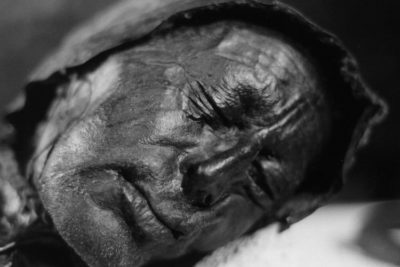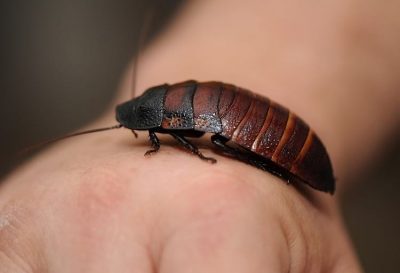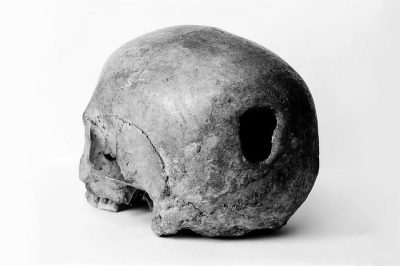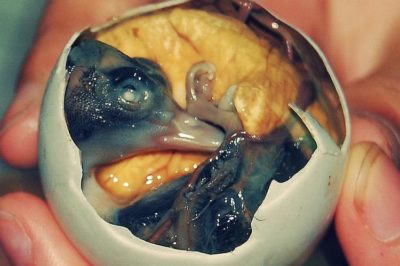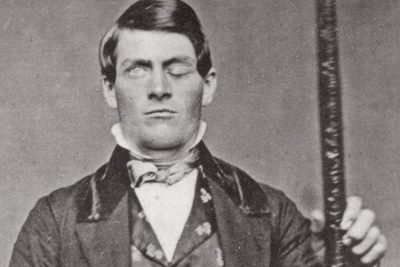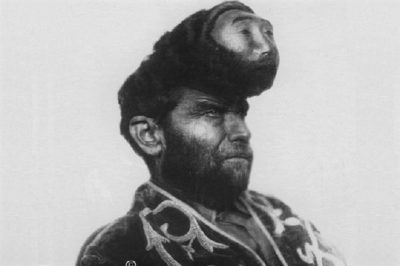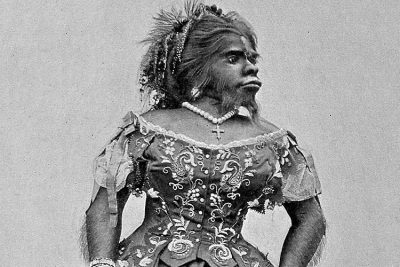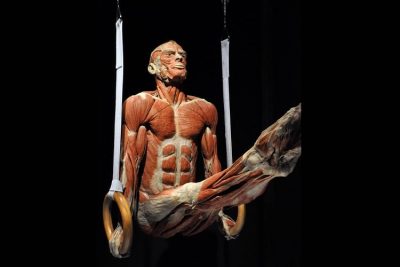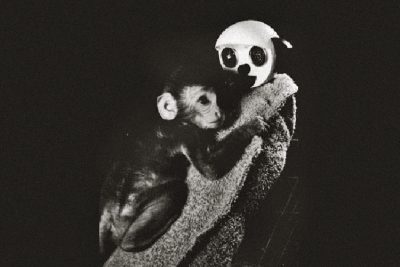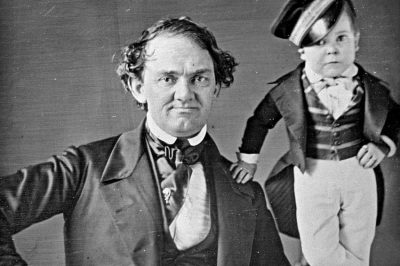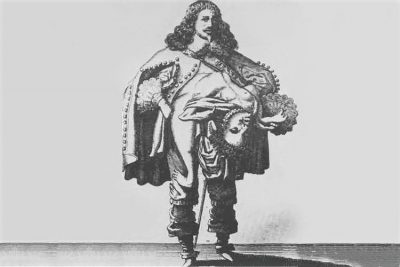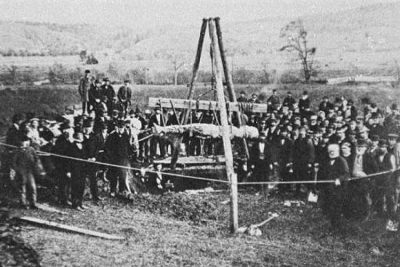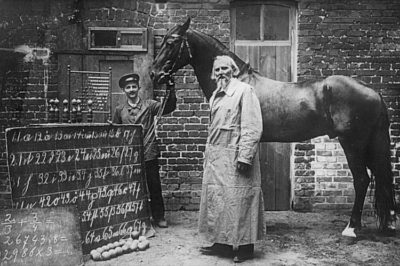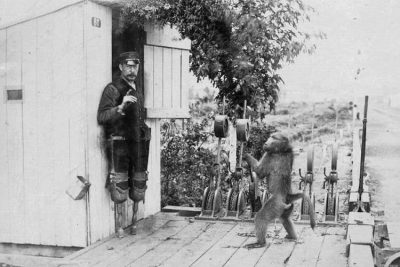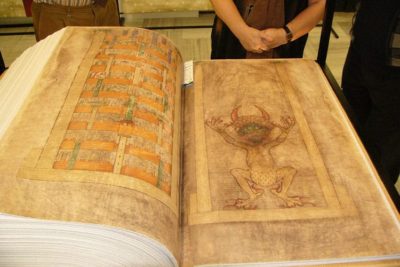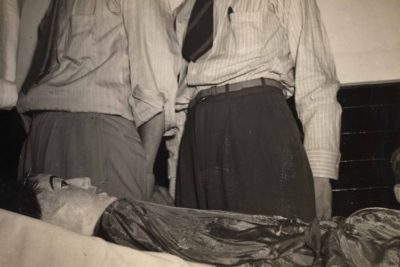The post Was Atomic Energy Kit the Most Dangerous Toy Ever Made? appeared first on .
]]>
An original Gilbert U-238 Atomic Energy Laboratory kit. The upper left section contains four jars of radioactive samples. (Webms / Wikimedia Commons)
The Atomic Energy Lab Kit or Gilbert U-238 Atomic Energy Lab was the name of the gadget released in 1950. The toy came in an enticing red box similar to the mythic board-game Jumanji but yet held actual, physical danger because the incredible fact about the Atomic Energy Lab Kit is it had actual sources of radiation including Uranium Ores inside. In this period the dangers of radiation were not yet studied, but can you believe a children’s toy held radiation? The toy was pricey at around $50, which in today’s money is over $520.
A. C. Gilbert had previous success with a metal toy construction set called ‘Erector’ which was like Lego but more like Meccano.

Advertisement for Erector Set, circa 1922. (Popular Science Magazine)

The Erector set. (Cullen328/Wikimedia Commons)
Read more: The 19th Century Mechanical Toy—The Creeping Baby Doll
Inside the box of Gilbert U-238 Atomic Energy Lab
An instruction manual, a comic book titled ‘How Dagwood Splits the Atom and a booklet Prospecting for Uranium’ outlined instructions on how to find Uranium. A Geiger counter made it possible to observe Uranium by using a gas-filled tube of inert gas to show particle collisions. A Wilson cloud chamber allowed the gamer to see vapour trails escape from particles.

An assembled Gilbert cloud chamber. (Science History Institute)
A spinthariscope was also included to show scintillation owning to alpha decay. An electroscope was another instrument to measure ionization radiation of the radioactive sources. This was found in alpha, beta or gamma sources, or Uranium ones. Ultimately, owners could source natural Uranium with the kit, for which the US government offered rewards.
The end of the Atomic Age
The toy did not sell well, but this was not due to the dangers of radiation, which were not discovered until later. Only 5,000 units of the toy were made before they discontinued it cited as being too expensive to produce. By the 1970s nuclear power had diminished after notable disasters such as the infamous Chernobyl accident in 1986. Such a toy would not be permitted today in most countries, as while the low radiation emitted would unlikely prove threatening, using it every day could cause problems.
For more unusual stories & intriguing news follow STSTW Media on Instagram and Facebook. Also, join our live chat discussion on Twitter.
Do you have a story/photo for us?
We welcome your contribution at [email protected]. Please include your name, city, state, and country.
Fact Analysis:
STSTW Media strives to deliver accurate information through careful research. However, things can go wrong. If you find the above article inaccurate or biased, please let us know at [email protected].
RELATED
The post Was Atomic Energy Kit the Most Dangerous Toy Ever Made? appeared first on .
]]>The post Drinking a Glass of Wine Laced With Snake Blood & Beating Heart of a Freshly Killed Snake appeared first on .
]]>
Snake wine. (Jacek Karczmarczyk/Wikimedia Commons)
Man’s tryst with snakes is as old as 10,000 BCE. Be it in the form of mortal fear, awe, astonishment, or curiosity. That which doesn’t kill us makes us strong, said Friedrich Nietzsche. A serpent with all wherewithal to kill is served to you as a drink. But does it make you strong?
Caters to man’s craving for bizarre
There is a growing concern, worldwide, to conserve wildlife, including endangered snakes. Yet the wild and weird fascinates man in his never-ending search for health and vigour. Wine/alcohol, seasoned with snake flesh, is one of such fascinations. Taking it is justified on the grounds of medicinal properties and a unique flavour.
Hyped as tonic and miracle drug
Like placebo effect of a fake drug, notions and myths about snake wine fuel its market demand. It is touted as a cure for rheumatism, migraine, sciatica and many other ailments. It is also passed as an aphrodisiac – a sexual stimulant. Wildlife being a potential source of disease to humans doesn’t seem to be an issue. The lovers of snake wine go for it, even illegally, come what may.
Made by dropping a snake in alcohol
The procedure to make snake wine is simple. A snake is placed into a glass or china jar filled with rice wine. The snake may be dead or alive. For 5 kg of wine, half a kg of snake flesh used. The snake may be dead or alive. For 5 kg of wine, half a kg of snake flesh is required. The jar is then sealed and stored. Wine is ready in two months’ time. If stored longer, it matures to a better finish.
Another way is a short cut; doesn’t require marinating the snake body. Blood, bile or beating heart of a freshly killed snake is put into a ready-to-drink glass of wine or alcohol. Taken as a one-shot, this is another way to get high on snake spirit.

Other reptiles and arachnids are also used to prepare snake wine. (Kiran Jonnalagadda/Flickr)
Non-poisonous preferred over poisonous species
Poisonous snakes; their flesh, and the poison, are used in traditional Chinese medicine. It is argued that the alcohol content of wine neutralizes poison and makes it safe for the consumer. Yet, it is advisable to use non-poisonous snakes for winemaking. There have been instances of snakes raising the head and biting the unsuspecting handler of the wine jar. Additionally, poisonous snakes are just about 7% of the snake population, and King Cobra is already taken in the IUCN’s red list of threatened species, hence the use of non-poisonous snakes is recommended.

King cobra wine. (Khương Việt Hà/Wikimedia Commons)
Inimical to the welfare of snakes
Even as the killing of snakes is decried world over, snake wine isn’t. It sells well globally and it is here to stay. Till a better sense prevails, and snakes are spared the commercial use they are put to. That alone would signify well for the health of the eco-systems on earth.
For more unusual stories & intriguing news follow STSTW Media on Instagram and Facebook. Also, join our live chat discussion on Twitter.
Do you have a story/photo for us?
We welcome your contribution at [email protected]. Please include your name, city, state, and country.
Fact Analysis:
STSTW Media strives to deliver accurate information through careful research. However, things can go wrong. If you find the above article inaccurate or biased, please let us know at [email protected].
RELATED
The post Drinking a Glass of Wine Laced With Snake Blood & Beating Heart of a Freshly Killed Snake appeared first on .
]]>The post The Deadly Garden with Over a Hundred Different Varieties of Toxic Plants—The Poison Garden appeared first on .
]]>
The gate of The Poison Garden. (Amanda Slater/Flickr)
One might know the Alnwick Castle for the Harry Potter fame—was used as a location for the famous Hogwarts school in the first two movies. But that’s not the only interesting titbit of the castle in North England, adjacent to it is the Alnwick Garden. It is over 12 acres of land and attracts around 600,000 visitors annually. While in most of the gardens, visitors may be allowed to pluck flowers, here they are prohibited from tasting, touching or even smelling any plant or flower. One might wonder why? The reason lies beyond the iron gates; these gates lead to the Poison Garden, that houses around 100 intoxicating and narcotic plants. Although it is situated in the Alnwick Garden, Poison Garden is open for guided tours only.
The foundation and transformation of the Alnwick Garden

The cascade at the centre of The Alnwick Garden. (TSP/Wikimedia Commons)
The foundation for Alnwick garden was laid back in 1750 by the first Duke of Northumberland and was later developed by his successors until it was closed in 1950 due to the shabby mess it had grown to be. And it remained in those desperate conditions until the 12th Duke and Duchess of Northumberland moved into the castle and the Duchess, Jane Percy, took it upon herself to revamp and redevelop the Alnwick Garden in 1997. She hired Belgian landscape artists Jacques and Peter Wirtz to redo the garden. The garden went under direly needed transformation for four years and was opened to the public in 2001. The transformation took place in phases, and the Poison Garden was completed only in 2005.

The Poison Garden has around 100 toxic, intoxicating, and narcotic plants. (Graeme/Flickr)

Cannabis sativa. (madraban/Flickr)
The idea for the Poison Garden was inspired from the Duchess’ trip to the infamous Medici Poison Garden in Florence, Italy. And it was further cemented by her visit to the largest hospital in medieval Scotland wherein soporific sponges soaked in opium, hemlock and other plant herbs were used to anaesthetize amputees during 15th century surgeries. This reinforced the idea of a Poison Garden with a mission to attract children and to educate them on drug usage.
Plant varieties in the Poison Garden
The Poison Garden has over a hundred different varieties of toxic plants that have been collected from all over the world and replanted there. Strychnos Nux-vomica, a plant native to India, found its place in the garden. Strychnos is a source of alkaloid pesticide strychnine which results in muscular convulsion and even death. The pesticide is present in its bark, seeds and fruits.
Another plant that is exhibited in the garden is the Hemlock plant—Conium Maculatum. It contains coniine and other toxic alkaloids—found in seeds, roots and leaves, and may lead to death on inhalation of the contents. It was the contents of this plant that were used to make a poisonous beverage to kill Socrates.
Other varieties include Ricinus Communis, Foxglove, Atropa Belladonna, Brugmansia, Laburnum, etc. All these plants and trees, upon inhalation, result in intoxication-the least side effect, and visitors often faint while walking around the garden as they inhale the toxic fumes.

Ricinus communis (Castor oil plant). (Alvesgaspar/Wikimedia Commons)
Some of these cause delirium and hallucinations. The seemingly non-toxic of this bunch is the Laburnum, it is also known as a golden chain or golden rain because of the hanging yellow flowers that grow on this tree.

Laburnum or golden chain plant. (fallonrw/Pixabay)
It is predominantly seen in Europe and was grown as a common garden tree until children started falling sick by inhaling the toxic fumes from it. All parts of the tree are toxic and result in nausea, headache, vomiting, convulsions and even death through paralysis.
The Poison Garden, as infamous as it is, is a fascinating exhibit to look at and walkthrough, albeit cautiously. All the grandeur of the Alnwick Castle aside, this garden garners curiosity and interest like nothing else does.
For more unusual stories & intriguing news follow STSTW Media on Instagram and Facebook. Also, join our live chat discussion on Twitter.
Do you have a story/photo for us?
We welcome your contribution at [email protected]. Please include your name, city, state, and country.
Fact Analysis:
STSTW Media strives to deliver accurate information through careful research. However, things can go wrong. If you find the above article inaccurate or biased, please let us know at [email protected].
RELATED
The post The Deadly Garden with Over a Hundred Different Varieties of Toxic Plants—The Poison Garden appeared first on .
]]>The post The 19th Century Mechanical Toy—The Creeping Baby Doll appeared first on .
]]>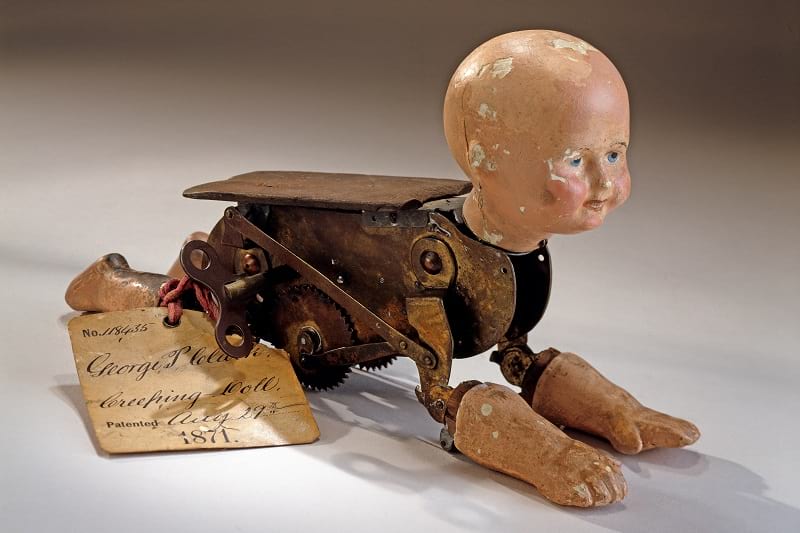
Creeping Baby Doll Patent Model at the National Museum of American History. (Smithsonian)
Toys have a great impact on babies and toddlers and their cognitive development. With amusement and play, toys help them recognize and identify texture, colours, shapes and numbers—one of the many positive effects of getting the right toys. But not all toys are amusing, one such toy is the Creeping Baby Doll by Robert J. Clay. The name is a misnomer; the toymaker didn’t mean to fright babies with the doll, but creeping in earlier days meant crawling. This Creeping (crawling) Baby Doll, Clay said, was “a very amusing toy and produced at a small cost”.
Built in the 19th Century, the objective of this toy was to imitate human life and stimulate childhood development. In the 19th Century, crawling was considered unnatural and unfit for a sane human being and was thought to be a morally suspicious act, attributed to insanity and animal life. It was later in the mid-19th Century that crawling was accepted and normalized as a natural stage of development. This toy was built in 1871 to familiarize babies and kids with the concept and to amuse them. But rarely were they amused, the targeted audience—baby girls found them unattractive and scurried far from these mechanical toys.

Creeping Baby Doll. (Smithsonian)
Read more: The Man Who Could Turn His Head Around By 180 Degrees
The patent model of the toy built by Robert J. Clay in 1871 looked forbidding and weighed more than what babies could hold and little girls could carry. This unusual, non-cuddly and non-interactive toy didn’t appeal to the audience but found its market as a novelty. The head, arms and legs of the toy were made with painted plaster; legs and arms were attached to a brass clockwork that would activate the arms and legs to imitate movements of crawling. The doll body had two hidden wheels underneath that would help in moving forward by rolling.
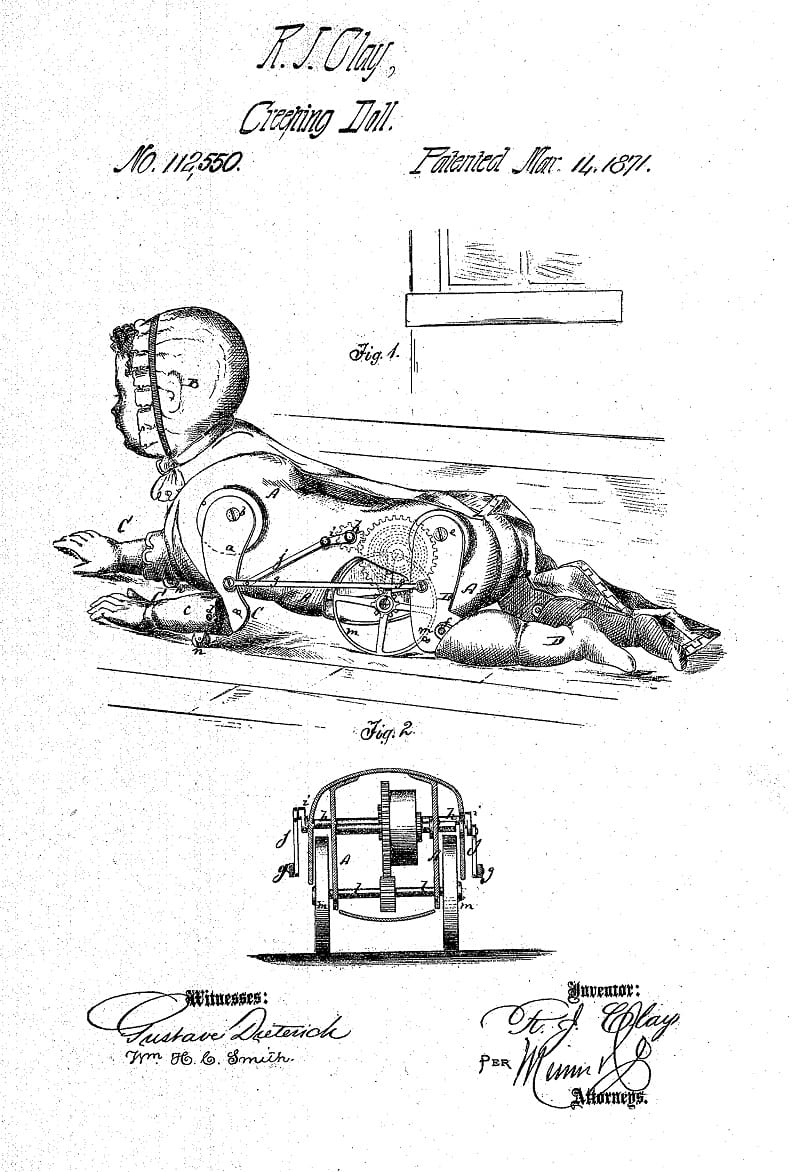
Creeping baby doll patent. (United States Patent and Trademark Office)
Robert J. Clay was granted the patent for the toy on 14th March 1871. Following this, a better and improved version of the Creeping Baby Doll was made by Clay’s employee, George P. Clarke, who received a patent for his model on 29th August 1871. In 1872, Robert J. Clay further improvised the original model and invented the Crying Creeping Baby Doll, that not only crawled but also produced sounds emulating human baby cries.
This mechanical toy, patented by George P. Clarke, is now exhibited in the Smithsonian National Museum of American History.
For more unusual stories & intriguing news follow STSTW Media on Instagram and Facebook. Also, join our live chat discussion on Twitter.
Do you have a story/photo for us?
We welcome your contribution at [email protected]. Please include your name, city, state, and country.
Fact Analysis:
STSTW Media strives to deliver accurate information through careful research. However, things can go wrong. If you find the above article inaccurate or biased, please let us know at [email protected].
RELATED
The post The 19th Century Mechanical Toy—The Creeping Baby Doll appeared first on .
]]>The post Mehran Karimi Nasseri’s 18 Years Stay at the Airport appeared first on .
]]>
Mehran Karimi Nasseri in 2005. (Saint Martin / Wikimedia Commons)
A man by the name of Mehran Karimi Nasseri, remained an accidental resident of Terminal 1 at the Charles De Gaulle International Airport between August 26, 1988 to July 2006. Nasseri’s actual intention was to head out to the United Kingdom. However, a sad mix of strange refugee laws, and the absence of documentation, left the Iranian displaced at an airport terminal for a very long time. Although Nasseri claimed to be Iranian, he also claimed that he had been exiled from Iran, having lost his Iranian citizenship over a difference in political views. It is because of this claim that he had asked for political asylum from Iran.
It is difficult to understand the advent of his story because Nasseri himself asserted different versions through time. What is undeniably obvious, however, is that for around 18 years, despite having his own assets close by, Mehran Karimi Nasseri lived in the terminal of the Paris airport.
18 years at the Parisian airport terminal
There was nothing special about Mehran Karimi Nasseri’s life before his accidental stay at the Parisian Airport. Born to a middle-class family in 1943 Iran, he had a truly average youth. At the age of 30, he travelled to the United Kingdom to complete his studies at the University of Bradford, which was roughly a 3-year stay.
Nasseri’s mother revealed to him that she was actually not his biological mother and that his biological mother was a Scottish Nurse who had an illicit affair with his father. This made him believe that he was actually a citizen of the United Kingdom and that he might as well apply for British citizenship. While this seemed easy and right out of a movie, it proved to be rather disastrous.
In 1988, Nasseri travelled to London en route from Paris. It is at this point, that Nasseri’s story gets dubious. He claimed that his required documents were in a briefcase that had been stolen when he was on a train in Paris. Consequently, when he reached Heathrow Airport in London, Passport Control deported him back to France due to his lack of documentation. He did not have a passport or a Visa, and according to the law, he was not permitted to be in the UK. On being deported to France, he encountered more trouble at Charles De Gaulle International Airport.
Since he did not have any documentation on him, he was not allowed to leave Charles De Gaulle Airport either. With such a strange event occurring, Nasseri and the people around him assumed that his stay would be extended to a few weeks at the most. Little did he know, he would end up spending 18 years of his life in that airport terminal.
He spent the next 18 years making the airport his home and stayed on a red bench that he made his personal spot. He spent his time reading books and newspapers around the various shops at the terminal. He had his luggage tucked beside him all the time and the airport provided him with basic amenities like bathroom, showers and even laundry. He lived by spending his life savings and managed to survive just fine because whatever he needed was at his disposal and always just a step away.

Mehran Karimi Nasseri in the terminal. (Docpi / Wikimedia Commons)
The terminal
After a few years passed by, a company called Dreamworks Animations made a movie about his tragic story and offered him a payroll of 250,000 dollars. The movie was named “The Terminal” which was directed by Steven Spielberg, and elicited a great response from the audience as well as critics. The movie starred Tom Hanks, Catherine Zeta-Jones, and Stanley Tucci.
Aftermath
While all seemed to work out fine, Belgium claimed to have given Nasseri citizenship 7 years into his stay at the terminal, and France had granted him a residence permit as well. Belgian law states that a refugee who left the country after being accepted could not return, thus Nasseri ended up blacklisted from Belgium. The offers from France and Belgium were refuted by him, claiming that the documents were fake and that he had been granted citizenship by the United Kingdom under the name Sir Alfred Mehran in 1981.
Nasseri’s nationality was listed as Iranian under the new papers he was assigned, which was not necessarily the only reason he refused to accept the helping hand from the other nations. Nasseri insisted and hoped that he could head back to the United Kingdom. Not only did this surprise his lawyer Christian Bourguet; a human rights lawyer, who stayed by his side for 10 years, it also surprised people around the world as to why he did not get up and leave. It would have been practical and the best alternative to staying at an airport. People naturally assumed that he had become delusional and lost his mind. Journalists from all over the world began pouring in and wanted to take interviews of the famed Nasseri, resident of Terminal 1, Charles De Gaulle Airport. Perhaps the theory about Nasseri’s delusions was somewhat true, considering altered versions of the story were told by Nasseri himself. One of the most mind boggling alterations was when he claimed to be Swedish, and also claimed that he had arrived there by a submarine.
Mehran Karimi Nasseri’s departure from terminal 1
His first departure from Charles De Gaulle Airport Terminal 1 in 2006 was not voluntary. He had fallen sick and had to be taken to the hospital because of an unknown ailment. His ailment was never disclosed to the press and he was kept for 6 months for recurring treatments. After his rather long stay at the hospital, he was moved to a hotel near the airport. This was the first time in 18 years that Nasseri had left the airport. Later in 2008, he was granted freedom by the Government of France succeeding which he stayed in the suburbs of Paris, still a homeless, and state-less, man. All the speculation would have been solved if only the thief who stole Nasseri’s passport would have been caught. Or did he truly arrive by a submarine? Perhaps we will never know for sure.
Enjoyed this article? Also, check out “Martin Laurello: The Astounding ‘Human Owl’ Who Could Turn His Head Around By 180 Degrees“.
For more unusual stories & intriguing news follow STSTW Media on Instagram and Facebook. Also, join our live chat discussion on Twitter.
Do you have a story for us?
We welcome your contribution at [email protected]. Please include your name, city, state, and country.
Fact Analysis:
STSTW Media strives to deliver accurate information through careful research. However, things can go wrong. If you find the above article inaccurate or biased, please let us know at [email protected].
RELATED
The post Mehran Karimi Nasseri’s 18 Years Stay at the Airport appeared first on .
]]>The post Changing the Skull’s Shape to Adhere to the Community’s Beauty Standards appeared first on .
]]>
Artificial cranial deformation. (Wellcome Collection)
Artificial Cranial Deformation is a body alteration practise that has been a part of a variety of cultures since times immemorial. This practice refers to the intentional alteration or modification of the shape of an individual’s skull. What is interesting about the evolution of this practice is that the cultures it was prominent in were, in fact, all separated by geographical and chronological barriers. The desired shape – which may be conical, rounded or elongated – is brought about by distorting the normal growth of a child’s skull by application of force. In most cultures, the practice of head-binding begins Sat birth – for that is the time when the skull is most pliable. Artificial cranial deformation is very rare today – but it still occurs in places like the Pacific island nation of Vanuatu.
History of Artificial Cranial Deformation
Prehistoric times
Historians believe that artificial cranial deformation existed long before written or recorded history. One of the earliest examples of intentional cranial deformation dates back to the 9th Millennium BC. Remains of such modified skulls were found in the Shanidar Cave of Iraq. These remains were of the proto-Neolithic Homo sapiens component of the human race. In 400 BC, the great Greek physician Hippocrates wrote of the Macrocephali (long-heads), who were named for their head-binding practices. The Macrocephali were an ancient tribe of indigenous Africans or Indians. This is generally considered to be the earliest written record of artificial cranial deformation.
Old world
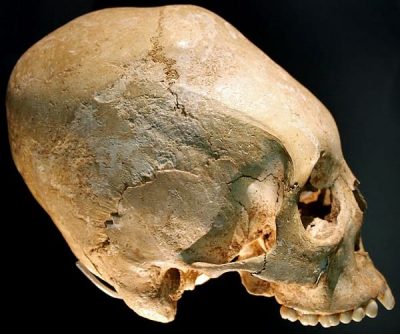
Deformed skull of a woman from the early 6th century Allemannic culture. (Anagoria / Wikimedia Commons)
The practice of head-binding was very much prevalent among important nomadic groups of the Old World. One of the most notable examples of this is amongst the Huns—nomads and warriors who frequently terrorised the Eastern Roman Empire. Written records and archaeological findings provide considerable evidence that the Huns practised artificial cranial deformation prolifically.
Another notable nomadic group that practised cranial deformation is the Alan group of people. The Alans were an Iranian nomadic demographic that was the ancestors of the Great Vandal Kingdom.
Age of antiquity
In the period of Late Antiquity, artificial cranial deformation was widely performed by a large number of East Germanic tribes. These tribes were descended from the Huns and included the Gepids, the Ostrogoths, the Heruli and the Burgundians. In some tribes like the Burgundians and the Thuringian, only women participated in the practice of head-binding. Evidence of artificial cranial deformation has not been found amongst West Germanic tribes.
The practice of head-binding and cranial deformation was brought to the Middle Eastern region in the 1st century AD by the tribes who created the Kushan Empire. These regions included Bactria and Sogdiana. These areas now comprise modern-day Afghanistan, Iraq and Kazakhstan.
The Americas
Artificial cranial deformation was widely practised by a large number of North and South American native tribes. The practice of head-binding was prevalent in the Mayan and Inca Civilization as well. In North America, the tribes living in the Chinookan and Choctaw regions also practised artificial cranial deformation. A group of Indians, called the Salish people, practised a form of head-binding that made their heads appear rounder. A subgroup of the Salish, the Bitterroot Salish, was referred to as “Flathead Indians”, just because they did not perform this specific custom. Nooksack Indians performed head-binding by strapping an infant’s head to their cradleboard.
Other areas
Artificial cranial deformation was also performed customarily by the Lucayan people of the Bahamas, amongst the indigenous tribes of the islands of Hawaii, Tahiti, Samoa and Paumotu. According to recently unearthed evidence, head-binding was also performed by the Aboriginal Australian Tribes and in the French district of Toulouse well into the 20th century.
The Mangbetu people of Africa too practised head-binding and they stood out to European explorers because of their elongated heads. The Mangbetu continued to practice artificial cranial deformation until the early 1900s when the custom began to die out.
This was mainly due to a medical myth, where parents would tightly bind the heads of newborn babies to prevent accidents. This practice of head-binding resulting in the Toulousain Deformation is called bandeau.

From the Scenes from every land by Grosvenor, Gilbert Hovey, 1875-1966, National Geographic Society (U.S.).
Methods and varieties
As discussed earlier, the practice of artificial cranial deformation usually started right after birth. At this stage, the skull is soft and almost malleable. It is continued regularly for the next few years until the desired shape has been achieved. Different methods of head-binding exist for achieving different skull shapes. The general practice is binding the infant’s head tightly with cloth or planks of wood to coax it into the rounded or elongated shape. Desired shapes include rounded, flattened, elongated and conical.

Artistic depiction of methods that were used by Maya peoples to shape a child’s head. (Fruitpunchline / Wikimedia Commons)
Why was this practised at all?
The motivations behind the practice of artificial cranial deformation have been studied and debated upon by historians all over the world. One of the most widely accepted theories is that it was practised to signify group affiliation or social status. An elongated skull or a rounded skull was considered aesthetically pleasing or desirable in certain cultures. To improve the social prospects of children, they were subjected to this procedure. In Mayan society, having an artificially deformed skull was a symbol of wealth, power and higher social status. In the North American native tribes, having a specifically shaped skull was a way of tribe affiliation or belonging. In France, head-binding was practised as a result of a pseudoscientific notion and medical myth.
Artificial cranial deformation is one of the most interesting phenomena that historians have been studying for a long time. It has been practised since prehistoric times by cultural groups that were widely separated and did not have any common link. However, all of them practised head-binding for the same basic reasons. Even today, in the islands of Vanuatu, individuals with distorted skulls are thought to be more intelligent and spiritually enlightened. Appearance has always been closely linked to social position and privilege and continues to be the same even today. The only difference is that modern-day civilizations have radically different standards of beauty and aesthetics.
Enjoyed this article? Also, check out “Trepanation: Unusual Medical Procedure of Drilling Hole in the Skull“.
Fact Analysis:
STSTW Media strives to deliver accurate information through careful research. However, things can go wrong. If you find the above article inaccurate or biased, please let us know at [email protected].
RELATED
The post Changing the Skull’s Shape to Adhere to the Community’s Beauty Standards appeared first on .
]]>The post The Quirky Palate and Gourmet Adventures of Charles Darwin appeared first on .
]]>
Charles Darwin. (Julia Margaret Cameron / Wikimedia Commons)
Every enthusiast has their own idealistic ways to drive their passion. Among these, scientists are a fairly odd bunch who go to great lengths in search of the elusive solutions they are on the lookout for. Not falling short of eccentric traditions and methods, scientists have even resorted to eating organisms that they have themselves discovered. Charles Darwin, one of the influential figures in science, is one such individual who was quite open about his strange diet. While eating an endangered species might otherwise be absolutely horrifying to the scientific community, eating the organism you have discovered yourself might give you a free pass.
Charles Robert Darwin also conceived the theory of Natural Selection, along with his famed Theory of Evolution, which he came to through a series of detailed investigations in natural sciences. Due to his contributions to shaping our conception of anthropology and the evolution of humankind, Darwin may be regarded as one of the most influential figures in the field of science and has had the honour of being buried in Westminster Abbey.
Dine with Darwin
Charles Darwin’s appreciation for animals and their evolutionary traits is not unnoticed. While they contributed to his scientific discoveries which changed the face of how we perceive evolution, they also contributed to his ghastly appetite. Darwin considered the human palate to be vast and capable of devouring various species of beasts and birds that the world had to offer. According to him, what was unknown to the human palate offered savoury delights along with a fundamental insight into the existence of the beast that was being devoured.
The glutton club
His habit of indulgence was furthered by him being a member of the Glutton Club at Cambridge, where a select group of people shared the same ideology and dared to indulge in the various species of exotic animals. The Glutton Club was short lived. They mostly feasted upon birds and were able to indulge in a few species like hawks, a heron-like wading bird called a Bittern and several other bird species. However, when they came upon a brown owl they lost their appetite stating that it was an indescribable kind of flesh.
A strong will is what makes a scientist devote himself to the journey that has been embarked upon, and this is a major characteristic that has been displayed by Charles Darwin. Despite the dissolution of the Glutton Club, he continued on his culinary adventures.
A culinary adventure aboard the HMS Beagle
While he was in the Galapagos Islands, he tasted several species of iguana. He tasted armadillo which he and several other sailors aboard the HMS Beagle claimed tasted like duck. Not only did he taste the famed ‘Giant Tortoise’, which is now an endangered species in the Galapagos Islands, but he managed to make a savoury delight by frying them. What’s more, is that he made a bold choice and managed to even savour the contents of the tortoise’s bladder. Upon tasting an entire cup, he claimed it was limpid in taste and only slightly bitter. He even dined on something as spectacular as a puma, only to say that the meat of a puma had a taste which was “remarkably like veal”. Among several species of rodents, he consumed a 20 pound rodent, which was believed to be an ‘agouti’, and described it as the best meal he had ever tasted and continued to feast on it.
The unfortunate Christmas day dinner
People make a lot of mistakes and blunders in their lifetime, only to regret it later on. Charles Darwin unknowingly made a terrible mistake that he considered one of the biggest blunders of his life. It was a culinary blunder that came in the form of 1833’s Christmas Day Dinner. Darwin’s team, knowing that he enjoys the unique savoury delights, prepared him a rather special meal that consisted of a Rhea. It is a large flightless bird similar to an Emu that is native to Altiplano and Patagonia in South America. It is known as the lesser Rhea, or Rhea Darwinii which derived its name from Darwin himself. This Rhea was a smaller, much rarer bird than the common Rhea. While Darwin was feasting upon the precious creature, he realized the bird’s importance, as the creature he had been frantically looking for during his entire journey, and immediately stopped his meal and gathered the remaining bits of the bird which included its head, neck, a few feathers and its legs. As scrumptious as the meal was, he instantly regretted it. The value of the bird dawned upon him, due to which he sent the remaining parts of the bird back to England for safekeeping.
Darwin’s Illness: Killer parasite
After leading a rather content life, Darwin succumbed to an illness that gradually took a toll on him and led to his death. He suffered palpitations, vomiting, stomach problems, severe boils and trembling, primarily due to stress from work. The cause of his illness was unknown at first and any attempts at treatment seemed to have no effect. Later on, he was diagnosed with angina pectoris or coronary thrombosis. It was later speculated that he was bitten by the “Kissing Bug” while he was in Mendoza, Argentina in 1835. He exhibited a variety of symptoms including cardiac disease and chronic headaches. Doctors then came to the conclusion that he had what was called the “Chagas Disease”. T.Cruzi is the name of the infecting parasite that got Darwin into this predicament.
He died a happy man on 19 April 1882. His ideas and contributions were revolutionary at the very least. He was honoured with burial at Westminster Abbey close to Sir Isaac Newton and John Herschel. In the end, it all boiled down to contracting a disease from doing what he loved in his quest for scientific discovery.
Enjoyed this article? Also, check out “Tarrare: The Man Who Ate Too Much Yet Stopped at Nothing“.
Fact Analysis:
STSTW Media strives to deliver accurate information through careful research. However, things can go wrong. If you find the above article inaccurate or biased, please let us know at [email protected].
RELATED
The post The Quirky Palate and Gourmet Adventures of Charles Darwin appeared first on .
]]>The post The Acoustic Kitty Project: Weird Feline Spies of the ’60s appeared first on .
]]>
Photo of a cat. (Alvesgaspar / Wikimedia Commons)
The Acoustic Kitty Project was a project undertaken by the Central Intelligence Agency to spy on the Soviets during the Cold War. The CIA was tasked by the United States government to obtain and analyze information to avoid threats to National Security. Kitty here indicates a cat, which was trained to spy on enemies and gain intel by listening in on their conversations. Through surgery, the cats would have a recording and transmission device fit into its body which served the purpose of the entire project. While most operations are classified and never reach the public, Acoustic Kitty was open to the public in 2001. The Central Intelligence Agency Directorate of Science and Technology took up this project because they saw a lot of scope in the way animal engineering was advancing. Another advantage was the way cats are mostly undetected by people and can move around without causing any suspicion.
Feline intervention
The CIA observed that cats are virtually undetectable and are present at the oddest locations with absolute ease. The intention to use cats to spy on the Soviets was rather sudden. While on a mission, a few federal agents observed that the place was crawling with cats and this was reported back to the headquarters, after which a plan sprang into action to launch the Acoustic Kitty Project.
The reasons for the Acoustic Kitty Project are obvious; cats are stealthy creatures that go unnoticed. They are also rather curious and sometimes poke where they don’t belong. With the right training, the CIA believed they could extract any required information. So to start with, the CIA hired a veterinary surgeon to perform a procedure on a test cat which involved implanting a small radio transmitter on its back and in its ear canal was a microphone. These two devices needed to be connected somehow, so a wire was placed across its fur along with batteries to power the two devices.
Cats are similar to humans and are able to distinguish between various noises. The CIA believed that it could be possible to train cats to eavesdrop only on selective and relevant conversations, unlike mechanical bugs that record everything in their vicinity.
A learning curve
Any kind of training has its problems, and this particular project had many bumps in its course. The first and foremost issue was the batteries that were put in place to power the devices. Since a cat is rather small in size, only small batteries were used, which didn’t last long enough as it should have. Another issue was the cat’s hunger. It was observed that every time it got hungry, it would avoid the mission at hand and focus on how to get food and stray off the path. Due to this little hitch along the way, the CIA equipped the cat with a wire that sent signals to the cat’s brain or neural system to overrule its hunger impulses, and stay on the mission at hand. Yet another problem was the machinery that was put onto the cat, the CIA needed to maintain its cover so it had to make sure the equipment wasn’t protruding out of the cat’s body. A high-tech listening device was not easy to accomplish due to the lack of sophisticated technology and equipment back in the day. A lot of time was devoted to the Acoustic Kitty Project along with considerable resources that surmounted to huge losses faced by the agency.
It took the CIA five years to complete the project and $20 million which if you account for today with inflation, amounts to nearly $160 million. The Acoustic Kitty was also given the name of a feline-android hybrid or what normal people would call a cyborg cat. After the rather long training process, the Acoustic Kitty was ready to take on its first mission. The mission was to eavesdrop on the conversation of two men sitting in a Soviet compound inside a park located in Washington, D.C. When the agents released the cat to partake in its mission what they expected was simple, that the cat would go along unnoticed and record the conversation of the two individuals in the Soviet compound and return unharmed.
As soon as the cat was released, it darted out across the street and it was abruptly hit by a taxicab and squashed to death. The death of this cat resulted in a loss of 20 million dollars and the project was scrapped by the CIA in 1967. According to a senior fellow at the National Security Archive in Washington, who goes by the name of Jeffrey Richelson, project Acoustic Kitty wouldn’t have survived very long even if the cat would have successfully completed the mission. The costs associated with it were too high and technology came around to be more sophisticated than the feline spies.
Acoustic kitty’s failure
What was initially a heavily redacted memo was now open to the public. The title of the memo was “Views on Trained Cats” and it classified Acoustic Kitty as not a complete failure. Scientists at the time made huge progress in animal engineering. According to the document, the highly trained cats did not serve the purpose of the CIA’s highly specialized needs and was not practical. The program also did not account for environmental and security concerns, if a mission were conducted on unknown grounds.
The memo also specified that the training indicated that the cats could move short distances effectively. This in itself according to them was a scientific achievement. Although this particular project was a failure, animal engineering did not stop. With a joint effort by the Pentagon’s Defense Advanced Research Projects Agency and the University of Berkeley, scientists managed to advance in the animal engineering field and remotely control insects, even something as small as a beetle with the sophisticated technology available. Rest assured, it can be safe to assume that conversations around cats are not dangerous in today’s world.
Enjoyed this article? Also, check out “Project MKUltra: CIA’s Cold War Conspiracy to Secretly Control Human Mind Goes Wrong“.
Fact Analysis:
STSTW Media strives to deliver accurate information through careful research. However, things can go wrong. If you find the above article inaccurate or biased, please let us know at [email protected].
RELATED
The post The Acoustic Kitty Project: Weird Feline Spies of the ’60s appeared first on .
]]>The post Margaret Howe Lovatt: Strange Case of a Male Dolphin Falling in Love with a Young Lady appeared first on .
]]>
An unidentified woman shaking a dolphin’s hand. Photo used for illustration only. (Florida Memory / Flickr)
Life evolved on earth beginning from a single cell. Then came multicellular organisms. These all reproduced asexually, till extremes of stress arising from environment forced life forms to switch to sexual reproduction. In hard times they reproduced sexually and in normal times asexually. Further on, a big chunk of life graduated to sexual reproduction for all times. But sex generally remained confined to animals of the same species. Any deviation from this remained untenable. But there is a documented case of a sexual relationship between an aquatic mammal and a human. A 23-year-old lady, Margaret Howe Lovatt, deputed to teach the English language to a male dolphin, was forced to put up with latter’s sexual advance.
Interspecies communication was the seed-idea
The story begins with a science fiction “Man and Dolphin” written by a Dr John C. Lilly in 1961. The author, an eccentric neurosurgeon, argued that dolphin had superior brains like humans, and they pined to communicate with humans. The idea appealed to Frank Drake of National Radio Astronomy, West Virginia. Drake, an Astronomer, was searching for extra-terrestrial life by analysing radio waves received from other planets. He arranged state funding for Dr John C. Lilly and encouraged him to conduct scientific experiments to explore the possibility of interspecies communication.
Laboratory was built for human-dolphin interface
Dr Lilly couldn’t have asked for more and established a lab named Dolphin Point. The lab was equipped with a pool for 3 dolphins and a workspace for training and research. The lab attracted the attention of a passer-by young lady named Margaret Howe Lovatt.
Margaret was employed to teach English to dolphin
Margaret grew up on ballads of human-animal camaraderie and was fascinated by the idea of the lab. Dr Lilly had already established that the dolphin brain was 40% bigger than the human brain. That dolphin had a human-like response to pain and anger and could understand human language to a fair degree. Margaret’s interest in the project was viewed favourably by the Director, Gregory Bateson, and she was appointed to teach the English language to a male dolphin named Peter.
The lab was a semi-aquatic building
The Dolphin house was flush with seawater to enable Margaret to live well with Peter and 2 female dolphins. The water on the first floor was shallow for convenience of the interface between Peter – the dolphin, and the lady -. A working desk, hanging from the ceiling, was the dry area the lady could climb to for study and making notes. There was a hanging mattress too, surrounded by shower curtains, where she could retire for rest. Nevertheless, the job assigned to her was tough. Margaret cropped her hair and adjusted to a semi-aquatic living. Virtually cut off from rest of the world, she lived on canned food and focussed 24×7 on completing Peter’s training within the assigned time frame of 10 weeks.
The training program was rigorous
The training schedule of the dolphin began at 8 in the morning. The dolphin was trained to mimic a given set of human sounds. Margaret taught Peter to greet her with the sound of “Hello Margaret”. Sounding “M” was difficult for Peter. Margaret painted her face white and lips black so that her lip movement could be seen by him and he could manoeuvre his blowhole accordingly to mimic a sound. Peter worked equally hard on the sound of M, and finally succeeded by rolling over. So dedicated was the teacher-taught duo that the dolphin succeeded in pronouncing words like we, one, hello, work and play with human approximation. Dedication to assigned job led to mutual admiration, and, finally to love with sexual overtones. The lady though emphasised that sexual attraction was one-sided, from Peter to her, and not the other way round.
Peter grew fond of Margaret
As the rigorous training schedule progressed, the physical, as well as the emotional bonding between the two, grew strong. Margaret and Peter lived, ate and played together. The 22-inch deep water on the first floor permitted the two to come close for work. Gradually, Peter ceased to be all obedient and turned adventurous and naughty. When the lady said “work”, the dolphin countered “play”. The trespassing didn’t stop at that. When Margaret rested on her hanging mattress, Peter splashed water on the shower curtains, calling her down for the company. They played together as a routine in the morning at 10 AM. But Peter, seemingly, demanded more time to play. At 12 PM and 3 PM, Peter was fed on a fish-diet. At the same time, Margaret played with Peter. She would throw the ball, and towels which the dolphin would dutifully chase and bring back. Peter also got hooked to watching television in the company of Margaret. All was going well and Peter was making good progress in learning. Just then, the 6-year-old dolphin and showed signs of sexual maturity. Peter loved rubbing against Margaret and bite gently on her toes. The two slept in close proximity. At times Peter was restless at night, yelling and wriggling in the water around Margaret’s bed, and forcing her to get up early in the morning, ostensibly to feed him.
Fondness grew to possessiveness
As Margaret readied to teach shapes and counting, Peter didn’t seem to care. Like a sulking schoolboy, he didn’t listen to his teacher. Touching by Margaret made him quirky. He yelled just as Margaret opened her mouth to teach. Of all the worlds taught to him, one that he uttered best was “ball”, the symbol of playing and having fun in the water. Peter enjoyed looking at his reflection in the mirror and felt annoyed when Margaret talked on the phone. He grew extremely possessive of her and wanted her uninterrupted attention all the time.
Female dolphins failed to satiate Peter
By the second week, Peter grew fond of Margaret’s physical presence and enjoyed touching her knees, ankles, feet and legs. Though generally docile, at times, he gave her hard push. No more interested to play ball solo, he nudged her in many ways to play with him. The dolphin got sexually aroused several times in her company. This was clear as the light of the day, beyond an iota of doubt. The sexual arousal of dolphin clearly rattled their teacher-taught relationship. Peter was infatuated by his teacher’s physical presence and that showed loud and clear in his behaviour. That was something that Margaret was not prepared for. Dolphin house had a separate pool with 2 female dolphins. And as per the research protocol, a sexually aroused male was to be sent in the pool of the female dolphins. Margaret did just that. When Peter returned to Margaret after a while, he was subdued and gentle. But the attraction towards human anatomy was far from over. In fact, it got accentuated.
Margaret was forced to address dolphin’s sex drive
Peter loved rubbing his mouth on her legs. Margaret rightly concluded that Peter was trying to court her. He was positioning his underbelly and the genital area to where it could be fondled by her. It was a benign invite for sex from a dolphin which could very well be aggressive and demanding for same. Ignoring him could cost Margaret her job. Sending Peter down to female company time and again was eating into her training hours and a sexually agitated dolphin was not receptive for learning. So, in her wisdom, she decided to masturbate the aroused dolphin the hope that a sated dolphin will get back to the training schedule in earnest.
Forced cohabitation became ‘enjoyable’
It was like, she revealed, later on, a forced togetherness turning into an enjoyable togetherness. That, she added, was a very close encounter, not with a dolphin, but a male, Peter. Unfortunately, just as the two made a good company (sexual from point of view of Peter, and “probably sensuous” on Margaret’s part), the experiment had to be stopped for want of funds.
Fund crunch stopped experiment in track
With the experiment ending pre-time, in 6 weeks instead of stipulated 10 weeks, Peter was sent to a different location. There, as per the report of Veterinary Doctor, Peter committed suicide. Dolphin is very much capable of committing suicide by choosing not-to-breathe (its respiratory muscles are under its voluntary control, unlike in humans where these are involuntary and can’t be controlled by will) and drown to death in a pool of water.
Why Peter committed suicide?
So, what killed Peter? Unrequited love for a human female? Or an inability to jell with females of its own species? Or both reasons operating simultaneously?
Was training to communicate with humans a kind of stress, like the one which led to sexual differentiation during evolution? And that stress led to inter-species sexual attraction? Education is stressful even for human children, so surely it couldn’t have been any different for a dolphin. Or, was Peter treated as incompatible by the two female dolphins put in place for the former’s sexual satiation? An element of competition is integral to sexual reproduction. Several males compete to mate with a female and only one, the best of the lot, succeeds in fertilizing the female. As this choice denied to the female dolphins, did they reject Peter sexually? Organs of reproduction in female dolphin are such that a male deemed unsuitable may be entertained only partially, deceptively, without giving it a real chance of fulsome copulation. Could such rejection be the reason for the unnatural attraction of Peter towards a human female? Was the handwork done by Margaret more convenient for Peter than a cumbersome penetration into female dolphins?
This obviously is a grey area for scientific exploration.
Enjoyed this article? Also, check out “Sex in Space – Is It Possible? and Why It is Important“.
Fact Analysis:
STSTW Media strives to deliver accurate information through careful research. However, things can go wrong. If you find the above article inaccurate or biased, please let us know at [email protected].
RELATED
The post Margaret Howe Lovatt: Strange Case of a Male Dolphin Falling in Love with a Young Lady appeared first on .
]]>The post Victor of Aveyron – The Feral Boy from France appeared first on .
]]>
Artwork of Victor of Aveyron. (Gallica Digital Library)
Victor of Aveyron was a feral child discovered in the environs of Saint-Sernin-sur-Rance. While he attracted a lot of public attention at the time, attempts to civilize and integrate him into French society were not successful.
Discovering Victor of Aveyron
In 1794, the woodmen of Aveyron in France noticed a strange boy in the woods near Saint-Sernin-sur-Rance. He wore a ragged shirt and appeared to behave more like a wild animal than a human being, walking on all fours and foraging for food on the ground. The woodmen weren’t able to get near him, but saw him on several occasions during the next four years. In January 1800, they were able to capture him—or he approached them; there are conflicting stories about that—and found him to be completely feral and unaccustomed to being around human beings.
He appeared to be around 12 or 15 years old. Incapable of speech, he could only produce animal-like sounds, and, at first, he also seemed to be deaf. There was no way of knowing who he was or for how long he had been alone in the woods. There was some speculation that he might have been an illegitimate child and that his parents or caretakers had abandoned him on account of his obvious cognitive disabilities.
The authorities in Aveyron placed him in an orphanage and he sparked a great deal of public interest, but it was not easy to care for him. Dubbed the Wolf Child, he disliked being forced to wear clothes and tore them off at every opportunity. Pierre Joseph Bonnaterre, a naturalist, observed his behaviour and noticed that his mood brightened in sunlight. Also, when it snowed, he ran outdoors, tore off his clothes, rolled naked in the snow, and ate it by the handfuls. He appeared to be completely impervious to the cold, and also to the presence of humans, unless they had anything he could eat.
Attempts to rehabilitate Victor
After a few weeks in Aveyron, the authorities decided it might be better for the boy if they sent him to the National Institute of the Deaf in Paris. Although he wasn’t deaf, the experts there might be better able to care for him. There was much public debate at the time about whether it was morally right to try and civilize the boy or let him remain as he was.
At the Institute, the renowned instructor Abbé Roch-Ambroise Cucurron Sicard attempted and failed to instruct the feral boy in even the rudimentary social behaviours. The boy showed no sign of understanding anything he was taught and lacked all reasoning capacity. Doctors examined the boy and found that, while he was healthy and wasn’t deaf, he had faulty eyesight. Moreover, they discovered that he had poor coordination and showed signs of being severely mentally retarded. Declaring the boy to be a congenital idiot, Abbé Sicard washed his hands off him and allowed him to roam unhindered on the Institute’s grounds.
Victor of Aveyron and Itard
A medical student named Jean-Marc Itard took an interest in the young boy and decided to try and help him. He took him into his house, named him Victor, and appointed a woman named Madame Guerin to care for him.
Working tirelessly together, Itard and Madame Guerin attempted to socialize Victor by monitoring his daily activities for the next six years. It was an uphill task. As Itard discovered, Victor could not even differentiate between hot and cold sensations. Just as he rolled in snow without feeling the cold, he could dip his hand in boiling water without flinching to scoop out potatoes.
Itard and Madame Guerin had to use sensory stimulation training to make Victor understand the differences between hot and cold as well as the differences between wet and dry. They also accustomed him to wearing clothes, to eat with a spoon, and to being around people.
Once, to socialize Victor, Itard took him to a dinner gathering at a leading socialite’s home. The party was packed with people eager to see the feral boy, and he more than lived up to their expectations. After stuffing himself at the table and filling his pockets with the delicacies, he slipped away into the garden. Itard and the other noticed his absence only after they heard excited shrieks from the garden.
Running out there, they saw that Victor had shed most of his clothes and was speeding about happily across the lawns. As they watched, he ripped off the last remnant of clothing and clambered up a tree. He then proceeded to leap from tree to tree and ignored all the efforts of the scandalized guests to bring him down. He only came down after a quick-thinking gardener brought out a basket of peaches to tempt him.
Through repeated and patient attempts, however, Victor began to be more sociable around people. He began helping Madame Guerin with tasks around the house. He also showed empathy when her husband died; when he came across her weeping, he attempted to console her.
Along with socializing him, Itard attempted to teach Victor to speak, read, and write. There was a limited success here as well. Victor learned to speak only three works—eau (water), lait (milk), and O Dieu (Oh, God)—but did much better with recognizing shapes and letters. He also began to comprehend gestures, and might have benefited from learning sign language; strangely, Itard did not attempt to teach him that.
Victor’s progress remained limited and Itard attempted to speed things up by subjecting him to electric shocks; it was an accepted form of treatment at the time. Unfortunately, far from improving, Victor became prone to flying into sudden rages and also began to show signs of developing epilepsy.
Coming to the conclusion that there was nothing much he could do to teach Victor, Itard stopped the treatments and the teaching sessions. Leaving him in Madame Guerin’s care, he moved on to work on other research projects. Victor lived with Madame Guerin until his death in 1828. He was 40 years old and had made no further developmental progress.
The idea of the noble savage
In the 18th century, many Europeans thinkers and philosophers began to examine and question the concept of civilization. For various reasons, they assumed that human beings were better off living untrammelled in nature than in the confinements of urban areas. They thought that primitive tribes had fewer social problems and were morally superior to civilized people. The idea of the noble savage captured the public imagination. According to this line of thought, people were born with inherently noble qualities, but it was the nurture they received that led to their moral downfall.
The case of Victor of Aveyron put a spanner in this notion. There was nothing noble about Victor. He was more to be pitied than taken as an emulative example. Most feral children, like Victor and Dina Sanichar from India, grew up neglected and isolated, and miss a critical period of language development that can never be recouped. As they can never overcome their severe developmental issues, these children can never fully integrate into society and few of them live out their full lifespans.
Enjoyed this article? Also, check out “Mowgli was Real: Dina Sanichar, the Indian Boy Raised by Wolves“.
Fact Analysis:
STSTW Media strives to deliver accurate information through careful research. However, things can go wrong. If you find the above article inaccurate or biased, please let us know at [email protected]
RELATED
The post Victor of Aveyron – The Feral Boy from France appeared first on .
]]>The post Trepanation: Unusual Medical Procedure of Drilling Hole in the Skull appeared first on .
]]>
A painting by Hieronymus Bosch depicting trepanation. (Hieronymus Bosch / Wikimedia Commons)
The world is a bizarre place at times. And that is a severe understatement. For many, they cannot envisage some of the extreme things people do alas people will resort to extreme things when in desperate need. Some of the most pioneering events in the world have come from this precedent after all. Perhaps that was the case for Amanda Feilding, an English woman with a penchant for LSD who drilled a hole into her skull. This procedure is called Trepanation where a hole is made into the top of the head. It is meant to be a way to heal naturally from a variety of different neurological problems. That being said, even with no problems people have ‘Trepanned’ to achieve a heightened mood and state, or to open the mind so to speak.
Popular publication and now TV Channel VICE met Amanda Feilding, the one to have tried Trepanation. She carried out research with her directorship called the Beckley Foundation who experiment with psychedelics such as narcotics. She would later turn to Trepanation, influenced by a Dutch scientist called Bart Huges.
History and benefits of trepanation
An individual preaching something as extrovert as this would need to experience it first hand to be taken seriously. After being unable to find a doctor willing to help, Feilding did so, using an electric drill which required, according to Amanda meticulous planning. She claims that her natural state improved but not massively.
Furthermore, she noticed a great change in one of her friends who had the operation. When once prone to weekly migraines he hasn’t suffered one in thirty years since. It must be mentioned that there is a medical reasoning behind the practice. The skull does not give the brain enough room to fully pulsate which puts a lot of strain on the individual and creates pressure points.
Feilding’s goal is to make the practice legal which began with an attempt to make it available on the NHS – the UK’s National Health Service. However, she later claimed that was more of a publicity stunt. She is looking for more volunteers to experiment on, which would make it more accepted in the medical fields.
Amanda Feilding is far from one of the first humans to try this. The more we learn about history and prehistory the more we uncover what is an ancient practice. It emerged that it dates back to 10,000 BC. Thousands of skulls have been unearthed from a burial site in France dating from 6500 BCE with 40 out of the 120 total recovered skulls there having trepanation holes. The motives then are less known but it seems – as today – the aim was to cure pain as many show injuries or diseases around the holes. Religiously speaking it was also used to cast out the devil or let in light. African tribes today show us a vision of the past in these aspects.

A skull found in Edinburgh showing trepanation. (Wellcome Images)
Modern application of trepanation
In more modern times trepanation spread to the Orient with Tibetan monks and Shivu, the Hindu God who are considered as early practitioners of it. It then continued to Ancient Greece – a cornerstone of civilization where Hippocrates (Greek physician) used it to drain the blood of patients. Also in Rome – another ancient powerhouse – and Greek physical Galen who lived in the Roman Empire. He implemented it in his medical tests to release pressure. It was there it got its name from the Latin verb ‘Borer’ – to bore. That is the most likely reason however an instrument designed to aid Trepanation called ‘Tre Fines’ is another theory, meaning three ends.
Recently with advancements in technology and medicine, the popularity of Trepanning decreased as the high mortality rate put people off the idea. Craniotomy is a similar practice but the part of the bone removed from the skull is replaced once the surgery is complete.
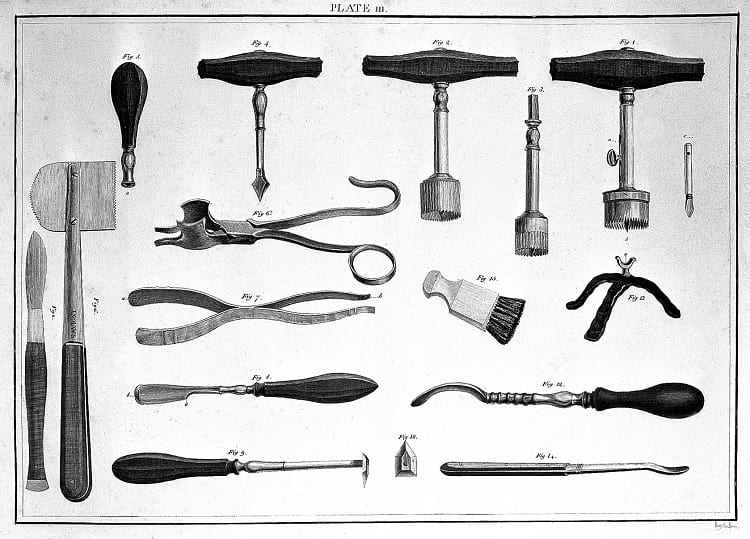
Trepanation tools from the 18th century. (Wellcome Images)
Trepanation is one of the first, if not the first surgical procedure in history. Its success is apparent in several cases but its failures are crucially debilitating to the overall acceptance of the practice. None the less, pioneers like Feilding continue to fight to have it respected. Perhaps this is a case of what was left in the past should remain in the past. On the other side, if you don’t try then you’ll never know as the saying goes. Any volunteers?
Enjoyed this article? Also, check out “Phineas Gage: The Miracle Man with a Hole in his Skull who became a Major Breakthrough for Neuroscience“.
Recommended Read:
1. The Mechanisms of Brainbloodvolume (1964) | By Bart Huges
2. Holes in the Head: The Art and Archaeology of Trepanation in Ancient Peru | By John W. Verano
Recommended Watch:
A Hole in the Head (1998)
Recommended Visit:
International Museum of Surgical Science | Chicago, USA
Fact Analysis:
STSTW Media strives to deliver accurate information through careful research. However, things can go wrong. If you find the above article inaccurate or biased, please let us know at [email protected].
RELATED
The post Trepanation: Unusual Medical Procedure of Drilling Hole in the Skull appeared first on .
]]>The post Martin Laurello: The Astounding ‘Human Owl’ Who Could Turn His Head Around By 180 Degrees appeared first on .
]]>
Martin Laurello with his head turned at a bar. (Artem Servadze / Wikimedia Commons)
The Life and Times of the Human Owl
Originally from Nuremberg, Germany, Martin Laurello migrated to the United States of America in 1921, along with several other people who suffered from rare conditions like Laurello himself. He was a German- American performer, who was given the stage name of ‘The Human Owl’.
Being able to turn his head around by 180 degrees is not a feat that even Laurello could possibly have achieved overnight. Laurello spent three years practicing to slowly twist his head little by little until he was finally able to achieve this feat. He worked with many performing groups like ‘Ripley’s Believe It Or Not’, ‘Ringling Brothers’, as well as with ‘Barnum and Bailey’. Percilla Berjano, also known as the ‘Monkey Girl’, was Laurello’s fellow performer and spoke out about him, confirming that he “could put his head all the way around.”

Martin Laurello with his head turned 180 degrees around. (Wikimedia Commons)
When Martin Laurello was working at the Bailey Circus he came to be known as ‘Bobby the Boy with the Revolving Head’. He is also believed to have worked at Hubert’s Museum during the winter, which is based in New York City. He also worked with the Ringling Brothers, as well as in Coney Island, after his stint at Hubert’s Museum. In the 1930s, Laurello attracted huge crowds when he was working at ‘Ripley’s Believe It or Not! Odditoriums’.
When Laurello would twist his head, he was not able to breathe. However, he was able to drink. During performances, he would prefer wearing a white shirt, and could walk straight, even when he twisted his head to look backwards.
Personal Life
Very less is known about Martin Laurello’s personal life as there is practically no documentation of it. It is however known that he had abandoned his wife, and she had lodged a complaint against him via telegram. Consequently, the Baltimore police had arrested Laurello.
Martin Joe Laurello and his Pets
Other than being able to rotate his head, Laurello was also known for training various animals, particularly cats and dogs, to perform acrobatics. He would typically begin his act with the animals that he had trained himself. One of his famous acts was one where two cats were made to wear gloves, and would box each other. Laurello also had an act where he would have two dogs engage in a dance routine together. Laurello had a dog named ‘Frisco’ who had been trained to walk only on his hind legs, like a human, and it could even smoke a cigar while carrying an umbrella. It was only after his animals had performed their acts that Laurello would proceed to astonish his audience with his signature act of twisting his head around by 180 degrees, and showcase the anatomical wonder that he was.

A postcard showing Martin Laurello’s pets. (Unknown)
Speculations
Being of German descent, Laurello was supposedly a Nazi supporter and according to his fellow performer Berjano, he “didn’t like the American flag”. His last performance was supposedly in 1945 with Ripley, after which he probably chose to retire. Following his retirement, no one knows what happened to Laurello, according to rumours he passed away in the 1950s.
Enjoyed this article? Also, check out “Leonard Trask: The Man Who Conquered Disability“.
Fact Analysis:
STSTW Media strives to deliver accurate information through careful research. However, things can go wrong. If you find the above article inaccurate or biased, please let us know at [email protected].
RELATED
The post Martin Laurello: The Astounding ‘Human Owl’ Who Could Turn His Head Around By 180 Degrees appeared first on .
]]>The post The Newby-McMahon Building: A Four-Storey Building That Is ‘the World’s Littlest Skyscraper’ appeared first on .
]]>Growth in the economy encouraged the townspeople to believe in the construction of the skyscraper. The project proposal in 1919 met with next to no negativity, and investors raced to make themselves a part of the game plan that J.D McMahon had put forth. Entirely unaware, they would all be duped and would eventually witness the construction of the world’s littlest skyscraper.

Newby-McMahon Building in Wichita Falls, Texas. (Travis K. Witt / Wikimedia Commons)
The original gameplan
A massive boom in the industry hit the town of Wichita in the 1900s upon the discovery of a petroleum reservoir, which led to a sporadic population explosion, ultimately resulting in an increase in the workforce. McMahon was not the first to propose the idea of constructing an office space for the rapidly growing industry. Earlier in 1906, Augustus Newby, a railwayman had successfully constructed a one-story building that was used as an office space. It was around the corner at the end of a street named “Seventh and La Salle”. However, the Newby building proved to be inadequate to house the workforce it needed to, and had to be reconstructed to accommodate the need for more office space. A one-story building would not be enough for the massive workforce that had moved into the town.
McMahon’s strategy
The idea of a skyscraper in a little town with a mere investment of $200,000 amused investors, but they rushed in to be a part of the project nonetheless. J.D. McMahon was the owner of an oil construction company whose office was in a one-story brick building on the corner of Seventh and La Salle. He then came up with the idea of building a skyscraper in the empty plot next to his office. During the expansion, he had, incidentally, taken no permission from the landowner of the lot and used his own company to build the skyscraper. Little did the investors know that the skyscraper — or so it was called, was just a four-story building. The investors had been successfully duped out of their money by McMahon.

The one-story building next to the Newby-McMahon Building. (Michael Barera / Wikimedia Commons)
How exactly he got investors to sign on papers is another story altogether. Very few people actually pay attention to detail, and as it seems, these investors who believed in McMahon were not one of them. The proposed plan for the building was 480 inches and not 480 feet. They simply failed to notice that the stroke was double and not single. While investors took this to court after the construction was done and they were shocked by the finished product- it eventually yielded nothing as the plans were indeed for 480 inches, which they had all signed off together. As a result, when the elevator company that had been given the contract learned of the proceedings happening in court, they backed out and left the lot with no elevator to scale the floors. An internal stairway was built after several years, which helped to access the other floors. Before that, a ladder was used to climb to the upper floors of the alleged ‘skyscraper’.
The stories behind the Newby-McMahon Building
The multi-story skyscraper, the Newby-McMahon Building, has had multiple ‘stories’ associated with it, post its construction. There has been speculation amongst residents, who stated that the entire structure could be a decoration with just a water tower stored within it. Some residents say that it is a facility where firefighters engage in practice drills to train in their heavy suits. Some even believe that it was used as a place for bootleggers to smuggle during the Prohibition. It was also rumored that the building had been used as a set for a 1950s themed movie. However, most of this can be dismissed as rumours and small-town gossip running wild in Wichita.

Newby-McMahon Building from two angles. (Michael Barera / Wikimedia Commons)
In reality, the four-story building has housed various businesses, although in the initial years after its construction it was left as a vacant lot. This vacancy had been a source of great embarrassment for the investors as well as the locals in the area. After the economy was uplifted post the Great Depression, the Newby-McMahon Building went on to house a barbershop and various local eateries, all of which eventually moved out. A local business that went by the name of Marvin Groves Electric, partnered with a local architecture firm called Bundy, Young, Sims and Potter, and invested $3,748 and restored the structure.
To keep, or not to keep?
There have been several instances where parts of the society living in the area have put forward their views on the matter of the building. Half the people wanted the Newby-McMahon Building to be torn down out of sheer embarrassment, while the other half worked to save it. What we can conclude, is that the building had always been a source of controversy. On several occasions, the building had been scheduled to be demolished, but that kept being postponed until it was eventually given to a local heritage society.
Still standing tall
Years later, after an investment of roughly $250,000, the Newby-McMahon Building now houses an antique store and an artist’s studio, both of which are thriving. Upon the complete restoration of the building, it has also been declared a Texas Historic Landmark. Additionally, the Newby-McMahon Building has also been added to the National Register of Historic Places and is part of the Depot Square Historic District of Wichita Falls.

A Plaque attached to the Newby-McMahon Building. (Solomon Chaim / Wikimedia Commons)
It was given the epithet “World’s littlest skyscraper” as a result of its feature on a television show called ‘Ripley’s Believe it or Not’ where they explained how J.D McMahon had successfully conned the investors of the small town, and was absconding after pocketing a large chunk of the $200,000. In today’s economy, those $200,000 would amount to a whopping 2.7 million USD.
Enjoyed this article? You would also love “Stanley Clifford Weyman Found Adventure in Being a Serial Impostor“.
Fact Analysis:
STSTW Media strives to deliver accurate information through careful research. However, things can go wrong. If you find the above article inaccurate or biased, please let us know at [email protected].
RELATED
The post The Newby-McMahon Building: A Four-Storey Building That Is ‘the World’s Littlest Skyscraper’ appeared first on .
]]>The post Clever Hans: The Einstein Horse That Could do Math appeared first on .
]]>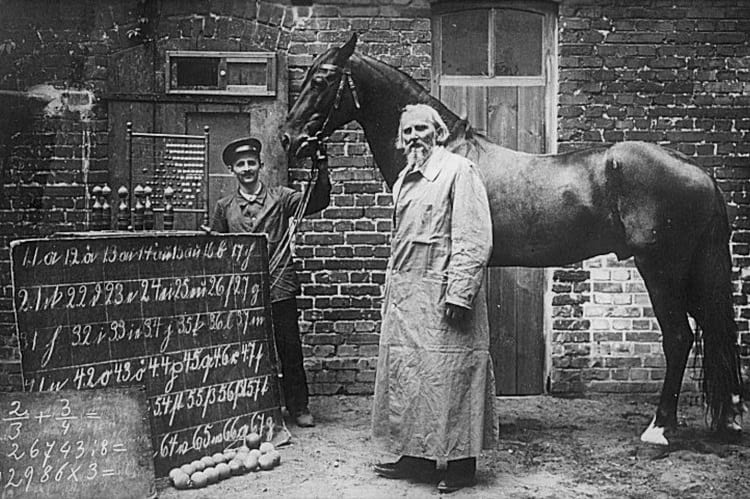
Clever Hans with his trainer Wilhelm von Osten. (Kryptozoologie / Wikimedia Commons)
We, humans, consider ourselves the smartest of all the species. After all, we have been around for just 0.004% of the earth’s history and still manage to achieve so much. But perhaps we’ve underestimated the other species. Quite commonly, we see the high schoolers struggling with maths often complaining that it is tough and adding to it, what if I told you that there was a horse that had intelligence of a fourteen year old and could do maths?
A horse named Hans became a sensation in Berlin after news spread that he could solve maths problems and perform other tasks that required intellectual intelligence. The owner of the horse, William von Osten, put him on a show in 1891, attracting a multitude of people from across Germany. Osten claimed that he had not only taught the horse to perform basic arithmetic problems of addition, subtraction, division, and multiplication but also comprehend and answers questions regarding date and time.
The horse was asked questions in both written and oral forms, to which he would reply by stamping his foot on the ground. For example, if he was asked 5+2, he would stomp his foot 7 times to answer. ‘A’ was encoded as 1 tap, ‘B’ as two taps and so on.
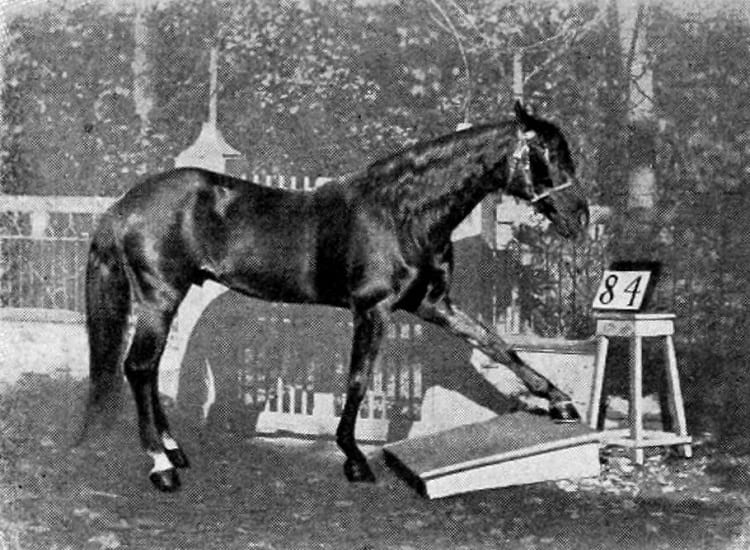
Clever Hans using a footboard to answer. (Karl Krall / Wikimedia Commons)
Not only this, he could easily tell the asked day of the week, remember and recall people’s name, identify musical intervals and even perform complex calculations such as solving fractions and square roots. The horse answered with an accuracy of approximately 89%. With such accuracy, it took no time for Hans to rise to the world stage.
In 1904, The New York Times covered the “Berlin’s Wonderful Horse”. When asked by the New York Times about how he trained Hans, Osten replied that he gave Hans “animal systematic instruction such as he would give to a child.” Also, he claimed that “the horse has never been used for riding or driving.”
Scepticism and tests
While his talent attracted a lot of appreciation, few people remain sceptical of the fact that the horse really was so smart, they believed that some kind of trick was being used to fool people. Even the scientists, veterinarians, and psychologist were baffled by Hans’ ability. While several tests had been conducted on Hans, the first scientific test was only conducted in 1904 by Professor Carl Stumpf.
Soon, Stumpf concluded that Hans’s ability was a genuine one. In 1907, a committee consisting of 13 scientists assembled. This committee was called “Hans Commission” and was a collaboration project of professor Stumpf and Oskar Pfungst. The re-testing of Hans was done to determine the nature of his ability.
Hans was tested in an organized environment inside a tent. This arrangement allowed him to be tested without any distraction and under desired circumstances. The test was specially designed to reduce the probability of chance and other favourable factors. Numerous questions were asked to Hans by various people.
Also, sometimes the questioners knew the answers and sometimes they didn’t. Moreover, the questioners were placed at varying distances throughout the trails. Pfungst (German biologist) examined the relationship between the questioner and the horse with utmost care and attention, even noting the tiniest of details. He in fact, even role-played as the horse, tapping his right hand to answer the question.
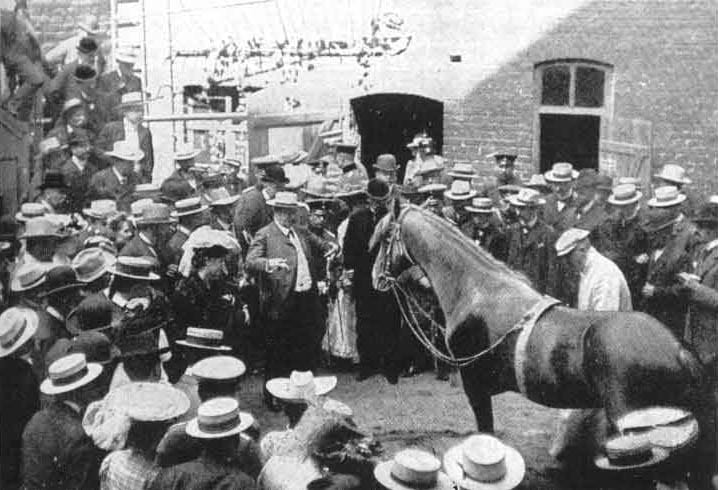
Hans performing midst several spectators. Circa 1904. (Karl Krall / Wikimedia Commons)
Conclusion & Clever Hans effect
The test help drew several conclusions – the horse could only answer correctly if the questioner knew the answer. In case, the questioner was unaware of the answer, Hans’s ability to answer correctly diminished severely. Secondly, Hans needed to maintain in visual contact with the examiner to answer correctly. When he was blinkered, his ability to answer correctly diminished even more.
It was concluded that Hans was responding to the unconscious cues such as increase/decrease in tension, facial expressions and other movements, that the questioner gave out when Hans was about to or had answered correctly. Hans was reading these minute signals to answer even the complex mathematical problems. Today, this phenomenon is known as the “Clever Hans Effect”.
Sadly, in 1909, William von Osten died. After this tragic incident, Hans was claimed by several owners. More disheartening is the fact there is no record of the horse after 1916.
Enjoyed this article? Also, check out “Secretariat: Legendary Horse with Large Heart Gene that Thundered Down the Race Track“.
Fact Analysis:
STSTW Media strives to deliver accurate information through careful research. However, things can go wrong. If you find the above article inaccurate or biased, please let us know at [email protected].
 Recommended Read:
Recommended Read:
Clever Hans (the Horse of Mr. Von Osten): A Contribution to Experimental Animal and Human Psychology | By Oskar Pfungst
Genre:
Non-fiction > Psychology
RELATED
The post Clever Hans: The Einstein Horse That Could do Math appeared first on .
]]>The post Robert Wadlow: Trials and Tribulations of the World’s Tallest Man appeared first on .
]]>
Robert Wadlow, the tallest person in recorded history. (Paille / Flickr)
God does not play dice with the universe, said Albert Einstein. Yet some humans seem an exception to this rule. Excessively tall, surprisingly short, or grotesque in other ways, they seem to question nature’s wisdom in crafting body shape. The answer lies in the body’s endocrine system which goes haywire for myriad reasons. Robert Wadlow – the tallest man ever, born to Harold Franklin and Addie May at Alton, Illinois, USA; is a good case study.
Born normal, but grew at an alarming rate
Robert was born on 22nd Feb’ 1918, with a normal 4 kg birth weight. It was his weighing 13 kg in 6 months, which alarmed the attending doctors. Then on, there was a rapid increase in his height and weight. Four siblings, younger to him, were all normal. By the age of 8, he was taller than his father. That made him a VIP of sorts. In primary school, he had a custom made table and chair in the classroom. He was a cynosure basketball player. All he had to do to score a basket was stretch his hand up over to the mouth of the net. A cinema hall created a special seating arrangement for him in the front row. It had five-seat space to spread his frame in a relaxed manner.
Malfunction of the pituitary gland caused his condition
But all was not hunky-dory. Behind the veneer of name, fame and revelry, was an anguished soul in an abnormal body frame. Pituitary, the master gland of the endocrine orchestra, was playing a wild tune in his biosystem. When an individual matures (14 to 19 years in males), the growth locus of long bones goes quiescent, and the further growth of the person stops. No such process, technically called ‘epiphyseal closure’ or ‘bone end plate closure’, occurred in Robert’s body. The result, Gigantism – a consistent and unstoppable body growth.
Ventured into show biz to support his parents
His gentleness stemmed from the poignancy of his anatomical and physiological constraints. Help and encouragement from his family and local community notwithstanding, the awe of onlookers often unsettled him. A wave of severe economic depression was lashing the world, and Robert knew how expensive it was for his parents to support his customized living. So, when the Ringing Brothers Barnum and Baily Circus offered him a job, Robert quickly took the opportunity. Even as his parents disapproved a circus job, he joined it and delivered well. Seeing his success, many business houses approached him to promote their product. The International Shoe Company gave him a pair of giant shoes, 37AA and a half size to wear, and took him on a nationwide publicity tour. As he continued to grow, his shoe size would reach 40.
Robert was a great crowd puller. His mild manners and humility earned him the title of ‘Gentleman Giant’. Yet he was ill at ease in public and longed for the safety and comfort of his home in Alton.
Being a giant was no joke
A giant body frame was a liability in many ways. His energy requirement was 8000 calories, more than thrice of an average human adult. His long legs suffered from poor blood circulation and needed brace support for walking. Lack of sensation in the legs was pathological. If a blister formed, he wouldn’t even know about it. And that proved to be his undoing. On July 4, 1940, in a professional appearance, an ill-fitting brace injured his ankle. Injury persisted unnoticed, leading to blister formation and generalized infection. His body temperature shot up to 106 degrees Fahrenheit. A minor surgery and blood transfusion was performed but to no avail. On the next day, 15th July, Robert passed away at the age of 22. His height, measured 18 days before death, pegged at 8 ft. 11.1 In; the tallest human till date.
Robert Wadlow was a darling of his native town
Nature’s perceived aberration, Robert Wadlow was loved and revered by the inhabitants of Alton. More than 40,000 people attended his last rites. Funeral services were attended by 10,000 people, and all businesses in the town remained closed on that day. His coffin, weighing 1000 pounds was carried by 12 pallbearers, and 8 walked along as relievers up to the Alton Cemetery.
A legend in life and beyond
At South Illinois University School of dental medicine, a life-size bronze statue of Robert Wadlow, as well as the bronze model of his chair, is open for public viewing. The memory of Robert is also preserved in the Alton Museum of History and Arts. There, the Photographs and artefacts related to Robert’s life will give you a feel of life that the Giant with a Golden heart lived and suffered.
Enjoyed this article? Also, check out “Pasqual Pinon: The Aberration of Multiple Heads“.
Fact Analysis:
STSTW Media strives to deliver accurate information through careful research. However, things can go wrong. If you find the above article inaccurate or biased, please let us know at [email protected].
Recommended Visit:
Alton Museum of History and Arts | Illinois, USA
 Recommended Read:
Recommended Read:
Very Special People: The Struggles, Loves and Triumphs of Human Oddities | By Frederick Drimmer
Genre:
Non-fiction > Biography
RELATED
The post Robert Wadlow: Trials and Tribulations of the World’s Tallest Man appeared first on .
]]>The post Akodessawa Fetish Market: The Creepiest Voodoo Market in the World appeared first on .
]]>
Akodessawa Fetish Market in Lomé, Togo. (Dominik Schwarz / Wikimedia Commons)
In the West African nations like Benin, Togo and Ghana or in the Caribbean nation of Haiti, Vodoun or Vodou or even Voodoo is thriving.
Vodun means spirit in the Ewe and Fon languages of Africa. The Fon people of Benin or central or southern Togo or even Nigeria and Ghana are said to be practising Voodoo. But Benin is the birthplace and home of voodoo beliefs and culture. Voodoo is formally recognised as a religion in these parts of the world.
Vodun is a distinct form of religion
Vodun is a distinct form of religion when compared to other traditional African religions. It is also the main source of religions having similar names in the African diaspora spread across the Americas, Dominica, Cuba, Brazil, Puerto Rica, and Louisiana.
Lomé, Togo’s capital city is believed to be the birthplace of the world’s largest Voodoo market. Named as the Akodessawa Fetish Market, or Marche des Feticheurs in French language, it is a super supply store for charms, fetishes or a ritual. The market is believed to be the world’s largest Voodoo market. It has annual revenues in the region of $10m.
One can find anything from leopard heads to human skulls in the Akodessawa Fetish Market. One can also find a Vodou (voodoo) priest, who bless and create a fetish or even predict the future. They even make medicines to heal you from any ailment.

Animal skulls at Akodessawa Fetish Market. (Dan Sloan / Flickr)
Benin’s official religion is Vodoun
Though Haiti is considered to be the main stronghold of the Voodoo religion, it actually originated in West African nations. Benin’s official religion is Vodoun and it continues to be the largest religion in the region.
Also, the Beninese own and run the Akodessawa Fetish Market, which is the Mecca to local Vodoun practitioners. It is from here the practitioners travel to all parts of the African continent.
Akodessawa Fetish Market is a hospital and a pharmacy
For believers of Vodoun, the Akodessawa Fetish Market is not only a hospital but also a pharmacy. It is also a place where common people go as they cannot afford traditional treatment or it has failed them.
The Akodessawa Fetish Market is also a place where one can find charms and talismans that are good for treating the common flu or even infertility. The simple idea is to remove black curses.
For a person who practices Voodoo every creature, living or dead, is divine and potent. In the Akodessawa Fetish Market, one can find all the creatures including goats, monkeys, leopards, alligators, gazelles, and many others. They are found in various stages of decay. They are stacked up in chilling piles.


Various types of birds, reptiles and mammals can be found here. (And Sloan / Flickr)
Even though the market is in an outdoor location, it still doesn’t suppress the stench. Tourists, who are not used to the idea of animal sacrifice, find it a jarring place. However, the locals, who practice religion, consider this place as a treasure.
Four kilometres from the centre of Lomé city, the market is open from 8:30 am to 6 pm every day. The market can be accessed by taxi or a taxi-moto. However, tourists need to pay a fee for taking photos.
Togo’s Voodoo has a long tradition
Interestingly, Togo’s Voodoo has a long tradition. It is a recorded fact that centuries ago, West African slaves took their Yoruba gods to the Caribbean and South America.
On reaching the new world, the Yoruba gods got mixed with the saints of Christianity and also the symbols of the Catholic Church. Over a period of time, the meaning of voodoo and the African gods changed.

Voodoo dolls are sold to believers in order to help them perform rituals. (Dan Sloan / Flickr)
Further, when the families of the former slaves returned to West Africa, they developed their own voodoo cult. The fetish with voodoo can be compared to the Orisha of Yoruba. It is an obsession towards God, a human, a plant, an animal or even some material. These were the people who founded the Akodessawa Fetish Market.
Hundreds of tourists roam the market
In the past few years, tourists have discovered the market. As a result, hundreds of them roam the market on any given day today. The basic reason they visit the market is because of their personal problems. Some of their problems include, childlessness, infertility and marathon runners looking for endurance.
There are people ready to treat visitors facing problems. During treatment at the market, the seller of the materials makes three deep cuts either on the person’s chest or his back. During the treatment period, the so-called patient needs to rub himself with a powder that heals.
Enjoyed this article? Also, check out “Agbogbloshie: Africa’s Largest Ground for Dumping of Electronic Waste from World Over“.
Fact Analysis:
STSTW Media strives to deliver accurate information through careful research. However, things can go wrong. If you find the above article inaccurate or biased, please let us know at [email protected].
RELATED
The post Akodessawa Fetish Market: The Creepiest Voodoo Market in the World appeared first on .
]]>The post The Story of the Last Tree of Ténéré is Short and Sad appeared first on .
]]>
Tree of Ténéré in 1961. (Michel Mazeau / Wikimedia Commons)
The story of the last Tree of Ténéré is short and sad. The tree had roots that ran at least 100 feet deep and was surrounded on all sides by 400 km of nothing, but sand. The Ténéré wastelands of the Sahara were once populated with a rich forest of Acacia trees. But by the 20th century all but one had been wiped out.
A sacred symbol of life in the desert
For at least 300 years, the Tree of Ténéré is believed to have been the most isolated tree on earth. The tree was a kind of miracle. It was also sacred to the people who lived there and it was marked on the caravan routes. It was treated as a sacred symbol of life in the desert.
The Acacia tree is believed to have sprouted when the desert was a hospitable place. For years, it was also the only evidence to a once-greener Sahara. If legends have to be believed, the Ténéré wastelands were once populated with a rich forest of Acacia trees.
In the prehistoric period, the region was said to be a sea floor
During a prehistoric period, known as Carboniferous, the region was said to be a sea floor. Later, it turned into a tropical forest. During this period, dinosaurs are believed to have roamed the region. It was once also the hunting ground of a crocodile-like reptile, sarcosuchus.
Modern humans are said to have inhabited the region of Ténéré until the Paleolithic period some 60,000 years ago. During the Neolithic period, 10,000 years ago, human hunters are said to have created rock engravings and paintings.
But by the 20th century all but one had been wiped out.
A landmark on several European military maps
With hordes of desert explorers chancing upon the hardy tree, the Tree of Ténéré turned out to be quite well known. It was also included as a landmark on several European military maps during the 1930s.
It first gained global prominence in 1939 when a European officer named Michel Lesourd of the Central Service of Saharan Affairs chanced upon the tree. He was so mystified that he wrote that one has to see this tree to believe it. He, however, did not understand as to why camels hadn’t eaten its leaves till now and also as to why the local tribal people had not chopped it down to use it as firewood.
The tree was a tribal order that was respected for generations
He said the Tree of Ténéré was a kind of miracle and also sacred to the people who lived there and it was treated as a sacred symbol of life in the desert. The tree was taboo for the caravanners. For the nomadic Tuareg people the tree was a sacred object that was respected for generations. They never used it for firewood. They even did not allow their camels to graze on it.
Every year the azalai (a semi-annual salt caravan route practised by Tuareg traders) have been gathering around the tree before crossing the Ténéré. The Acacia is either the first or the last landmark for the azalai.
It failed to stand the rest of the 20th century
A French ethnologist of that time, Henri Lhote, said it is an Acacia that is having a degenerative trunk. It was sick or ill in aspect. He, however, noted that the tree has beautiful green leaves with yellow flowers. Thanks to a nearby well the roots of the hardy tree could drink from the water table of at least 100 feet underground. However, it failed to stand the rest of the 20th century.
In 1973, an inebriated Libyan truck driver ran his vehicle into the tree in spite of having another 400 km on either side to go around it. None the less, he broke the tree clean off. In that instant, the last Tree of Ténéré was no more.
With the fall of the loneliest tree in the world, the name now goes to another tree on New Zealand’s sub-antarctic Campbell Island.
Its remains were relocated to the Niger National Museum in Niamey
After the tree was felled, its remains were relocated to the Niger National Museum in Niamey.
In its place, today, there is a kind of weird metal tree. It is being used to mark this spot and honour its existence. The metallic Tree of Ténéré is today a place for an important ceremonial gathering.
Metallic Tree of Ténéré
The tree is located in the Black Rock Desert in Nevada, which is a semi-arid region of lava beds and playa. You can experience the past ritual anew, as the Tree of Ténéré provides a space for contemplation, creativity, community and play to enthusiasts of today.

The metal sculpture honouring the lost Tree of Ténéré. (Holger Reineccius / Wikimedia Commons)
During day time, the Ténéré made of metal and LED bulbs offer shade and adventure. One can climb its highest limbs that are four stories high. During nights, the LEDs that are hidden behind each leaf start to glow. Meanwhile, the treetop of the metal tree turns into the largest interactive light canvas.
When a community of enthusiasts raises its voice and biorhythms, it creates breathtaking colours and beautiful patterns in the canopy.
Enjoyed this article? Also, check out “Bristlecone Pine: The Oldest Trees of Our Planet“.
Fact Analysis:
STSTW Media strives to deliver accurate information through careful research. However, things can go wrong. If you find the above article inaccurate or biased, please let us know at [email protected].
RELATED
The post The Story of the Last Tree of Ténéré is Short and Sad appeared first on .
]]>The post Rosalia Lombardo: The 8,000 Skeletons, 1,252 Mummies and a Fallen Angel Who Rest Within the Catacombs of Capuchin appeared first on .
]]>
Rosalia Lombardo in her glass coffin. (Sibeaster / Wikimedia Commons)
On the historical island of Sicily sits the Sicilian capital of Palermo, resting on the toe of Italy’s boot-based geographical shape. It is a location rich in history – between Europe and Africa – on the banks of the Tyrrhenian Sea. It was founded in 734 BC by the Phoenician Empire who we have spoken about many times on STSTW Media as one of the defining civilisations of our time. Later it became part of the Roman and Arab Empires before unifying with the modern-day Kingdom of Italy in 1861. A city steeped in religious history; it was also home to a Catholic sect called the Capuchins (An order of friars and one of the main offshoots of the Franciscan order –created by famous religious devout Francis of Assisi). Much of their rules involved living in as much austerity that was practical.
Friars live their lives in servitude to society and the Capuchin friars created a monastery which in due course had the crypts below it excavated in 1599 when the graveyards filled – henceforth known as the Catacombs of the Capuchins. They began to mummify dead friars and before long this technique of preservation after death became a sought after practice for the high classes of Sicily. Their families would continue to fund the monks who cared for the deceased for example with new clothes.
Into the crypts
Palermo is a city with amazing architecture which much of its designs remaining from the Norman and Arab invasions. The Normans were a group from France unified by a famous Viking called Rollo who took over much of Europe. They were famed for their Romanesque architecture, characterized by semi-circular arches.
“The impact of a new culture of Nordic tradition on Sicily in the 11th-12th century led to a new architectural style: Palermo’s Arab-Norman architecture introduced innovative elements from the north of Europe, such as…towers at the sides of façades, within Byzantine layouts, such as the greek-cross plan inscribed in a square, and structural or decorative details of Islamic origin, such as pointed arches…”
Another writer speaks of the temptation and sights that Palermo offers to some famous people of history past,
“A unique cultural heritage that in many centuries has attracted and fascinated onlookers from all over the world, including many intellectuals, poets and writers such as Alexandre Dumas, Mario Praz, Guy de Maupassant, Fanny Lewald and Carlo Levi.”
Its stunning streets and crossroads run to the Capuchin Monastery, another building of fine intricate beauty. However, once down the stairs the scene begins to change to a more basic overlay. For after all, the dead have no need for grand decorations in this realm they leave behind. A multitude of skeletons line the walls in these catacombs to give a more than eerie vibe, and having experienced it for myself a strange sensation runs through as one enters the cold surroundings. Many find it too overwhelming to be underground with what looks like an army of the dead from a horror film, including an Argentinian companion of mine who had to surface for air and rejoin the mortal beings above.
Amazingly, 8000 skeletons (although a more accurate number is said to be closer to 2,000) and around 1250 mummies inhabit the catacombs. All of which would have had a unique story to tell. They are arranged in sections such as religious figures, professions, women, virgins and children.

A corridor of mummies inside the catacombs. (Sibeaster / Wikimedia Commons)
Rosalia Lombardo – The sleeping beauty
One resident was not famous in her short life but became infamous in death. Her name is Rosalia Lombardo who died on November 6th, 1920 with only two summers to her name and remains the youngest on show. (The oldest is a friar from 1599 called Silvestro da Gubbio). Rosalia died due to pneumonia in a region which becomes extremely cold in the winter months. Her father Mario Lombardo was understandably so beset with heartache that he sought out a renowned local embalmer by the name of Alfredo Salafia. He used many modern and original techniques to mummify young Rosalia to perfection.

Rosalia Lombardo. (Sibeaster / Wikimedia Commons)
Concoction of conservation
When reports of Rosalia Lombardo’s eyes opening shocked the local community an Anthropologist called Dario Piombino-Mascali investigated the catacombs. He has worked on many projects in the past including Ötzi – the Tyrolean Iceman from Italy and the Kabayan Mummies also known as the fire mummies of the Philippines. The mystery was soon solved when he observed that a filtration of light from the windows was catching her eye-lens to cause the illusion of life. He also sought the embalmer’s elixir of preservation which has kept her form so perfect even until this day. The embalmer’s relatives gave him several of Alfredo Salafia’s documents.
“Salafia recorded the chemicals he injected into Rosalia’s body: formalin, zinc salts, alcohol, salicylic acid, and glycerin.”
They act as such:
Formalin (formaldehyde and water) – eliminates bacteria
Alcohol – dries the body
Glycerin – keeping the body from becoming too dry
Salicylic acid – to stop the growth of fungi
Zinc salts – to keep a state of preservation
Zinc – to petrify the body
This added to an intricate system of drying rooms within the catacombs which implement pipes to drain any excess water and ultimately keep the bodies of the deceased dry. After which, they were bathed in vinegar and stuffed with hay. Many of the bodies who hang on the walls were protected in cages because some tourists had a kleptomaniacal penchant for taking bones as souvenirs.
In regards to the prized and most adored attraction – Roaslia -a glass case has been added with Nitrogen gas to further stop the process of decay after signs of decomposition began to show in 2009. It is so amazingly well-maintained that even X-rays show the internal organs to be intact.
A memento mori
Life is full of constant reminders that we will one day die. The older we get, the more constant they appear. A visit to the Catacombs of Capuchin is the ultimate reminder – or Memento Mori (in Latin) – that we too will join the endless ranks of the dead alas perhaps in not such a spectacular setting. The beautifully peaceful yet pallid face of the fallen angel Rosalia Lombardo is a chilling aide-mémoire that death can come anytime and to anyone.
Enjoyed this article? Also, check out “Children of Llullaillaco: Where Young Children Were Sacrificed to the Gods“.
Recommended Visit:
Catacombe dei Cappuccini | Palermo, Italy
Fact Analysis:
STSTW Media strives to deliver accurate information through careful research. However, things can go wrong. If you find the above article inaccurate or biased, please let us know at [email protected].
RELATED
The post Rosalia Lombardo: The 8,000 Skeletons, 1,252 Mummies and a Fallen Angel Who Rest Within the Catacombs of Capuchin appeared first on .
]]>The post Rain of Animals: A Rare Scientific Phenomenon Where Animals Seem to Fall from the Sky Inexplicably appeared first on .
]]>
An artwork of cats, dogs and pitchfork falling from the sky. (George Cruikshank / National Gallery of Victoria)
Drops of water falling from the skies are normal, also the fall of snow and ice. But if rain, apart from these three, is seen to precipitate animals or parts thereof, it surely isn’t normal. Such cases have been documented in history, as well as in scientific journals. So, these can’t be dismissed as hearsay, conjecture or prank. What is it that defies logic and tempts people to believe that animals can rain just like water drops?
Rain of Animals is part of human history
Animals falling from the sky, like water drops in the rain, are part of human history and folklore. Frogs and fish raining find mention in the works of the Roman writer, Pliny, the Elder. Pictorial depiction of animal rain on rocks has been found in archaeological surveys. Also, on the record are thousands of eyewitness’s accounts testifying to these weird rainfalls in the course of human history. Indeed, the events were scrutinized and many dismissed it as fake. Yet the frenzy persisted, leading to the lasting impression that animals can indeed rain down like drops of water.
Japan, Australia, America, all witnessed fish rain
A report on June 2009 says multiple instances of animal rain happened in the Ishikawa region of Japan. A 55-year-old, standing close to a parking lot in Nanao city, said he heard a loud bang and on rushing in the direction of the sound, he saw dead tadpoles, in their hundreds, lying on the windshield of cars. Likewise, in 2010, live fish fell from the sky on successive nights in Lajamau, Australia. Curiously, the same thing happened in this town, even in the year 1974 and 2004. Fish fall at Marksville, America, as narrated by a wildlife biologist, was more spectacular. He recorded the density of the fall as one fish per square yard and reported that fish fell on roads and housetops. He took care to collect and preserve the fallen fish for public demonstration.
No single explanation answers all queries
Now, a reality check. At the outset, it would be safe to assume that at least some of the stories may have been hyped. Animals dying en-masse, in a group, is a well-known matter of fact. Could animal rains be just that, the deaths in a group? In the year 2011, Black Birds fell in clusters in Arkansas and Louisiana in America, and in Sweden within 5 days of each other. Arkansas, in addition, witnessed a lakh of drum fish die off in a 20-mile stretch. The event was explained thus: the New Year fireworks frightened the roosting birds that then flew erratically with disastrous result. Flying avian may collide with high tension electric wires or be hit by hail or lightning. Sudden panic too can kill birds with cardiac arrest. Regarding drum fish, the incident was linked to some unidentified disease as only one species was involved. However, no single explanation clears all doubts related to events.
Animal rain is part of the human psyche as well
Folklores impact human mind subtly, subconsciously. So, for all such cases, the influence of folklores validating animal rains can’t be overruled. The public mind primed to such stories can’t be rational when the rain of animal is reported from real life. It fits into a pre-set mental frame. Also, man is generally confined to his daily chores and has no time to ‘stand and stare’, to have a fulsome view of the environment he lives in. In effect, he knows little about his natural surroundings.
Maybe the living or dead which one sees spread on the ground in rain or storm, already existed there, hidden somewhere. Seen for the first time, it is erroneously inferred to have ‘rained’ down. In reality, it was relocated to a different, visible place. The dying or died-off organisms already existed in nearby locations, but weren’t observed in normal times. Some exigencies popped them out and bashed them in an unseemly place. Fish, frog, birds and other animals were just lifted from their homes and thrown out in open. This could happen with or without the presence of rains, storms, accidents and disease conditions.
Flying birds may drop their food during the flight
Interestingly, the cases of animal rain keep appearing time and again. And also the speculations and hypothesis about them. Like Indian officials speculating that a flock of migrating pelicans carrying fish in their beaks dropped them while flying, creating an impression of fish rain.
An incident of 3rd March 1876, mentioned in Scientific Americana, is about chunks of meat falling from the sky. The chunks fell in a 100×50 yard area in Kentucky, America and were found to be venison or mutton. The meat shower happened because buzzards, the meat-eating birds, vomited while flying. If one bird in the flock of this species throws out ingested food, other birds disgorge in camaraderie. Thus, pieces of meat fell on the ground.
Whirlwind throwing animals up in the air could be a possibility

Waterspout off the coast of Florida. (NOAA)
French physicist Andre Marie Ampere was the first scientist to go deep into the matter. According to him, gusts of wind carried a bunch of frogs up in the air to great heights. Therefrom, the frogs fell to the ground, like it’s raining. The current hypothesis of ‘waterspouts’ is the probable cause of animal rain vibes in Ampere’s view.
Waterspout, a kind of tornado formed over water bodies, can suck in animals and throw them up in the sky. This, incidentally, explains why most such rains reveal fish and frog only. Other types of tornadoes can verily throw other organisms up in the air, like worms and spiders. But the rain of such organisms is rare. The popular phrase ‘raining cats and dogs’ doesn’t have any scientific basis.
It could be a dislocation on the ground and not rain from above
The mystery remains unsolved. How come only one species is seen involved at a time? It’s either fish or frog. Why not fish and frog, both together? Ideally, a combo is a distinct possibility when airlift happens from a habitat having multiple species. Quantum of airlift from any water body has not been reported or calibrated as yet. As such, waterspout doesn’t explain all about the rain of animals.
Menacing storm, circling winds, heavy rains and hordes of fish flapping in rain were observed in Central America. An investigation by the National Geographic in 1970 revealed that fish which seemingly rained down were blind, uniformly sized and alien to fish living nearby waters. The rained fish, the investigation said, came from underground rivers. How exactly they came over ground from underground, along with the storm every year in the month of August, couldn’t be explained. Albeit one thing is clear. It isn’t a fall from skies, but just a transfer to a new location on the ground.
Rain can be unusual even without the ‘animal’ factor
Bizarre rain can happen even without the ‘animal’ factor as happened in Siberia in January 2007. In a place close to Kazakhstan, where a heavy sandstorm blew a while back, orange coloured snowfall was seen. The investigation revealed that the colour was on account of orange coloured sand mixing with snow. Even red coloured rains are reported, and surprisingly, these predate the ‘animal’ rains. Homer’s epic poem Iliad talks of blood rain. That can be rated poetic imagination, but there are references to red coloured rain even post this seminal literature. The one in Kerala, India, happened between 25th July to 23rd September 2001, when red coloured rain was reported. In bits, the rain was perceived to be of yellow, green and even black colour.
Algae and dust particles may have caused red rain
The red rain was investigated by Centre for Earth Science Studies, Kerala. The red colour was attributed to dust particles, dissolved salts and polluting elements. The dust particle could be from the Sahara Desert or a meteorite. The microorganisms from Africa and South America, algae and other aquatic life could also be responsible for the colour. The Red Rain of Sicily in 1872 was ascribed to meteoric dust and a slew of organic and inorganic compounds. Godfrey Louis and Santhosh Kumar Mahatma Gandhi University, Kerala, contended that red colour of rainwater was on account of alien microbes released from a disintegrating comet, and not because of algae.
Animal rain, it seems, will remain in reckoning even in the times to come.
Enjoyed this article? Also, check out “2006 Sweet Seawater Incident: When the Seawater in Mumbai had Miraculously Turned Sweet“.
Fact Analysis:
STSTW Media strives to deliver accurate information through careful research. However, things can go wrong. If you find the above article inaccurate or biased, please let us know at [email protected].
RELATED
The post Rain of Animals: A Rare Scientific Phenomenon Where Animals Seem to Fall from the Sky Inexplicably appeared first on .
]]>The post Traditional Yaodong, Shaanxi Province: The Cave Dwellings in Which Many Chinese People Still Live appeared first on .
]]>
Yaodong, traditional cave houses in Shanxi, China. (Meier & Poehlmann / Wikimedia Commons)
Ever wondered what it might feel like to live in a cave? Well, you don’t have to take a time machine back to the prehistoric era. Just head over to Shaanxi province in China and get a first-hand experience. More than 30 million people in China still live in cave dwellings, and it is particularly commonplace in the Shaanxi area. Given the climate of the region—very cold winters and very hot summers — living in caves is ecologically and economically sustainable.
The cave houses in China’s Shaanxi Province

The exterior of the cave house. (Gary Todd / Flickr)
The cave dwellings in Shaanxi province are known as yaodong in the Chinese language. These are man-made caves, not naturally occurring ones, but they do align well with the natural terrain.
The Loess Plateau of Shaanxi is notable for its soft, yellow soil that is relatively easy to excavate. Taking advantage of this, the local people began the practice of excavating caves on the slopes on the hillsides or in the valleys. One of the main advantages of this was that it freed up the level lands for agricultural purposes.
The yaodongs are, on the whole, stable structures, and many of them have withstood earthquakes over the centuries.
The first yaodongs, according to existing Chinese historical records, were built around 4000 years ago in Northern China. The Xia Dynasty, which ruled from 2100 to 1600 BCE, was in power at the time. Yaodongs became more well-designed and widespread during the Ming Dynasty, between 1368 and 1644, and the Qing Dynasty, between 1644 and 1912.
Other types of cave houses in China’s Shaanxi Province
Apart from the caves in the hill or valley slopes, people also build yaodongs in flat areas in square-shaped pits that they first excavate in the ground. The pits may be five to eight meters in depth. The yaodong is excavated in the wall of the pit and the rest of the area is used as a sunken courtyard.

A sunken courtyard type cave dwelling. (Gary Todd / Flickr)
Some people also build stand alone yaodongs. They built an arched framework of stone or bricks and use soil to build a flat, thick roof.
The traditional structure of the Yaodong
The original yaodong consisted of a semi-circular entrance and a single long hall with a width of three to four meters and a depth of six to eight meters. The hall often has a vaulted ceiling and a sleeping platform known as kang. This latter is made from damped earth and it is usually built over the space for the cooking fire.
As the yaodong design developed, people began cutting lateral openings into the excavated caves. In this manner, a single family or an extended family could have a yaodong that consisted of several interconnected rooms. Some yaodongs also comprise of several interconnected stories.

The interior of a yaodong. (Gary Todd / Flickr)
Many yaodongs have yards in front that are surrounded by mud walls. The inhabitants can relax and catch some sun in these yards, raise a small garden, and use it for washing, drying clothes, and cooking.
Traditional yaodongs, while keeping their inhabitants safe from the weather, are often rather primitive. The interior is gloomy as the only source of natural light is from the semi-circular opening in the front. This opening is covered with rice paper or colourful rugs and, so, lets in limited light. For more illumination, the dwellers have to depend on candles or on the hearth fire.
People also have to use external outhouses or do their business in chamber pots and empty these outside later.
These days, only a few yaodongs have retained all their traditional trappings.
Modern Yaodongs
Most people, who still live in yaodongs in Shaanxi province, have modernized their cave dwellings. The yaodongs now have brick and concrete reinforcements, and some may extend outwards with attractive facades. Additionally, these modern yaodongs have indoor plumbing with running water, tiled bathrooms, and well-installed kitchens. They also have electricity and modern appliances like TV, computer, refrigerator, washing machine, air-conditioner, and more. Some of these yaodongs are, in fact, quite on par with many luxury apartments.
Economic and ecological advantage of Yaodongs
The principal advantage of yaodongs is that they suit the climate of Shaanxi province. The thick soil encasing of the yaodongs offers them excellent insulation. The local people call it ‘Dong Nuan Xia Liang.’ In wintertime, the soil retains heat and it is, therefore, warm and cosy inside the cave. On the other hand, in the summertime, the soil cools down and ensures that the cave interior remains bearable. Thanks to this natural insulation, people living in the yaodongs don’t generally need to install coolers or heaters and can thereby save on energy costs.
Furthermore, excavating the caves is inexpensive and the materials used for its further construction —wood, stone, brick, etc —are natural and locally found or locally made.
Famous Chinese people who have lived in caves
Mao Tse-tung
In the 1930s, the Chinese communists carried out their famous retreat, known as the Long March. At the end of it, near Yanan, Mao Tse-tung and his associates lived in yaodongs for quite a while. They even set up the classrooms for their Red Army in the yaodongs. The writer, Edgar Snow, mentions this in his book “Red Star Over China.” According to him, they used stones and bricks to make desks and chairs for the students and clay and limestone for the blackboards and walls.
Xi Jinping
Before he became the President of China and one of the most powerful men in the world, Xi Jinping endured a great many hardships. His father had been one of the leading communist revolutionaries and had also been the Vice Premier of China. However, during the Cultural Revolution in China, his father fell from political grace, and as a result, both the immediate and extended Xi family suffered. Shunned everywhere for being his father’s son, it seemed that Xi Jinping was not going to have a bright future in the CCP in Beijing or elsewhere. His father sent him to Liangjiahe, a remote village in Shaanxi province, and he lived there in a yaodong for seven years.
Tourists can now view the cave in which Xi Jinping lived, but don’t expect to get any juicy gossip. Given the widespread interest in his life, the Chinese government has now instructed the inhabitants of Liangjiahe village to not talk to journalists or outsiders about Xi Jinping’s sojourn there. Even so, some of the elderly villagers have let it be known how impressed they were with the young Xi Jinping—he was only 15 years old when he arrived at the village—and how he lived as well as was possible in a yaodong with almost none of the current modern amenities.
Future of cave houses in China’s Shaanxi Province
The cave houses in Shaanxi province are all in the rural areas. Most of them have been in the same families for generations and it is likely this trend will continue. Economic development in Shaanxi province has enriched many of its inhabitants, so they don’t need to sell their yaodongs and have, in fact, been able to modernize them into luxury dwellings.
However, as more and more people move to the cities for work, education, and other lifestyle reasons, they end up buying or renting apartments there. Many of the rural yaodongs will then be relegated to a weekend or holiday homes. Only some of the older generation will live in them on a full-time basis. These include those who never left their rural homes and those who decided to return after many years of living in urban apartments.
In any case, very few are available for rent or purchase. People prefer to hold on to their traditional homes. Moreover, if any are available, the rents or prices are generally very expensive. Some yaodongs are available for as low as $30 per month, but these are the primitive types without any plumbing and electricity.
Aside from Shaanxi province, you can also see yaodongs in Gansu and Henan provinces.
Enjoyed this article? Also, check out “The South China Mall: Why Did the Largest Mall in the World Fail?“
Fact Analysis:
STSTW Media strives to deliver accurate information through careful research. However, things can go wrong. If you find the above article inaccurate or biased, please let us know at [email protected].
RELATED
The post Traditional Yaodong, Shaanxi Province: The Cave Dwellings in Which Many Chinese People Still Live appeared first on .
]]>The post Spaghetti Tree Hoax: When BBC Convinced a Million Viewers That Spaghetti Came from Trees appeared first on .
]]>
Spaghetti Tree Hoax: A young woman harvesting spaghetti from a tree. (Robert Couse-Baker / Flickr)
Exactly 62 years ago, British people believed that spaghetti grows on trees. Their belief blossomed after the British Broadcasting Corporation (BBC) aired an authentic-looking serious Panorama 3-minute documentary on the subject.
The documentary created broadcast history by showing farmers in southern Switzerland harvesting a bumper spaghetti crop. To justify their statement, BBC showed news footage of Swiss farmers plucking spaghetti strands from trees.
In her article titled Did You Know: Spaghetti Grows On Trees? Colton Kruse stated that the BBC explained in its documentary the careful process of cultivating spaghetti and harvesting it.
April Fools’ Day hoax
Britishers believed that spaghetti grows on trees in spite of the date – April Fools’ Day. Perhaps for the first time in the history of television history, the idiot box was used to stage an April Fool’s Day hoax.
Writing on the same subject in another article, Colton Kruse said the BBC programme on spaghetti farming in 1957 appeared completely legitimate and credible. Though the British public bought the BBC lie completely, one should be fair to them.
Brits were not familiar with pasta
The Brits of that time were not familiar with pasta. They still felt the aftershocks of food rationing that started during World War II. The local grocery stores were almost empty even as Europe was in the process of rebuilding itself.
For example, Itay’s olive oil was yet to reach the cooking pans of British homes. In those days, olive oil was being sold at chemist shops and it was being used for removing wax from the ear.
The Brits were, in those days, practically ignorant of Italian cuisine. But, when BBC’s “Panorama” programme with its reputation broadcast reliable news, innocent Britons just lapped it up.
News anchor Richard Dimbleby provided voice-over
Editors at the BBC said broadcaster and news anchor Richard Dimbleby’s voice-over was crucial for the success of the programme. Initially, the producers of the programme were scared of asking Richard to take part in the April Fool’s Day stunt. However, after reading the script the highly respected news anchor love the idea and did the programme.
However, with the imagination of the Britons on the rise by the 1960s, thanks to exotic dishes like meatballs and spaghetti, the spaghetti harvest prank got exposed.
Spaghetti Tree Hoax got a huge response
But after April 1, 1957, the Swiss Spaghetti Harvest hoax got a huge response. Hundreds of Britons called the BBC to know how they could grow and harvest spaghetti in their own backyards. In reply to this query, the BBC used to politely reply by saying that a sprig of spaghetti can be placed in a tin of tomato sauce.
Charles de Jaeger gave the original idea
Charles de Jaeger, the BBC cameraman for Panorama programme, was the one who gave the original idea for the spaghetti hoax. Born in Vienna in 1911, De Jaeger earlier worked in Austria as a freelance photographer. He moved to Britain during the 1930s. Initially, he worked for the film unit of General Charles de Gaulle’s Free French Forces. In 1943, he joined the BBC.
De Jaeger was known to be a practical joker. The spaghetti hoax idea actually grew out of a remark of one of his Viennese school teachers. The teacher is believed to have told his class teasingly that spaghetti grows on trees.
After several attempts, de Jaeger sold the idea to his bosses in 1957 during his stint with Panorama programme. The rest is history.
Panorama – BBC’s flagship news programme
The Panorama programme was the BBC’s flagship news programme that boasted of a 10 million viewership. Richard Dimbleby was the programme’s anchor. He was highly revered public figures of Britain in those days. People used to trust every word that Dimbleby used to utter. That is one of the reasons why the spaghetti harvest hoax could fool millions of British viewers.
Meanwhile, with April 1 of 1957 falling on a Monday, de Jaeger felt it was a rare opportunity for the Panorama programme. After Panorama’s editor Michael Peacock liked the idea, he approved the plan and granted a budget of £100 for the hoax programme.
The programme’s shooting location was set near Lake Lugano close to a hotel in Castiglione, Switzerland. It was a perfect setting with evergreen Laurel trees.
Twenty pounds of uncooked homemade spaghetti were hung from the branches to create the effect of spaghetti trees. De Jaeger employed a handful of local girls wearing their national costume to hang the spaghetti on the trees. He then filmed them.
The shooting footage was rent to London. It was edited as a three-minute segment and then music was added to the background. After that Dimbleby’s voice-over was added.
All this as done in secrecy and on April Fool’s Day joke it was broadcast on the Panorama show.
The broadcast showed Dimbleby sitting on the set of Panorama and looking into the camera he read the script without a trace of a smile.
Hundreds of viewers rang up the BBC
Soon after the programme was broadcast, hundreds of viewers rang up the BBC. The callers came up with divergent views and reactions. While some enjoyed the joke, others claimed that spaghetti grew horizontally.
Interestingly, though, at the end of the day, BBC broadcast a statement informing the viewers that it was a hoax.
In spite of the confession, several people were still confused. One person who was fooled included Sir Ian Jacob, who was the director-general of the BBC.
BBC slammed for taking liberties with the trust of viewers
After some days of the broadcast of the hoax, the BBC was criticized for taking liberties with the trust of its viewers. BBC’s Panorama programme later never tried another April Fool’s Day hoax. But strangely, its hoax inspired similar stunts across the world.
For instance, the Melbourne station HSV-7 broadcast a similar segment titled the Australian Spaghetti Crop in 1967. In 1970, the American NBC Evening News, as a sign of paying its tribute to the original hoax, broadcast a segment named the “Dimbleby Pickle Farm”. Some of the other hoaxes include the Pickle Ranch Harvest in May 1978.
Later, a Spaghetti Harvest Haiku was created by the visitors of the Museum of Hoaxes in San Diego, California. The haiku can be checked out at http://hoaxes.org. A person named Alex Boese established the Museum of Hoaxes in 1997 in San Diego as a resource for reporting and discussing hoaxes.
Enjoyed this article? Also, check out “Cardiff Giant: The Colossus That Charmed and Mislead America“.
Fact Analysis:
STSTW Media strives to deliver accurate information through careful research. However, things can go wrong. If you find the above article inaccurate or biased, please let us know at [email protected].
RELATED
The post Spaghetti Tree Hoax: When BBC Convinced a Million Viewers That Spaghetti Came from Trees appeared first on .
]]>The post The Extraordinary Conjoined Twins: Lazarus and Joannes Baptista Colloredo appeared first on .
]]>
Illustration of Lazarus and Joannes Baptista Colloredo. (Wikimedia Commons)
Imagine a court scene. The man in the witness box is sentenced to death, but he isn’t perturbed. Rather, he bursts into a hysterical laughter and for good reason. He uncovers his overcoat and reveals another life, a conjoined twin, jutting out of his chest. He can’t be hanged as that would kill an innocent life, his twin brother, inseparably attached to his body. And the death sentence is revoked.
Remove dramatics in the above description, and what you have is a chapter from history. It happened with conjoined twins named Lazarus and Joannes Baptista Colloredo who were born in Genoa, Italy in 1617, and died around 1646.
Lazarus and Joannes Baptista Colloredo shared vital organs
The twins were born attached to the breast bone (xiphoid). Joannes Baptista, the lesser twin had his left leg hang downwards with only 2 fingers in each of his two arms, and rudimentary sex organs. The excretion of his biological waste was through the mouth, nose and ears only. Obviously, the major twin was the engine of conjoined life, executing cardinal functions of eating, excreting and blood circulation.
They earned their living by exhibiting their abnormality
The freak-brothers earned their living by exhibits in Europe. Lazarus, the viable twin, was the organizer as well as the principal actor on the show. Well dressed and good looking Lazarus is said to have married and sired several children, all medically normal. The lesser twin, Joannes, was low on consciousness. He didn’t speak, seldom opened his eyes, but elicited pain when pinched or prick. With foul smell, overgrown head (twice the size of Lazarus), toothy mouth and unkempt beard, Joannes was an eerie company, but a passport to immense riches his co-twin earned and enjoyed showcasing their abnormality. A bizarre lifestyle did rankle Lazarus sometimes. He worried for his future and shuddered at the prospect of smaller sibling dying as that would mean his own death too.
Smaller sibling saved the life of the larger
Apart from being the bread and butter, and a critical component of unified life, the lesser sibling, was also a saviour of the major, Lazarus, in litigation. There is an incidence, as revealed at the beginning of this article, of the major twin committing a murder. During a show, Lazarus felt ridiculed so outrageously by a reveller that he gave him a fatal blow. Yet, he escaped death on the legal premise which forbids the killing of an innocent. Killing him would have meant death to the innocent lesser sibling, hence death sentence on Lazarus wasn’t carried out.

Lazarus and Joannes Baptista Colloredo. (Wikimedia Commons)
Twins were a public figure
The freak siblings were quoted as a reference point in mainstream society. Like equating Catholic England with the lesser sibling and the State of England with the better sibling; former thriving at the cost of the latter. The twins were profusely written about and talked about. Even poems were written on their predicament and challenged existence.
How conjoined twins are formed
As for the formation of conjoined twins, there are two theories. One says that during the process of fertilization in the womb, the fertilized egg splits partially, with one portion becoming the host and other the parasite, in the newborn life. The other theory talks of fission, the developing embryo splitting into two separate parts, each developing autonomously. However, the stem cells of the 2 parts, being similar in all respects, tend to meet, entwine and grow together, joining the 2 prenatal lives together, and the shunt persists in post-natal life.
Separating these conjoined twins was never mooted in their lifetime because they shared vital organs and lived in a host-parasite relationship. Moreover, the medical knowledge at that time couldn’t have addressed a complex surgery required for such abnormality.
Enjoyed this article? Also, check out “Chang and Eng Bunker: The Famous Congenitally Fused Twins That Brought the Term ‘Siamese Twins’ in Vogue“.
Fact Analysis:
STSTW Media strives to deliver accurate information through careful research. However, things can go wrong. If you find the above article inaccurate or biased, please let us know at [email protected].
RELATED
The post The Extraordinary Conjoined Twins: Lazarus and Joannes Baptista Colloredo appeared first on .
]]>The post Barra Airport, Scotland: Where Planes Take Off and Land on a Beach appeared first on .
]]>
Barra Airport, Scotland. (© Stephen J Mason / Flickr)
Ever thought of taking off from and landing on a long stretch of white sand, with ocean waves lapping at the beach edges? If you are ready for a great flying adventure, you should head for Barra Airport in Scotland. It is the only airport in the world where the runway is a beach.
Barra Airport in Scotland
It is located in Barra, an island of the Outer Hebrides off the west coast of Scotland. At the northern end of Barra, where the village of Ardmhor extends to the village of Eoligarry, there is a magnificent white beach made up of hard compacted shell sand. The beach is called Traigh Mhor which, in the Gaelic language, means Big Beach.
At the beginning of the 1930s, when the authorities were considering building an airport on the island of Barra, the local postmaster, John MacPherson, suggested that the beach would be suitable to be used as a runway. His suggestion was taken up and aircraft began using the beach in June of 1933. It wasn’t until August of 1936 that the airport, also known as Barra Eoligarry Airport, was officially opened for scheduled air services.
The Highlands and Islands Airports Limited, which owns and operates most of the regional airports in Scotland, manages Barra Airport. The airport is licensed to allow passenger flights and pilot training flights. With its beautiful, scenic location, the airport has regularly featured in various polls as one of the top 10 airports in the world.
The world’s most scenic airport
Barra airport offers a unique experience, with passengers boarding and disembarking from the aircraft on the beach. The airport staff loads and unloads the passenger luggage at the same time. The well-equipped airport has a nice terminal building. The café in the terminal is popular for its local seafood, soups, home-baked food, and great coffee.

Barra Airport terminal. (Neil King / geograph.org.uk)

Inside the terminal of Barra Airport in 2010. (© Stephen J Mason / Flickr)
You can get some spectacular views from the air traffic control tower. To the east, you can see the island of Orasaigh and, further away, the islands of Fuday and Eriskay. At the back side, to the west, you can see the high sand dunes on the beach of Traigh Eais and the waves of the Atlantic rolling onto the beach.
There is a strobe light on the air traffic control tower that is turned on to indicate that an aircraft will be arriving soon. The airport is well-prepared to handle all sorts of emergencies, but, so far, there hasn’t been any need for the emergency services at the airport. The dolphins and seals in the Atlantic Ocean are actually more in need of the airport’s emergency services. They frequently get stranded on the Traigh Mhor beach, and require the assistance of the airport’s fire crew to get steered back into the ocean.

Barra Airport air traffic control tower. (© Stephen J Mason / Flickr)
The airport does not have a license to operate at night, but it can be used at night in case of emergencies. The Scottish Ambulance Service operates helicopters which are easier to land on the beach even at night. During night landings, the airport authorities place reflective strips on the beach to demarcate the runway and the area is illuminated with the headlights of vehicles.
Air service at Barra Airport
Loganair, a Scottish regional airline operates De Havilland Twin Otters aircraft to provide air service to Barra from the seaport of Glasgow, 226 km away, and from the island of Benbecula, which is close to 55 km from Barra. The beach is large enough to accommodate the comparatively short take-off and landing runs of the Twin Otters.
The three runways on the beach are laid out in a triangle, taking the prevailing wind directions into account. It is advantageous for aircraft to land and take-off into the wind as this reduces aircraft roll, and also reduces the ground speed required to attain flying speed. The runways are set in 07/25, 11/29, and 15/33 directions to ensure that all landings and take-offs can be made into the wind.

An aircraft at the Barra Airport runway. (© Stephen J Mason / Flickr)
The first runway is 2621 feet long, the second one is 2231 feet, and the third one is 2776 feet long. Wooden poles mark the ends of the runways, and these poles are strong enough to withstand the force of the tides twice a day. Flight timings are dependent on the tides; the runways are operational only when the tides are out. At high tide, the runways are completely underwater.

Sign at Barra Airport to keep off the beach when the airport is active. (Tom P / Flickr)
Traigh Mhor beach
The sandy and sheltered beach of Traigh Mhor is famous for cockles; these are bivalve molluscs are a local delicacy and people eat them raw or cook them with salt, vinegar, garlic, or wine. Thanks to the presence of these molluscs, the beach is also known as The Cockle Strand. People come here to collect cockles, and also on account of its beautiful natural environ. It is popular with locals and tourists alike. A tour of Barra is not complete without a stopover to see the aeroplanes landing and taking off from the beach. When they come to the beach, however, you should check the windsock. If the windsock is flying, the airport is in operation and you should stay away from that area of the beach for your own safety.
Traigh Mhor is also a popular filming location for many film production companies. The stunningly white beach runways make a beautiful picture against the backdrop of the vivid blue of the Atlantic Ocean. Also, the aircraft landing and taking off from such a beach is a grand and dramatic sight that is a film-maker’s delight.
Barra’s beaches attract more and more people every year. Over 10,000 passengers now avail of the airport. There are over 700 passenger aircraft flying in and out of Barra airport, and there are also around 60 private aircraft that use the beach runways every year. The airport has boosted tourism, a major source of income for the residents, and has made providing emergency medicare easier. Once thought of as a luxury, Barra airport is now a valuable facility for the local community on the island.
Enjoyed this article? Also, check out “Reynisfjara: The Black Sand Beach that Looks Straight out of a Gothic Novel“.
Fact Analysis:
STSTW Media strives to deliver accurate information through careful research. However, things can go wrong. If you find the above article inaccurate or biased, please let us know at [email protected].
RELATED
The post Barra Airport, Scotland: Where Planes Take Off and Land on a Beach appeared first on .
]]>The post The Catacombs of Paris: A City of the Dead Under the City of Love appeared first on .
]]>
Catacombs of Paris. (Rijin / Wikimedia Commons)
Back in the 17th century, at a time when Paris blossomed into the European hub, the city of love faced a dire issue – there were not enough graves for the dead. Graveyards overflowed with overstuffed graves until corpses could hardly rest in peace.
Not only did it make for an unpleasant view, but it was a health hazard for the citizens who were yet to book their spots at a graveyard. So the Paris authorities decided to bury their dead a little below the usual six feet. Tombe-lssoire quarries, under the plain of Montrouge was the site they chose to reallocate these corpses.
At that time, the site was located outside the Capital. The quarries that lay underneath were a part of a labyrinth extending up to 800 hectares under the city. The quarries were in use until at least the 15th century before they were abandoned. It was only in 1785 that the quarries were used again for bone transfer. The preparation of the site was headed by Charles Axel Guillaumot, an Inspector of the General Quarry Inspection. The first cemetery to be evacuated was Saints-Innocents. From 1785 to 1787, bones were collected from tombs, graves and charnel houses and transferred to the quarry at night, as the Parisians slept oblivious to the act.
The bones were first dumped in two quarries and later distributed into piles by the quarry workers. The transfers began once again in 1814, right after the French Revolution. As the parochial cemeteries of Paris like the Saint-Eustache, Saint-Nicholas-des-Champs and the Bernardins Convent were suppressed, countless skeletons made their way to add to the remains of 6 million people in the quarries, 20 meters underground. Catacombs, as they are called in reference to the ancient Roman Catacombs, were operational yet again during the renovation by Louise-Phillipe in 1840 and then again during the Haussmannian reconfiguration of Paris during 1859.

Inside the Catacombs of Paris. (Shadowgate / Flickr)
Inside the Catacombs of Paris
The Catacombs of Paris were made open to the public in 1809. The quarries saw a footfall of both French and foreign visitors who would leave their remarks of the state-initiated welfare of old human bones, aesthetically stacked along the walls of the quarries. Remarks and impressions could be written on a register placed at the end of the circuit. Soon, Catacomb visits became the favorite means of recreation for the French and foreigners. Its visitors included Napoleon Bonaparte who descended the Catacombs with his son in 1814. Back in the 19th century, the visiting arrangements were irregular. Today, it’s open to everyone and it sees a footfall of about 550,000 yearly.
The Catacombs are now a destination for a retreat for families. One of the world largest homestay holiday companies, Airbnb came up with a one of a kind Halloween offer that offered a night at the Catacombs for couples and families wIho wouldn’t mind sharing their bedroom with 6 million dead Parisians. A perfect package including a private concert, dinner, breakfast, and a storyteller who would tell fascinating tales of the Catacombs before bedtime. The offer came for the first time in 2015 with a strict warning – “Respect the Catacombs as you would your own grave.”

Catacombes de Paris. (Wikimedia Commons)
Illegal visitors
Today, only a part of the 200-mile-long maze is accessible to the public. But that doesn’t stop people from sneaking into parts of the galleries restricted since 1955. Notorious among the illegal explorers are school children and partygoers who are believed to have found secret passages through the maze. The quarries fascinate the young Cataphiles, as they’re known, who want to see more than what the government would let them. Some even are reported to have film screenings inside the Catacombs of Paris.
Incidents
Quite often, curious teenagers are lost in the maze and a search party is needed to rescue them. On June 14, 2017, two teenagers, aged 16 and 17, were found by a search party with rescue dogs from the quarry. They were later taken to a hospital to be treated for hypothermia. The tunnels are pitch black when artificial lights are out. If the flashlight battery runs out, and no search party comes looking, it won’t be long before a strangled explorer adds up to the number of remains in the quarries.
The cataphiles, however, are not the only people the authorities have to worry about. Since most of the Catacombs are left deserted, anti-social elements of society are making the best of it. Very recently, a bunch of ingenious thieves smuggled more than 300 bottles of vintage wine worth €250,000 through the underground network.

An Alley inside the Catacombs. (Rijin / Wikimedia Commons)
The skeleton story
Presently, an exhibition known as the “Skeleton Story” is being held at the Catacombs ossuary. It had started in 2017 and will continue until the end of 2019. The exhibition is organized in collaboration with the National Institute of Preventive Archeological Preventive Research (INRAP) and the DRAC of Ile-de-France. It presents the excavations carried down by INRAP at the former Hospital de la Trinite cemetery. The exhibition points out the links of the bones from the Catacombs to the ones excavated by INRAP. The study provides a better understanding of the 15th to 17th century Parisians. Their food habits, their age and sex, the diseases they suffered from, and the epidemics that affected them are some of the factors the exhibition addresses.
The dead don’t pay taxes, or do they?
In conclusion, back in the 17th century, the dead in Paris was too much of a burden for the authorities and general people. It is believed by many that the lack of money, resource and to some extent will, led to the reluctance for a proper burial for the dead. Come to think of it, the pre-revolution working class of Paris wasn’t really what you’d call well off. To spend money on proper burial rituals was inconvenient. The cemeteries didn’t put much effort to cover the bodies either considering the fact that the dead don’t pay taxes. However, years after their death, the dead of Paris are now a grand source of tax for the government thanks to the tourism they attract.
Enjoyed this article? Also, check out “Church of the Dead: Home to the Peculiar Mummies of Provincial Italy“.
Fact Analysis:
STSTW Media strives to deliver accurate information through careful research. However, things can go wrong. If you find the above article inaccurate or biased, please let us know at [email protected].
RELATED
The post The Catacombs of Paris: A City of the Dead Under the City of Love appeared first on .
]]>The post Body Worlds Exhibits by Gunther von Hagens: An Exhibition for the Better Understanding of the Human Anatomy appeared first on .
]]>
A gymnast at Body Worlds Exhibits. (Nick Webb / Wikimedia Commons)
The Body Worlds exhibits by Dr. Gunther von Hagens is a famously controversial exhibition that straddles art and anatomy. If you have ever wondered what the human body looks like from the inside and how the different bones, muscles, arteries, and inner organs look in different positions, this is the exhibition that will enlighten you. The exhibition features over 200 real bodies that include human babies, young people, middle-aged people, elderly people, and also animals.
These bodies have been stripped of their skin to reveal the interior parts in stark detail and the bodies have been preserved in a lifelike state by a complicated, lengthy, and expensive procedure called plastination. Most of us are not accustomed to seeing dead human bodies and so this exhibition can come as a shock to many visitors. People have reportedly fainted while visiting. People holding certain moral, religious, and political views have criticized the exhibition as being disrespectful and demeaning to human life.
Dr. von Hagens doesn’t appear to be fazed too much by these controversies; he has successfully defended his stance and his exhibits in court on several occasions. He shrugs off the controversies and states that the purpose of the Body Worlds exhibits is to display for visitors the entire spectrum of the cycle of life. He also hopes that by seeing the exhibition people will become better informed about the workings of their bodies and that they will then take better care of themselves and live in a healthier way.
Dr. Gunther von Hagens
Formerly a Professor of Anatomy at Heidelberg University, Dr. Gunther von Hagens has a doctorate in Anesthetics and Emergency Medicine. He teaches at Dalian’s School of Medicine in China and also holds the Directorial position at the Bishkek State Medical Academy’s Plastination Center in Kyrgyzstan.
In 2002, Dr. von Hagens performed an autopsy on the corpse of a 72 years old man and the autopsy was telecast live on Channel 4. An estimated 1.4 million people watched the live broadcast. This was the first publicly performed autopsy in the UK in 170 years.

Gunther von Hagens. (Nick Webb / Flickr)
Dr. von Hagens thinks there should be more of these in the line of the public body dissections that were once performed in Padua and Leiden in the 16th century and which inspired the dissection artworks of Leonardo da Vinci, Albrecht Dürer, and Rembrandt. He calls it the democratization of the human body. People should know more about their own bodies, rather than this knowledge being kept the strict preserve of the medical fraternity.
The Body Worlds exhibits
The first Body Worlds exhibition took place in 1995 in Tokyo, Japan. Ever since then, Dr. Gunther von Hagens has taken the show to 47 cities in various countries in North America, Europe, and Asia, and over 37 million visitors have seen the exhibition.
All the bodies in the exhibits have been donated by people before their death and Dr. von Hagens maintains strict records and documentation regarding this. That said, the exhibition does not inform visitors about who exactly these people were and what motivated them to donate their bodies for the purpose of the exhibition.
The exhibition is arranged in an order from comparatively fewer shocking exhibits to more shocking exhibits to acclimatize visitors to what some people have described as the overall ‘gory spectacle’. That said, nothing in the exhibition is presented simply for the shock value. The bodies are arranged in various poses, both for artistic effect as well to show how the bones, muscles, inner organs, and other interior parts operate.
Visitors can avail of written matter as well as audio guides as they walk around the exhibits. The detailed anatomical information provided in these include how muscles, tendons, and bones work to move fingers and other body parts, how the heart works, how the nerves, arteries, and veins work, and so on.

Body Worlds A male ballet dancer. (Nick / Flickr)
You can see how smoking and drinking affect your lungs and your liver, respectively. The exhibit has diseased or damaged lungs and livers placed next to healthy organs, so you can clearly see the difference. Many visitors find this more unsettling than any of the other exhibits.
The plastination technique
Dr. Gunther von Hagens developed the plastination technique more than 25 years ago and patented it. The first body he plastinated took over 1500 hours to complete and cost around 25000 pounds. Human bodies have 30 percent solid matter and 70 percent liquid matter. In the plastination technique, the bodily liquids and fats are replaced by first acetone and then a combination of epoxy resins, polyester, and silicone rubber material.

A man cut in half at the exhibit. (Pexels)
The result is a lifelike body with an intact-looking interior and no odour. Given the method of preservation and barring any destructive accidents, these bodies are likely to remain intact forever.
Quite a few people are attracted by the idea of preserving their bodies for eternity and Dr. von Hagens regularly receives donation offers and has over 3000 names on his roster. He has often spoken of his intention to have his own body plastinated after his death. While his reason to do so is to help advance the boundaries of human knowledge about anatomy and to foster better health care, the other folks have more prosaic reasons for wanting to join the exhibit. It is preferable to be exhibited, some of them feel, rather than to be buried or burnt.
Famous displays
Some of the famous displays of skinned human and animal bodies at the Body Worlds Exhibits include:
• A chess player pondering over a chessboard, with his brain visible in his cranium.
• A horse-rider, who holds his brain in one hand a whip in another, as he sits astride a leaping horse.
• An eight-month pregnant woman and the foetus in her womb.
• A cyclist hunched over his racing cycle.
• A pole vaulter with a pole in mid-jump.
The educational aspect of the exhibition
Many people have told Dr. von Hagens that visiting the exhibition gave them a better understanding of their body and heightened respect for it. According to Dr. von Hagen, a girl who had twice attempted suicide told him that she would never again do so. Knowing what is inside the body and what makes it work seems to fill people with the desire to treat their own bodies better.
The exhibition offers catalogues, posters, videos, and other teaching materials free of charge to schools for the edification of their students. An understanding of the human anatomy and the working of the human body is particularly important and essential for young and old people in the current world where certain parties with agendas have been busy encouraging the mutilation of healthy bodies as something socially acceptable for their own nefarious ends.

A man holding his brain while riding a horse. (Immanuel Giel / Wikimedia Commons)
Controversies & criticism
In 2004, according to a report by Der Spiegel, Dr. von Hagens obtained some bodies from Chinese and Kyrgyz authorities and these bodies were those of executed Chinese prisoners and dead patients from Kyrgyz hospitals. Dr. von Hagens returned some of these bodies, saying he did not know their origin and got an injunction against Der Spiegel for what according to him is a spurious claim.
Since Dr. von Hagens maintains strict control of the copyright of his exhibition and the plastination technique, he has taken legal action against competitors with similar exhibitions. According to the competitions, which include Bodies Revealed and Body Exploration, there are no grounds for a legal suit against them. They maintain that nobody has the right to copyright the poses of the human body.
The Body Worlds Exhibits have been widely criticized by religious and political figures as well as the self-appointed moral guardians of society
In 2009, a French judge ordered the closure of a Chinese Body exhibition and the seizure and burial of all the bodies and body parts displayed in it. In the UK, the Parliament enacted the Human Tissue Act in 2004 by which all exhibits of bodies and body parts must first obtain a license from the Human Tissue Authority. In Scotland, such exhibits are required to obtain a license from the Scottish Ministry. The Bishop of Manchester opposed a Body Worlds Exhibition in 2007, claiming such exhibitions meant less available organs for making organ donations for medical purposes.
Many countries have enacted legislation either to make it difficult to obtain bodies and body parts for such exhibits or to ban such exhibits altogether as violating the sanctity of human life and showing disrespect to the dead. It is interesting to note that, for all their desire to respect human life, many of these countries are yet to enact any legislation to make war illegal.
Enjoyed this article? Also, check out “The Unknown Fate of Einstein’s Stolen Brain“.
Fact Analysis:
STSTW Media strives to deliver accurate information through careful research. However, things can go wrong. If you find the above article inaccurate or biased, please let us know at [email protected].
RELATED
The post Body Worlds Exhibits by Gunther von Hagens: An Exhibition for the Better Understanding of the Human Anatomy appeared first on .
]]>The post The Lonely House on Ellidaey Island, Where Nobody is Sure of its Residents appeared first on .
]]>
The lonely house at Ellidaey Island. (Diego Delso / Wikimedia Commons)
The sparsely-populated European country of Iceland seems to come straight out of fictional stories. It is one of those rare places on earth, which has a lot to offer in terms of its breathtakingly-beautiful vistas. Quite unlike its name, Iceland is mostly covered in lush, green fields. It has blue lagoons, natural geysers, hot springs, huge glaciers, a long list of volcanoes and acres of acres of lava fields. But what sets this island nation apart from the rest of the world is its Ellidaey Island in the Vestmannaejyar archipelago. Anglicized as Westman Island, the Ellidaey Island in the chain, laying in the south of Iceland, is one of the largest groups of islands, which is home to a mysterious mansion that most of us do not know about.
Ellidaey Island and the lonely house
Rising straight out of the ocean, Ellidaey Island is spread across 110 acres. The unoccupied island is situated in the northeast of the nearest inhabited island of Heimaey. It juts out of the ocean towards its far east and is sloped at its western edge. At this slope lies a mansion that has been shrouded in mystery ever since it came into the public eye. As per local stories that float in the area, the isolated house on Ellidaey Island once belonged to a family, followed by five more families that lived there in the vicinity for over a period of three hundred years. These families hunted for seafowl, mostly puffins, raised cattle in the neighbourhood and fished in the open ocean. But it is said that the impractical life far away from civilization in the middle of the ocean was too difficult to sustain and these families left behind nothing but desertion by the 1930s. Ellidaey Island was soon abandoned and lay there ever since.

Ellidaey Island. (Diego Delso / Wikimedia Commons)
As decades passed, people who had heard accounts of puffin hunting at Ellidaey wanted to return. And since Ellidaey Island was the best place to hunt for puffins, a lodge was built on the island for the purpose. Stories were abounding that this cabin served as a temporary residence to hunters that visited the island during hunting seasons. Some locals also believed that the lonely house was actually a secret hiding place of a mysterious billionaire, who would frequent the mansion to be away from the limelight. But none of the stories could be confirmed until news came out in the year 2000 that the government of Iceland was planning to gift the mansion on Ellidaey Island to iconic Icelandic singer Bjork, who put the country on the world map with her four-decade-long service.
Bjork’s mansion on Ellidaey Island
Currently not available online, a piece published in The Independent reported that the Icelandic government had actually given away the island and the house to Bjork for her contribution towards the country. The article also quoted that the then Prime Minister of Iceland, David Oddsson (also the longest-serving) saying that he considered gifting the island to Bjork for bringing laurels to their country. But people’s strong reaction led him to rethink his decision and he denied any such generosity later. It turned out that since Iceland has two Ellidaey Islands, Bjork had expressed her desire to build a home on the other Ellidaey Island, which too, couldn’t materialize due to all the confusion.
Lodge of the Ellidaey Hunting Association
After the Bjork fallacy, the lonely house on Ellidaey Island quickly caught the Internet’s fancy and pretty pictures on the quaint island started doing the rounds on a lot of websites. While many people came to believe that the house was photoshopped in the images, many others believed that it belonged to the Ellidaey Hunting Association. In the early 1950s, members of the hunting association built a cabin on the island, where they could stay as hunting season began and also during puffins’ egg-laying season in spring. Easily accessible by boat from the mainland, a zip line, meant strictly for the hunters of the group, takes them to the cabin on the slope. The house, without electricity and running water, is used by the members of the hunting group as a place to stay and rest during hunting season.
Surrounded by a fence to keep a few cattle inside when the cabin is not in use, the lonely house on Ellidaey Island still manages to capture everyone’s fancy. While not much is completely known about the purpose of building the house so remotely on the island, the house still sits on the Ellidaey Island in isolation fuelling a lot of stories in abundance.
Enjoyed this article? Also, check out “The Famous Pollepel Island of Hudson River: Home to a Castle of a Bygone Era“.
Fact Analysis:
STSTW Media strives to deliver accurate information through careful research. However, things can go wrong. If you find the above article inaccurate or biased, please let us know at [email protected].
RELATED
The post The Lonely House on Ellidaey Island, Where Nobody is Sure of its Residents appeared first on .
]]>The post Madagascar Hissing Cockroach: An Unusual Wild Insect That Has Now Replaced Popular House Pets appeared first on .
]]>
Madagascar hissing cockroach. (Totodu74 / Wikimedia Commons)
Ever since man journeyed from the Stone Age into modern times, he has tamed a variety of animals that have accompanied him as pets. Right from dogs and cats to some even keeping fish and lizards as their animal companions, humans have tried all sorts of creatures to keep them entertained. But have you heard of the Madagascar Hissing Cockroaches that have gained immense popularity as pets? Humans have accepted these tiny insects as pets that live with them in the confines of their homes.
General characteristics of the Madagascar hissing cockroach
Commonly called the Madagascar Hissing Cockroach, it goes by the scientific name Gromphadorhina portentosa. It belongs to the invertebrate type and class insecta. As its name suggests, it is native to the island nation of Madagascar, off the coast of the African continent. It is one of the largest species of cockroaches and can grow up to a size of two to three inches at maturity. In the wild, the hissing cockroaches can live for two to five years on an average. They are oval in shape, have a single pair of hairy antennae (typical of males, while females have smooth antennae) and look like any other ordinary cockroach, with a shiny, reddish-brown back and black-coloured head, except that they do not have a pair of wings. They are excellent climbers and can even scale smooth surfaces. One peculiarity that separates the males from females is that the male cockroaches possess horns, which serve a dual purpose. These are used to intimidate its rivals and also impress probable partners.
The horns of the male hissing cockroaches are also used in a similar way a deer uses its antlers. During a mating competition, when two male cockroaches battle it out for female attention, the two warring males can stand up on their hind feet, while their horns are interlocked, pushing and shoving each other with their bellies to win a female’s affection. These unusual horns at the back of their heads make them more impressive from a female’s perspective. The unique action of ramming into rivals is generally uncommon in insects of this order.

Madagascar hissing cockroach. (Airman st Class Teresa Cleveland / Released)
The female giant Madagascar hissing cockroach is very different from the other cockroach species in the sense that it is ovoviviparous. It lays eggs and also gives birth to live offspring (although it is not a placental birthing). The female carries the eggs inside her body in a special casing called ootheca, which roughly after a 60-days gestation period, are born as live young ones. A female hissing cockroach can give birth to at least 20 to 60 young ones at a time. A young hissing cockroach, also called a nymph, can reach maturity within a short span of seven months.
How does the Hissing cockroach hiss?
An insect rubs its feet against its wings to produce a sound, which helps it fend off its predators and also attract its mates. But since the hissing cockroaches do not possess a pair of wings, they have a pair of specially-modified breathing pores at the abdomen, which forms a part of their respiratory system. The Madagascar cockroaches forcibly expel air through these pores, also called spiracles, to produce sounds, which are audible to the human ears. As per entomologists, the hissing of these roaches sounds similar to a snake’s and it helps the giant cockroach keep its hunters at bay.
The hissing is also louder during their courtship interactions and can be more audible when a male has won a competition. Entomologists also confirm that a size of a male Madagascar roach can be judged by its sound. The louder the hiss, the bigger the insect is. Surprisingly, each cockroach can distinguish between sounds of a familiar cockroach and a stranger’s. Also, a cockroach’s hissing can be of three types: one that is used as a mating call, the other that it makes during a fight and the third one to scare away predators or when it is disturbed.
Habitat, dwelling and diet
The Madagascar hissing cockroach is mostly found in the wild regions, hidden in rotting pieces of wood or detritus. They function in warm climates and are mostly nocturnal, although some might wander in the forests in search of food during the day. Typically scavengers of the insect kingdom, they are detritivores, meaning they feed on rotting leaf and fruit remnants fallen on the forest floor, along with decaying animal carcasses. They derive their nourishment from high protein foods, which are readily available in the wild.
Hissing Madagascar cockroaches as pets
The giant roaches can also be kept as exotic pets due to their adaptability and the trend has caught on in the recent years. Although some countries require a permit to allow this activity, most states freely let these insects to be kept indoors. They are low-maintenance and do not need large spaces to thrive. They do not bite or sting and can even survive on dog food or fresh vegetables and fruits as domesticated creatures. They are not pests and do not disturb until bothered. They generally do not pose problems to humans, except that some people may be allergic to the species or during times when the exposure to these insects is prolonged.

Madagascar hissing cockroaches in Kimball Natural History Museum. (BrokenSphere / Wikimedia Commons)
Hazards to human health
The pet Madagascar Hissing Cockroaches do not pose any serious health threats to their human masters but recent research has found out that mould on the body of the insect can be a potent allergen. Also, a buildup of their faeces, in the absence of regular cleaning of their enclosures, can be a breeding ground for harmful microorganisms that can cause allergies in humans. The regular shedding of their shells can also give rise to microbial activity, which in turn, can cause nasal allergies and other infections in humans.
While the IUCN Red List terms them as a matter of least concern, the rare Madagascar Hissing Cockroach continues to live freely in the wild in all parts of the world today. Not really a pretty sight at first, these giant cockroaches still make great pets and keep their masters entertained.
Enjoyed this article? Also, check out “Insects from Hell: Mecoptera, the Fly with a Scorpion Tail“.
Fact Analysis:
STSTW Media strives to deliver accurate information through careful research. However, things can go wrong. If you find the above article inaccurate or biased, please let us know at [email protected].
RELATED
The post Madagascar Hissing Cockroach: An Unusual Wild Insect That Has Now Replaced Popular House Pets appeared first on .
]]>The post Jack the Baboon Once Served as a Railway Employee for 9 Years and Didn’t Commit a Single Mistake appeared first on .
]]>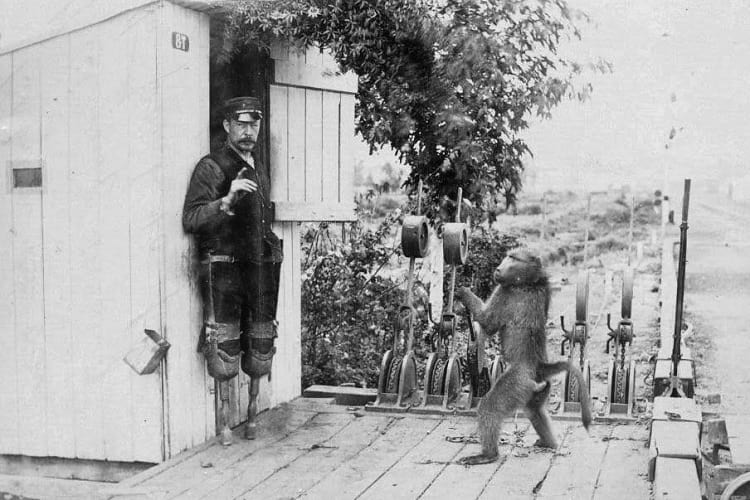
James Wide and his pet assistant Jack the baboon. (Unknown / Wikimedia Commons)
In 1890, Nature science illustrated weekly science journal published an article about a recently deceased chacma baboon named Jack. Chacma baboons are native to South Africa, Angola, Zambia, Namibia, and Mozambique, and are social animals with dog-like faces and high levels of intelligence. Jack the baboon displayed every evidence of this, and, in his nine years of service with the Cape Government Railways, remained an exemplary employee.
James Wide, the guard turned signalman
Our story begins with James Wide, who, for 10 years, worked as a guard with the Cape Government Railways. He earned his nickname ‘Jumper’ because of his penchant for jumping on and off moving trains. It was a risky habit and it was bound to land him into trouble sooner or later, and so it did. In 1877, he failed to gauge his jump correctly and slipped on a coach canvas covering and fell onto the rail tracks. The 80-ton coach that was following went over his legs, severing them just below the knees. The railway workers rescued James Wide and he survived, but with the loss of both his legs. He was a resilient fellow, however, and decided to make the best of a bad situation. After he had recuperated, he made himself a pair of wooden pegs and learned to walk on those.
He then pleaded with the Cape Government Railways to give him some other employment that would allow him to continue working with them. Being sympathetic to his plight, they gave him a post as a signalman with the Uitenhage railway station. Being a signalman entailed conveying track information to the train drivers and operating levers to change tracks to accommodate the passing trains. It was work he could do from a chair, but he did often have to get up and go out to give train drivers the key to unlock the points that allowed the train drivers to reach the coal shed. For this, the driver usually blasted four whistles as a signal, and then waited for James Wide to hobble over to him.
Aside from this, James Wide also had to travel back and forth from the cottage that the company had provided for him to live in. It was about half a mile away from the signal station hut. To save travelling time and his own energy, James Wide had devised a trolley that he could operate to take him to work every morning and back from work later in the evening.
This regimen worked for a while, but then he began to find it tiring. There was a somewhat steep hill between the cottage and the signal station hut. It was hard work using levers to pull the trolley both ways.
James Wide began to see the necessity for having an assistant.
Jack, the Chacma Baboon

Chacma baboon (Papio ursinus) are Old World Monkeys and are native to South Africa. (Bernard DUPONT / Flickr)
In 1881, on a visit to the local Uitenhage market, where hunters, merchants, and transport drivers regularly gathered for commerce, James Wide saw an unusual sight that made him pause in his tracks. An oxen wagon passed him and leading the oxen team as the voorlooper or oxen leader was a chacma baboon. The animal radiated calm confidence and seemed to know what he was doing. Amazed, James Wide sought out the oxen-cart owner and inquired about his extraordinary baboon. The owner told him that he called the baboon Jack and he was indeed an extraordinary creature. He had taught him several basic commands and Jack had quickly learned to handle the oxen wagon. With his great physical strength, he was also tremendously useful in pulling and pushing heavy loads.
Wide immediately knew that he had found his future assistant. He asked the man to let him have Jack, and the man, either moved by Wide’s disability or the high price he offered, let him take Jack with him. In parting, he told Wide to give Jack a shot of Cape Brandy at bedtime every night. Without the nightcap, he said, Jack was liable to grow morose and ill-tempered and would refuse to work the following day.
How Jack the Baboon became a railway signalman
To begin with, Wide taught Jack the baboon to push his trolley from his home to the signal station hut and back from there. Jack was happy to do the pushing and was particularly happy about the trolley trundling speedily down the incline. He liked to jump onto the trolley at this juncture and enjoy a fast ride downhill. In addition to manoeuvring the trolley, he learned to take it off the tracks when necessary and then put it back as well.

Jack pushing the trolley. (Unknown)
Through their regular interaction, James Wide realized that Jack was much more intelligent than he had first thought. Jack watched his actions carefully and began emulating them. He noticed that on hearing the four signal whistles from the train engines, Wide would go out to hand the train driver the key that opened the points that led to the coal shed. One day, when a train driver blasted the four whistles to let Wide know he wanted to load the coal, Jack seized the key before Wide could and ran over to hand it to the train driver. It must have startled the train driver no end, but Wide discovered that there was one more task he could entrust to Jack.
Soon after this, since Jack was showing such a great interest in the signalling work, Wide began training him to operate the signal levers according to the different whistles from the train drivers. These levers controlled certain sections of the railway tracks and had to be pulled in a correct order. Jack the baboon proved to be a very quick learner and was soon able to operate the levers on his own. Wide tested him a few times and Jack responded correctly to the signal whistles and changed the right tracks every time. He did not err even once in this task and he showed a tendency to recheck his work and to look at Wide to be assured that he was doing everything right.
At the station, the train drivers and the other railway employees soon became accustomed to seeing Wide and Jack working together to operate the signals. Amused passengers threw food at Jack as their train chugged along.
A lady complains about Jack
Jack the baboon settled down to his work, but everyone wasn’t amused by the sight of a baboon working the railway signals. A high society lady, who happened to be travelling to Port Elizabeth, saw Jack working at the Uitenhage station and grew indignant that a baboon could oversee matters that might affect her personal safety. She complained vociferously to the railway authorities in Cape Town. They hadn’t received intimation about their baboon employee and they refused to believe her at first. Nevertheless, to check up on things, they dispatched a system manager and an inspector to Uitenhage station.
How Jack became an official railway employee
When they saw that matters indeed stood as the lady had said, their first reaction was to fire Wide and tell him to take his baboon with him. Wide, however, pleaded with them to reconsider and his fellow employees voiced their support for both him and Jack. The baboon was the best employee the railway had, they claimed.
The manager was, of course, very sceptical, but since he had come all this way and he found the whole scenario amusing, he decided to indulge Wide and his supporters and see Jack’s skills for himself. With the assistance of a train driver issue the signal whistles, he put Jack through several stringent tests. Jack passed all the tests with impeccable results and the railway manager was won over by his competence.
He reported the matter to the railway authorities and they reinstituted both Wide and Jack back to their former positions.
Jack became the first baboon to be ever officially employed by a railway in the entire world. He received a daily wage salary of 20 cents and daily rations, and, on Saturdays, he got a bonus of half-bottle of beer and snacks. It became a common sight on Saturdays to see him seated near the cottage door sipping his beer with a great deal of pleasure.
He remained employed with the Cape Government Railways for the next nine years and, reportedly, never made a single mistake in his entire career.
He also became the railway company’s major star attraction, and tourists came from far off places just to see him operate the signal levers.
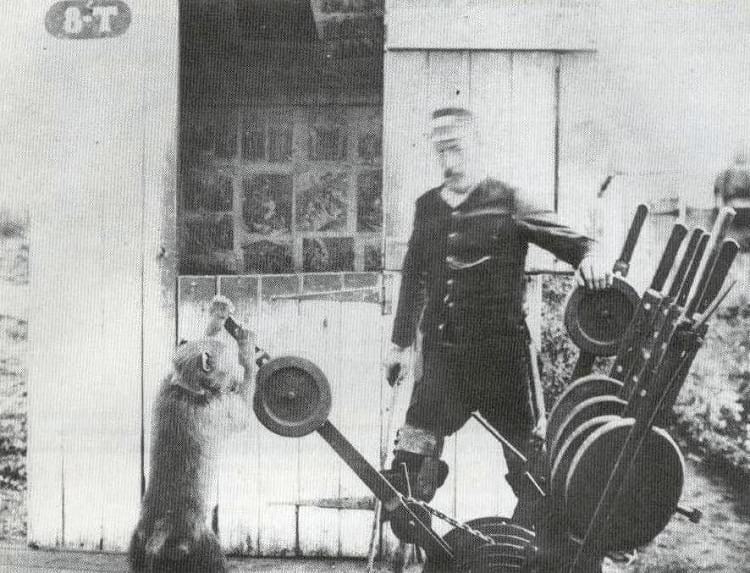
Jack the baboon, operating the lever. (Cape Archives)
Jack showed himself to be a great believer in the sanctity of work. He not only did his signalling work well, but he also volunteered for other jobs. He worked in the station garden when he could, gathered discarded railway sleepers for firewood, swept the kitchen floor in the cottage, and took out the rubbish. He was also a dedicated guard and did not allow anybody to trespass on the railway premises.
Jack’s death
In 1890, he contracted tuberculosis and died shortly afterwards. James Wide was devastated at this loss. They had lived together for nine years and he had grown very accustomed to Jack’s presence and relied on him both as a co-worker and as a companion.
The news of Jack’s death spread and his story, when published in Nature magazine, garnered a great deal of interest. Jack the baboon was gone, but not forgotten and, thanks to his fame, even some of his remains remained. You can see his preserved skull in Grahamstown’s Albany Museum.
Enjoyed this article? Also, check out “Bobbie the Wonder Dog: Uplifting Story of a Separated Dog that Travelled 2500 Miles to Return Home“.
Recommended Visit:
Albany Museum | Grahamstown, South Africa
Fact Analysis:
STSTW Media strives to deliver accurate information through careful research. However, things can go wrong. If you find the above article inaccurate or biased, please let us know at [email protected].
RELATED
The post Jack the Baboon Once Served as a Railway Employee for 9 Years and Didn’t Commit a Single Mistake appeared first on .
]]>The post Tana Toraja in Indonesia: The Celebratory Funeral Ceremonies and the Tree of Baby Graves appeared first on .
]]>
Tree burial by Tana Toraja. (Michael Gunther / Wikimedia Commons)
The South Sulawesi Province in Indonesia is home to the Tana Toraja Regency comprising of the native mountain tribe, Toraja. The Toraja people mostly follow the philosophy that all natural things have souls, also known as Aluk (the way). Their animistic belief has been given recognition by the Indonesian government as ‘Aluk To Dolo’ (way of the ancestors). The term Toraja comes from the Indonesian language Buginese word ‘to riaja’, which means ‘people of the uplands’.
In Torajan society, each village is an extended family named after the most important member’s tongkonan, a traditional house. The name of the tongkonan becomes the name of the village and also the primary place for conducting all social events. The distinct feature of a tongkonan is the boat-shaped roof, much like a sweeping arc. Torojans have become famous all over the world, attracting tourists every year, for their detailed memorial services.
The celebration of life and afterlife

Children of Toraja ethnic group during a family funeral. (Arian Zwegers / Flickr)
In Toraja social norms, the ritual of a funeral, known as ‘Rambu Solo‘ is the most important and elaborate event. A Toraja memorial service lasts for quite a few days and is typically attended by several people. The extent of the service is in accordance with the social status of the deceased.
The Aluk religion states that only the upper class can have an extensive feast along with the memorial service. It involves the preparation of a ceremonial site known as ‘rante’ with shelters for the people participating and other things needed for the last rites.
The belief of the Torajans is that death is not abrupt, but an ongoing process towards ‘Puya’, the land of souls. Death hence becomes more of a celebration of life for them and the rituals are performed as a farewell party over days. The body of the deceased is covered with multiple layers of cloth to be kept beneath the tongkonan.
The soul is said to hang around the village till all the rituals are complete and then embark on its journey towards Puya. Till the final ceremony starts, the deceased is laid down on his bed with his head in the west. This is so that whenever the sleeping person wakes up, it sees the rising sun. Family members also visit the sleeping person every day with food and drinks and sometimes sit there to chat.
Tana Toraja baby tree: The cradle graves of babies
After a long drawn out funeral ceremony, comes the elaborate burials of the Torajans. The coffin is often put in a cave, in a grave carved in stone, or hung from a cliff. The deceased are adorned with their favourite ornaments and any other possessions that they may require in Puya.
Once the burial is complete, a wooden effigy known as Tau tau is placed outside the cave. Tau taus are placed looking over the land of the village as they are known to protect the village.

Tat tau outside the stone burial site. (Kars Alfrink / Flickr)

Graves inside a large stone. (Kars Alfrink / Flickr)
The coffin of a child is hung from a cliff and babies are buried inside hollow trees. This is the smallest burial ground of the Torajan custom. If a baby dies who has not started teething, then its body is placed inside a tree.
A small space inside the trunk of a tree is hollowed out to place the body. The baby is then wrapped in cloth and placed in it. As their belief goes that all natural things have souls, so they believe that the baby becomes a part of the tree.
As the tree heals, the baby is absorbed into the tree and the soul is guided by the winds in the tree to the afterlife. The opening of the baby’s grave is covered with a door made of palm fibre. Several babies can be buried inside one tree.
The 3-year corpse fest, Ma’Nene
Every 3 years, the Torajans exhume the dead bodies of their loved ones to wash them, dress them up in new clothes and display them proudly. This is known as the Ma’Nene festival which honours the dead and shows the fact that the dead have not been forgotten. This is their way of showing respect to the dead. Another important ritual during this festival is to repair or replace the coffins for the bodies. This festival has been celebrated every 3 years for centuries now.
The unusual customs and rituals of the Toraja tribe have led to widespread intrigue over their culture. The exhaustive funeral service and other ceremonies pertaining to death have attracted hordes of tourists every year. Anthropologists have shown an increased interest in the practices of the Torajans. Since 1984, the Indonesian Ministry of Tourism has named Tana Toraja the second tourist destination after Bali in Indonesia.
Enjoyed this article? Also, check out “The Island of the Dolls: Nothing Childlike About It“.
Fact Analysis:
STSTW Media strives to deliver accurate information through careful research. However, things can go wrong. If you find the above article inaccurate or biased, please let us know at [email protected].
RELATED
The post Tana Toraja in Indonesia: The Celebratory Funeral Ceremonies and the Tree of Baby Graves appeared first on .
]]>The post Terracotta Army: An Army to Protect the Dead in Their Afterlife appeared first on .
]]>
The Terracotta army. (Xiquinho Silva / Flickr)
Over 40 years ago, in March 1974, a group of farmers in China discovered a set of life-size statues made out of earthenware called the Terracotta army, which represented the army of Qin Shi Huang, the First Emperor of China. The statues were discovered by the farmers in Xi’an city of Shaanxi province when they were digging a water well close to the Emperor’s tomb at Mount Li. It is said that the First Emperor had chosen Mount Li as his favored location to be buried at. He believed the location had good terrain as it was brimming with jade and gold mines.
Why the Terracotta army was built?
Similar to the Egyptians, the Chinese too have a belief that once someone dies their tomb is filled with gifts and items they would need for their journey and life after death. This Terracotta army was buried with the first emperor for a similar reason of protecting him in his afterlife.

Terracotta warriors. (Peter Griffin / publicdomainpictures.net)
Terracotta Army in China
When the discovery of the farmers was made public, a group of Chinese archaeologists became increasingly interested in the site. Their investigation revealed the largest group of pottery statues ever found. The set of statues that were found were just the tip of the iceberg. The entire underground area supposedly measures 98 sq. kms. It is also estimated that there were 3 pits that held these statues and have more than 8000 soldiers, a combined 650 chariots and horses. The statues there have been constructed in accordance with their role in the army. For instance, generals were the tallest whereas lower-ranking officials were shorter.

Park Geun-hye, former president of South Korea looking at the Terracotta Warriors. (Republic of Korea / Flickr)
Construction of the army
The earthenware statues were made to replicate the original army. The statues included those of chariots, horses, archers, soldiers and their different ranks like armored soldiers, unarmored infantry, cavalry men, drivers of chariots, spear-carrying charioteers, and kneeling archers amongst many more. It is interesting to note that these army figures were manufactured in workshops using the good old assembly line method. Specific parts of the body like the head, arms, legs, and torso were created separately and then assembled. The tough work of the laborers and local craftsmen is visible in the splendor that they created. They used at least 10 different molds to create the faces, upon which clay was added to make each face unique.
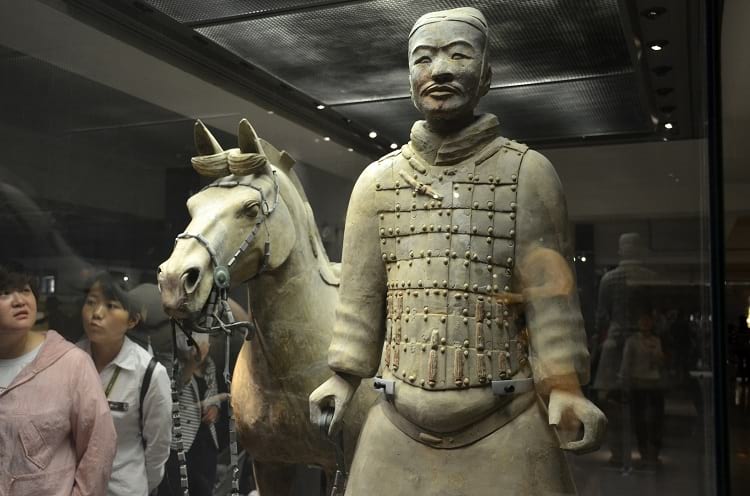
A terracotta soldier with his horse. (shankar s. / Flickr)
A lot of effort was taken to not only make the statues but also place them in the tomb. The statues weren’t just placed haphazardly instead they were placed in the precise military formation in accordance with rank and duty as a real army. In fact, the statues wore real armor and held real weapons to give them a more realistic feel. Unfortunately, a lot of these weapons were looted a little after the army was created. Other weapons seem to have decayed, even though they were coated with a chemical before burial that would protect them from ruin. Some weapons also have engravings on them displaying their date of usage before burial. The army had also been brightly painted to add to the realism. Just like the weapons, the paint too had faded away and just hints of it remain today.

A group of terracotta soldiers. (Robin Chen / Wikimedia Commons)
Attractions linked to the army
Multiple museums, consisting of an enclosed roof structure, have been constructed over the pits of the soldiers. The museum over Pit 1 is over 14260 square meters and was opened to the public in 1979. Whereas the newer museum over Pit 2 is 6,000 sq meters and was opened to the public in 1994. Recently a mini version of the Terracotta army was unearthed from a 2100-year-old pit in China. Statues in this set are as small as 20 cm and aren’t comparable to the original Terracotta army. It is believed to have been built as a toy set for a young prince and has around 500 pieces in its set. Impressively though, the statues in the mini set are arranged just as precisely as the original one.
Enjoyed this article? Also, check out “Traditional Yaodong, Shaanxi Province: The Cave Dwellings in Which Many Chinese People Still Live“.
Fact Analysis:
STSTW Media strives to deliver accurate information through careful research. However, things can go wrong. If you find the above article inaccurate or biased, please let us know at [email protected].
RELATED
The post Terracotta Army: An Army to Protect the Dead in Their Afterlife appeared first on .
]]>The post Cardiff Giant: The Colossus That Charmed and Mislead America appeared first on .
]]>
Cardiff Giant, shortly after being exhumed. (Wikimedia Commons)
The Cardiff Giant, an enormous ten-foot tall stone man-made an astonishing and newsworthy emergence out of the ground on October 16, 1869. The structure was excavated with the aid of a few workers while digging a well at the back of the barn of a farmer named William “Stub” Newell in Cardiff, New York.
Formation of the Cardiff Giant
The Cardiff Giant was the brainchild of George Hull, a dynamic and resourceful tobacconist and get-rich-quick con artist. To reap huge financial gains, the idea of the Cardiff Giant, its subsequent burial and eventually a much sensational exhumation bloomed in his mind during the course of a business trip to Iowa.
In 1867, amid a business trip, Hull got embroiled in an argument with a Methodist revivalist preacher Reverend Turk while venting opinions on a theological debate focusing on a biblical passage. Hull, being a resolute atheist, was thoroughly asserted that the Holy Bible should not be taken seriously.
On the contrary, the revivalist minister believed that the literary significance of the Bible is undeniable. He went on insisting Hull that even the phrase which says “there were giants in the earth in those days” should be thought about as nothing but factual.
This incident sparked off Hull’s vivid imagination. He conjured up the figure of a gigantic stone-made human in his mind which he could pass off in the garb of a petrified man. If executed right, he pondered, the rip-off might permit him to strike a blow against religion. He realized that he could not just use the dummy mammoth to scoff at the Biblical literalists, but make immense wealth out of the undertaking as well.
Making of the behemoth

Cardiff Giant. (Wikimedia Commons)
In the subsequent two years, Hull expended almost $3,000 to bring the mock-up into being. He started out in 1868 by visiting Fort Dodge, Iowa, wherein he secured a massive five-ton block of gypsum by way of claiming that it would be used for a statue of the late Abraham Lincoln.
Hull then transported the block by ship to a Chicago marble supplier and stonecutter who had agreed to assist with the scheme in barter for a chunk of the earnings. He created the giant statue after being sworn to maintain secrecy.
Hull posed as the model while a couple of sculptors spent the late summer of 1868 fabricating the gypsum slab into a bogus anthropological marvel. The statue evolved into a naked man lying on his lower back with his right arm clasping his stomach. His one leg intersected the other and face flaunted a puzzling half-smile.
The workers covered the exterior of the sham with sulfuric acid to give an aged, rugged look. Hull even inserted pins into the frame to give the impression of skin pores. When completed, the pseudo giant stood over 10 feet tall and weighed almost 3,000 pounds.
The giant’s faux graveyard
The figure was then shipped to the village of Cardiff in New York through a secret mission. It was positioned in a pit and blanketed with soil. The property belonged to William “Stub” Newell, a farmer and distant relative of Hull.
On 16th October 1869, Newell, who too was tightlipped in an outright greed of the imminent riches, employed two unsuspecting workmen to dig a well. He ordered them to dig the ground closely at the spot wherein the giant was buried, and the workers thus made their startling discovery.
Discovery of the interred giant and subsequent euphoria
As the news of this discovery spread, hundreds of spectacle-watchers and amateur archaeologists started rushing to the discovery site to seek a glimpse of the giant and understand what the confusion was all about.
And despite the fact that the giant was downright a poorly finished creation, people were wonderstruck with sheer amazement by a way of the probability that it was real. Throughout the entire social prism ranging from farmers to the pre-eminent truth seeker like Ralph Waldo Emerson (American philosopher), everyone expressed admiration and astonishment while looking at the huge stone sculpture.
Controversy and exchange of views on the giant’s veracity
Archaeological surmised that the superhuman bust was a complete faux. A few geologists even discerned that they could not gather any appropriate and exact motive to attempt in digging a well precisely at that specific spot from where the giant was uncovered. Some of the theologians and preachers, on the contrary, vindicated its authenticity.
In Syracuse, the monstrosity was subject to a careful and focused scrutiny. Othniel C. Marsh, a palaeontologist from Yale, called on the statue and declared it an inept and phoney object. He further mentioned that the chisel marks were still visible on it. These should have eroded if the giant had been cloistered within the ground for a considerable length of time. However, the public appeared to care little about the fact that it was, in reality, a fake. They continued coming in numbers to witness it anyway.
Replica of the Cardiff Giant
The mammoth structure was auctioned off to a team of businessmen headed by David Hannum for $23,000. From then onwards, the giant embarked on an expeditious tour around Syracuse in New York. Soon, the ever-burgeoning popularity of Cardiff caught the attention of famous circus stage manager and showman P.T. Barnum. He engaged in many rounds of discussions and negotiations with the businessmen to purchase the gypsum-made cash cow for $50,000. But eventually, the deal did not happen. Barnum mustered up the courage to fabricate a replica of Cardiff Giant.
He commissioned a sculptor and started showing it off to the general public at a Manhattan museum as the bonafide piece. He amassed deep fortunes in the arrangement. He claimed that the actual Cardiff Giant owned by the syndicate was a counterfeit entity.
Cardiff Giant resting in peace at the Farmers’ Museum

Cardiff Giant at the Farmers’ Museum. (Martin Lewison / Flickr)
The Cardiff Giant was put on display at the Pan-American Exposition held in the year 1901. However, it attracted very little attention and the response was much less impressive than expected.
Later, Gardner Cowles, Jr., an American businessman bought the statue to enhance his recreational room. In 1947, he sold the structure to the Farmers’ Museum in Cooperstown, New York.
Therefore, after spending nearly 79 years rambling through the United States like a vagrant, the Cardiff Giant finally returned to its roots on 18th May 1948 and was redeemed as a museum showpiece. The ‘petrified man’ is currently on permanent display at the Farmers’ Museum following its acquisition by the New York State Historical Association for $30,000 and the Barnum’s replica is an exhibit at the Marvin’s Marvelous Mechanical Museum in Farmington Hills, Michigan.
Enjoyed this article? Also, check out “Spaghetti Tree Hoax: When BBC Convinced a Million Viewers That Spaghetti Came from Trees“.
Recommended Visit:
1. The Farmers’ Museum | Cooperstown, New York, USA
2. Marvin’s Marvelous Mechanical Museum | Farmington Hills, Michigan, USA
Fact Analysis:
STSTW Media strives to deliver accurate information through careful research. However, things can go wrong. If you find the above article inaccurate or biased, please let us know at [email protected].
RELATED
The post Cardiff Giant: The Colossus That Charmed and Mislead America appeared first on .
]]>The post Water Wives of India: Denganmal in Maharashtra, Where Men Have Multiple Wives to Fetch Water appeared first on .
]]>
An Indian women carrying water taken from a well. (Dylan Walters / Flickr)
Water is a basic necessity and one of the most important elements present on Earth. However, every continent today is facing water scarcity in some form or other during a certain period each year.
Many people all over the world do not have access to clean drinking water and sometimes, even water. This situation is seen, year after year, in drought-hit areas of India. Maharashtra is one of the states in the country where several districts experience drought, every year. One village came up with an unusual solution to the shortage of water – indulging in polygamy. Having more than one wife to procure water, termed as the ‘water wives’.
The tradition of ‘water wives’
A small village in the western province of Maharashtra, Denganmal, is a parched land surrounded by rocky terrain. With a population of roughly 500, the village has no water pipeline connections. Add to it the fact that it lies in the region which experiences drought in the hot summer months.
Cut off from other villages, the only source of water available to the villagers is the Bhatsa dam on a river or a well. Both are situated so far away that, a to-and-fro journey takes nearly 12 hours. Not only is the trip arduous and long, but also time-consuming, leaving little or no time for other chores.
Most men of this village, are farmers or farm hands. With the men away from home the entire day, all household chores fall upon the woman. Taking care of children, cleaning, cooking, and other everyday jobs become impossible to attend to by the women if fetching water takes up most of their day. Moreover, the women and children are also expected to help out in the farms during the cropping season, July to October. This led to the most convenient solution at hand, marrying another woman whose sole responsibility is to fetch water for the entire family. Hence the term, ‘water wives’ or, as they are more commonly referred to, ‘paani bai’.
The exigent life of a ‘paani bai’: boon or bane?
As per the government’s estimate, more than 19,000 villages in Maharashtra did not have any access to water in 2014. Each year, the situation only gets worse. In 2018, Maharashtra Chief Minister Devendra Fadnavis in his Independence Day speech claimed that the state government had successfully made 16,000 villages drought free out of 25,000 villages. Having achieved this under the Jalyukt Shivar Abhiyaan (farm full of water scheme), Maharashtra will be drought-free by 2019, according to him.
Meanwhile, people of this small village have chosen the ‘paani bais’ to resolve their problem of water scarcity. The water wives leave at sunrise, trudging through the rocky terrain, through the hills, to the river or well; all this in the smouldering heat of summer. Each vessel holds 15 litres of water and each woman carries 2 to 3 such vessels.
The first wife is the lady of the house who shoulders the responsibility of bearing children, taking care of their needs, other household chores and duties. Whereas, the water wife is often, either a widow or, an unmarried woman whose dowry could not be afforded by her family. These women lead an ostracized life in the Indian society, discriminated and not allowed to participate in social norms. By becoming water wives, they regain their marital status and are accepted as a part of the society, again. Whether it is a boon for them or not, is something that does not cross their minds, as long as they are provided for and accepted in the family.
A tale of three wives
The largest family in the village is of Sakharam Bhagat. Along with his first wife Tuki, he has six children, three sons and three daughters. Quite evidently, it became increasingly difficult for Tuki to manage the water procurement with a growing family. Being away from home and children for 12 hours a day was definitely not feasible.
Sakharam approached Sakhri, who had been deserted by her husband. The arrangement being that in lieu of a respectful marital status and her needs taken care of, Sakhri would fetch water for the family.
Sakhri would diligently traverse the distance to ensure there was sufficient water every day, for the household. Being a part of a large family of 9 people, there were days when she was getting nearly 100 litres of water in one day. Unfortunately, age began to take its toll on Sakhri and she gradually found it difficult to execute her daily water task. Sakharam decided to take in a third wife, a young widow of 26, Bhaagi, became a part of the household as a water wife, and Sakhri started helping out on the farm.
The village panchayat saw no reason to object as it meant the start of a normal respectful life for the two women who had otherwise been cut off from society. Moreover, Sakharam was not the only man to have more than one wife. There were others in the village who were known to indulge in the practice of a ‘paani bai’. Though she is looked after by the husband and his family, she has no share in his property.
The one thing that keeps an unusual family like this, together, is water.
Enjoyed this article? Also, check out “The History of Breast Tax and the Revolt of Lower Cast Women in 19th Century Travancore“.
Fact Analysis:
STSTW Media strives to deliver accurate information through careful research. However, things can go wrong. If you find the above article inaccurate or biased, please let us know at [email protected].
RELATED
The post Water Wives of India: Denganmal in Maharashtra, Where Men Have Multiple Wives to Fetch Water appeared first on .
]]>The post Rat King: The Horrendous Wheel of Animal Suffering appeared first on .
]]>
Preserved rat king from 1895 Dellfeld, Germany. (Edelseider / Wikimedia Commons)
A visit to the Mauritianum Museum in Altenburg, Germany might give you an absolute shudder of fear and revulsion at the spectacle of a mummified assembly of 32 rats conjoined at their tails and forming a large entanglement of a gargantuan turbo-rat.
The phenomenon popularly coined as the “rat king” survives in its malformed and outrageous intermixing until being killed or devoured by a predator. Surely rat kings are not like the cute and lovable pet rats in a go-as-you-like contest. In actuality, whatever we are aware of rat kings is the stuff that all bad dreams are made of.
Initial sightings
The earliest sightings of a rat king (25 rats) happened in the year 1564 and predominantly from Europe in countries like France, Netherlands, Poland and Belgium. Germany though was a specific hotspot, for no good reason. The disparaging German term “Rattenkonig” was plentifully used all through the next couple of centuries to denigrate people who were looked upon to be parasites.
Back in those days, rats were vilified as the harbingers of plague. They had been condemned for the devastating Black Death that originated in Medieval England and killed nearly 1.5 million people.
The occurrences might have plummeted with the displacement of the black rats (R. rattus) by the brown rats (Rattus norvegicus) sometime in the 18th century. Most existent specimens of rat kings are found to be formed from black rats or ship rats. Moreover, the happenings of black rats forming rat kings are widely documented all over the world. The only other small mammal species to have exhibited a kindred phenomenon are the squirrels.
Samples corroborating the existence of rat king
Rodent experts refuse to acknowledge the theory of the rat king, claiming it to be only a myth. However, there is a possibility that a huddle of ace and clasping tails could get themselves entwined. With the presence of a binding substance like sebum, which is oily and sticky and gets secreted from the skin of the rats, the knot might become inseparable. Even urine or faecal matter could have aggravated this fusion.
A rat king is on display at New Zealand’s Otago Museum. It was discovered in the 1930s by some clerks at a shipping facility when a mass fell onto them from the overhead roof beams. One clerk struck the twitching mass with a fork and killed it. The dead specimen eventually made its way into the museum where it is safeguarded in a big jar that contains the eight rats floating in a yellowish preserving liquid.
Another rat king is on display at Mauritianum Museum, Altenburg, Germany. The demonstration has an embalmed assembly of 32 intertwined rats. The specimen was reportedly discovered close to a miller’s fireplace sometime in 1828 in Buchheim, Germany.

Rat king on display at Mauritianum Museum. (Naturkundliches Museum Mauritianum Altenburg / Wikimedia Commons)
Recent Sightings
In a more recent sighting, a rat king consisting of 16 rats was allegedly discovered on 16th January 2005 by an Estonian farmer inside a pit. By the time he located the twisted interlacing, half of the rats were already dead.
Discovery of a squirrel-king
In 2013, in a similar discovery, a “squirrel king” comprising of a dray of six squirrels generated a lot of hullabaloo in Saskatchewan, Canada. This time researchers blamed the pine tree sap juice as the fixative. The squirrels were unravelled by veterinary doctors. In 2018, five squirrels that were chanced on connected by their tails in Wisconsin were successfully separated by veterinarians.
How do rat kings form?
If conjectures about the real existence of the rat kings are to be trusted, rats simply conjoin together while getting confined in a little space like a burrow or congested dwelling quarters. Another theory surmises on the rodent cohorts attempting to keep themselves warm during the winter season and thronging together thereby yielding the union.

Rat king at Natural History Museum of Nantes., France. (Selbymay / Wikimedia Commons)
Although the sightings of rat kings are debatable to a certain measure, the notion that the tails of an army of rats could get adjoined and entangled is true. As mentioned earlier, the sebaceous glands ooze a glutinous binding agent to keep their skin moisturised. The substance also enables their steady and fast movement amid the tight confines by greasing up the surfaces. The tails remain equally hydrated and ultimately become shackles for the rats thriving in the close vicinage.
Sometimes dirt, blood, urine or faeces are also believed to jointly bind the tails. Also, black rats can climb up and hence their tails have enhanced grasping ability which engenders a strong collaborative hold inside their nests.
Enjoyed this article? Also, check out “Goblin Shark: The Alien Shark of the Deep Sea, with a Slingshot Mouth“.
Recommended Visit:
Mauritianum Museum | Altenburg, Germany
Otago Museum | Dunedin, New Zealand
Natural History Museum of Nantes | France
Fact Analysis:
STSTW Media strives to deliver accurate information through careful research. However, things can go wrong. If you find the above article inaccurate or biased, please let us know at [email protected].
RELATED
The post Rat King: The Horrendous Wheel of Animal Suffering appeared first on .
]]>The post Safety Coffin: The Ingenious Ways to Avoid and Remediate Premature Burials appeared first on .
]]>
Safety coffin: Oil painting of hurried burial. (Antoine Joseph / Wiertz Museum)
Born on October 22, 1830, in Manchester, William Tebb was a British businessman and a social reformer. Tebb was famous for his research and concern about premature burial. Along with Gloucester general practitioner, Walter Robert Hadwen, he co-founded the London Association for the Prevention of Premature Burial in 1896.

William Tebb. (Wikimedia Commons)
Premature burial was widespread in those days due to mistakenly being declared dead. In 1905, Tebb researched premature burials and found 219 cases where people were on the verge of being buried alive, 149 cases of people having been buried alive, and 2 cases of people having woken up during the process of embalming.
This resulted in a fear of being buried alive amongst people. It also led to a psychological disorder, taphophobia or ‘fear of graves’. William Tebb and Walter Robert Hadwen along with doctor Edward Perry Vollum (who had a near-buried-alive experience), published a book, Premature Burial: How It May Be Prevented, in 1905. The book dealt with accounts of live burials and how they could be prevented.
The creative ways to rectify premature burial
The fear of premature burial was on the rise during the outbreak of cholera in the 18th and 19th centuries. However, there have been reports of people being buried alive much before the 18th century.
A general practice started to develop, to have a waiting period before burial to confirm the death. When Dr. Robert Robinson, an English Dissenter minister of the Protestant Christian community died in 1791, he had given instructions to prevent his accidental premature burial. He was buried with a movable glass pane on his coffin and a mausoleum with a door, to be checked from time to time by a watchman to confirm his death. He even left instructions with his relatives to check in on his grave.
The advent of the safety coffin
The first safety coffin was designed by Duke Ferdinand of Brunswick-Wolfenbüttel, who suffered from taphophobia. Before his death on July 3 in 1792, he got his coffin constructed with a window for some light and a tube for the supply of fresh air. The lid of the coffin was not to be nailed in. Instead, it was fitted with a lock, the key to which was kept in a pocket of his shroud. His shroud also had the key for the lock on the tomb door.
German priest, P.G. Pessler suggested in 1798 that all coffins should have a cord attached to the church bells so that upon tugging the cord, someone or the other was sure to hear the church bells ringing. This idea led to the various designs of safety coffins with a system to signal life. Pastor Beck, a colleague of P.G. Pessler went so far to suggest a trumpet-shaped tube attached to the coffin to be checked for decaying odours by the local priest on a daily basis. In case of no odour, the grave could be dug up to rescue the not-dead person.

Count Karnice-Karnicki’s safety coffin with a lever to raise the flag. (Wellcome Collection)
Several decades later, in 1822, Dr. Adolf Gutsmuth voluntarily allowed himself to be buried alive to exhibit the efficacy of his safety coffin design. He stayed buried for a long stretch of time, all this while having food transported by his assistant to him inside the coffin through a feeding tube. He effectively consumed a meal of soup, sauerkraut, sausages, spätzle and beer. He finished his antics off with a cake, all delivered through the feeding tube of the coffin.
In 1829, Dr. Johann Gottfried Taberger created a system with strings attached to the person’s hands, feet and head. These strings were attached to a bell above the grave, weatherproofed in a small structure. If the bell rang, the watchman would insert a second tube providing fresh air to the person till the coffin could be dug out.
The ideas for safety coffin started developing to enable the buried person to signal the world that they were alive. The most common was a cord placed in the hand of the buried person, attached outside to a bell. There were sensor detection contraptions developed which would light a candle on top of the grave to signal life. Some safety coffins had an inbuilt telephone.

A premature burial vault prototype. (“Popular Mechanics” Magazine 1921)
Safety coffins were a rage from the late 1800s to early 1900s with several companies having patented their designs. In Germany alone, nearly 30 or more safety coffin patents were registered during the late 1800s whereas America had 22 patents registered from 1868 to 1925.
Franz Vester developed the ‘Burial Case‘ in 1868. This safety coffin had a wide tube through which the face of the buried person could be viewed from time to time for any signs of life. The safety coffin patented in 1995 by Fabrizio Caselli incorporated an emergency alarm, an intercom, torch, breathing apparatus, along with a heart monitor and stimulator. Such inventions went on till the late 1990s, though there hasn’t been any proof of anyone benefitting from them.
The grave with a view in Vermont
Probably the eeriest of safety coffins is the one of Dr. Timothy Clark Smith at the Evergreen Cemetery in New Haven, Vermont in the United States. With a severe case of taphophobia, Dr. Smith designed his own grave.
He had a glass pane put on the surface of his grave directly above the place where his head would rest in the coffin. This would allow people to check on him from time to time for signs of breathing. He is said to have been buried with a breathing tube, a bell and tools to enable his getaway in case he was buried alive. He also got stairs constructed leading to an opening in the ground, just next to his grave, which is covered with a removable slab.
Enjoyed this article? Also, check out “Edinburgh’s Miniature Coffins – The Mysterious Lilliputian Coffins, Discovered in Scotland“.
Fact Analysis:
STSTW Media strives to deliver accurate information through careful research. However, things can go wrong. If you find the above article inaccurate or biased, please let us know at [email protected].
RELATED
The post Safety Coffin: The Ingenious Ways to Avoid and Remediate Premature Burials appeared first on .
]]>The post Resolute Desk: The US Presidential Office Desk Was Made From an Abandoned Ship appeared first on .
]]>
Obama behind the Resolute desk in the oval office, 2009. (Obama White House / Pete Souza / Flickr)
The White House is one of the most iconic buildings of the world and it is also where the President of The United States resides as well as holds office from. Right from former president William Taft to the current Donald J. Trump, the first men of the country have been holding office right here inside the White House.
And what makes the Oval Office even more special is the large Resolute Desk that forms the main piece of furniture in one of the most powerful offices of the world. But did you know that this centrepiece in the US President’s office is nothing but a ‘tragic’ gift from the British royals? The desk that the US president uses for official purposes comes straight out of an abandoned British ship that had gone to explore the Arctic in the mid-1800s?
History of HMS Resolute
In the year 1810 Thomas Smith Jr. and William Smith, along with their father Thomas Smith Sr., started a shipbuilding business in Newcastle, England. There the Smiths built the HMS Resolute by 1848, which initially went by the name Refuge and was later known as Ptarmigan.

Portrait of Sir John Franklin. (William Derby / Library and Archives Canada)
During this time, not enough territory in the Arctic Circle was explored. By the turn of the nineteenth century, British Royal Navy officer Sir John Franklin left on a voyage in 1845 to explore the Canadian-Arctic passage, also known as the Northwest Passage. But he was never heard from again, nor did his crew members ever return home.
Concerned of their whereabouts, three years later, Her Majesty’s Government sent six ships out to sea to bring back Sir Franklin or any news regarding his location. Out of these six ships, the HMS Resolute, which the British purchased from the Smiths in 1850, was also sent out for Sir Franklin’s rescue.
After the deal went through, HMS Resolute – a barque (meaning it had three or more masts) sailing ship – was remodelled in London and fitted with strong English oak wood, a polar bear figurehead and a central internal heating system to keep the ship warm in the icy Arctic weather. On its maiden voyage, under the flagship of Captain Horatio Thomas Austin, Resolute found Franklin’s winter camp near Beechey Island in the Canadian-Arctic archipelago in 1851.
She returned home bearing Sir Franklin’s tragic news in 1852 and was then placed under the command of Admiral Sir Edward Belcher. She journeyed across the oceans with Sir Edward and it was also with him that the Resolute went on her last trip to the Arctic.
What was the Franklin search expedition?
Sir Edward Belcher was handed over with the dual responsibility of the Arctic Expedition and also the impossible task of finding Sir Franklin and his missing ships. Sir John Franklin had gone to explore the Northwest Passage, but along with his crew, he had starved to death after their ship became icebound in 1846.
After Sir Belcher’s thorough scouring of the seas in the east, west and north did not bear fruit, he turned south, where through the discovery of Sir Franklin’s definitive traces and expedition records, proved that the entire crew had perished. Post this incident, Sir Edward Belcher went on many expeditions of the Arctic, exploring the Northwest Passage, making significant discoveries in the course of time.
Last voyage of HMS Resolute
While on their ocean journey in 1854, Sir Belcher and his crew experienced a very harsh winter, which made living conditions in the Arctic almost inhospitable for humans. Supplies and fuel were quickly running out and ice floes had begun floating closer into the seas. The crew members started suffering from illnesses and were incapable of going farther any longer. It was then that Admiral Edward Belcher took the tough decision to abandon some of his ships, which had slowly started to become icebound. After HMS Resolute got locked in the floe, Sir Belcher ordered his crew to get on board HMS North Star and return safely to England with two relief vessels, abandoning HMS Resolute in the rough Arctic weather.
A year later in 1855, after the thawing of the Arctic floes, HMS Resolute drifted some 1900 kilometres into Baffin Island in Canada, where an American whale-catching vessel named George Henry found her in an abandoned condition. She was taken to Connecticut, where she was refitted and restructured to repair all the damages to its wooden body.
Resolute then sailed to England to be presented to Queen Victoria as a gift of respect and harmony in the year 1856. HMS Resolute later served in the Royal British Navy for twenty long years, never once leaving her home territory. It was finally in the year 1879 that she was no longer of service and was torn apart for her fine oak wood.
The Resolute desk
After the salvage work came through, the Queen ordered that the timbers of the Resolute be used to make three desks – one of which was to be presented to the American President as a token of appreciation. Came to be known as The Resolute Desk then on, it was gifted by Queen Victoria to the nineteenth US President Rutherford B. Hayes in 1880.

Caroline and & Kerry Kennedy hiding inside the Resolute desk. (Harold Sellers / www.jfklibrary.org)
A message was inscribed on the plaque of the desk, along with the Presidential Seal, which adorn the heavy piece of furniture. The Resolute Desk has since then been a part of the White House, serving in various rooms of US presidents. One of its usual places remains the Oval Office, where it serves as the main desk of the US president, from where he carries out most of his official duties. President George H. W. Bush had moved the Resolute Desk in his private study during his tenure once, while President Lyndon Johnson had sent the desk to Boston as an exhibit at the Kennedy Presidential Library.
President Jimmy Carter brought it back into the Oval Office in 1977, where it permanently sat thereafter. Apart from former presidents Franklin Roosevelt, John F. Kennedy, Ronald Reagan, Bill Clinton, George W. Bush and Barack Obama, current US President Donald Trump has been using the presidential desk, which was made from a ship that once travelled to the Arctic for relief and rescue operation.

Close up shot of the Resolute desk. (Obama White House / Pete Souza / Flickr)
A lot of replicas of the Resolute Desk have come to be a part of pop culture recently. But the one in the Oval Office, which in its long and fruitful time was only modified twice to suit the needs of one of the most influential persons in the world, has become one of the most recognized pieces of furniture across the globe.
Enjoyed this article? Also, check out “HMS Terror: A British Warship That Was Lost for Over 170 Years“.
Fact Analysis:
STSTW Media strives to deliver accurate information through careful research. However, things can go wrong. If you find the above article inaccurate or biased, please let us know at [email protected].
RELATED
The post Resolute Desk: The US Presidential Office Desk Was Made From an Abandoned Ship appeared first on .
]]>The post Codex Gigas: The Dark Medieval Manuscript Dubbed as “The Devil’s Bible” appeared first on .
]]>
Life size replica of Codex Gigas. (Michal Maňas / Wikimedia Commons)
While there are many things in history that have the potential to completely captivate our imaginations, and drive our sense of amazement, there are very few happenings that leave us feeling entirely perplexed, and in consequence, in complete awe. The story of the Codex Gigas is one such happening. For over 700 years, this book has fascinated scholars all across the globe, with time only adding more questions than answers.
In literal terms, the Codex Gigas translates to “Giant Book” in Latin. Apart from being famous for being the largest book to exist from medieval times, it also gained immense recognition for its contents. Some scholars believed that the book was written by the Devil himself, and have hence, dubbed it “The Devils Bible”. The manuscript measures about 3 feet tall, a foot and a half wide, and about 8.7 inches thick. Additionally, it weighs a staggering 165 pounds.

Photo of the actual “Codex Gigas” taken from a stereoscopic camera. (National Library Of Sweden)
The origin of this book still remains unknown. In this regard, the only indication of its age, and where it comes from, is thanks to a note tucked into the pages of the manuscript. According to this note, it is said to have been written at the Monastery of Benedictine in Bohemia (present-day Czech Republic) in the year 1295.
Eventually, the book found its way to another monastery in the town of Brevnov, near Prague. From here, it only reappears in scriptures some 300 years later, when Rudolf II, the Emperor of Rome took the book to be studied by his court to his castle in Prague. This is where it remained for about half a century, until July 1648.
During what would be the final clashes of the famous Thirty Years’ War, the Swedish army plundered the city of Prague, and stole the book, among many other treasures, bringing it back with them to Stockholm. Here, it became part of Queen Christina’s personal collection, until being relocated to at the National Library of Sweden in Stockholm in the eighteenth century.
Codex Gigas: The contents of the book
As mentioned previously, apart from the peculiar nature of its origins and size, scholars across the globe have been rather enthralled by the contents of the book. Aside from containing the entire Latin Bible, the book also contains some other popular writings of the time, including other religious writings, some reference books, and medical texts.
Basically, the book appears to try and capture all the world’s knowledge at the time, in it. In addition, the Codex Gigas also gets its name from a rather strange, full-page image of Lucifer, the fallen angel. The image has the devil sitting in a crouching position, as if ready to jump out of the page at the reader. He has been portrayed with a green face, piercing red eyes, the characteristic red horns, and two red tongues.

The infamous photo of Lucifer from the manuscript. (Per B. Adolphson / Wikimedia Commons)
But why does this picture exist in the first place?
Well, according to the legend, a monk from the Benedictine monastery was to be walled up alive (a common punishment at the time) for breaking his vows, and bringing shame to the monastery. To make up for his sins, the monk decides to create a book that contained all human knowledge at the time, in an effort to bring glory to the cloister he disgraced. The monk promises to complete the book within the night, however, as time progressed, he realizes that the task is pretty much impossible.
The story goes, the monk seeks the help of the devil to help him accomplish the task. The devil gives the monk the power to create the book from start to finish in one night, and from his help, the monk created an image of the devil as a homage. Some believe that the devil wrote it all by himself and signed it with his portrait.
Despite how the book came to be, it really is a remarkable literary and visual feat. To this day, everyone who comes to see it is completely enchanted by the sheer volume of the words, and extant beauty of the imagery.
Enjoyed this article? Also, check out “The Unsolved Mystery Behind the Devil’s Tramping Ground in North Carolina“.
Recommended Visit:
National Library of Sweden | Sweden
Fact Analysis:
STSTW Media strives to deliver accurate information through careful research. However, things can go wrong. If you find the above article inaccurate or biased, please let us know at [email protected].
RELATED
The post Codex Gigas: The Dark Medieval Manuscript Dubbed as “The Devil’s Bible” appeared first on .
]]>The post Mowgli was Real: Dina Sanichar, the Indian Boy Raised by Wolves appeared first on .
]]>
Dina Sanichar photo from a newspaper. (Coll. Serge Aroles / Wikimedia Commons)
Mark Twain once said, “Truth is stranger than fiction“! It is also the belief that fiction has its roots in reality and often one has influenced the other. Do the words “man-cub” sound familiar? These words were used to describe the famous character, Mowgli of Rudyard Kipling’s The Jungle Book written in 1894. It was all about a boy or “man-cub” who was raised by wolves in a forest in India.
Discovering the Dina Sanichar, the feral child
Rewind to 1867. Location: A forest in the Bulandshahr district of Uttar Pradesh in India. A group of hunters froze in their tracks, unable to comprehend the vision in front of their eyes. A pack of wolves running in the forest had amongst them an extraordinary being. A part of the pack was a 6-year-old-boy walking on all fours. The wolves had adopted and raised the boy.
There have been several incidents in the history of infants raised by animals in the wild. Such children are known as feral children. The term feral child technically is for a human child who has lived in the wild or cut off from civilization. Some are locked up by another human being with no human contact. And some grow up in the wild, probably raised by animals. These children not only lack basic social skills but also have trouble walking upright.
The hunters saw this unnatural family go into a den and decided to extract the feral child from there and take him back to civilization. They smoked the cave and had to kill the female wolf to capture the boy, whom they took to the Sikandra Mission Orphanage near Agra in India. He was baptized at the orphanage, run by Father Erhardt, a missionary living in India, and since it was a Saturday, he was thus named Dina Sanichar, Hindi for Saturday. It has been documented Father Erhardt observed, “He cannot talk, and though undoubtedly pagal (imbecile or idiotic), still shows sign of reason, and sometimes actual shrewdness”
What do we know about feral children?
Eminent child psychologist, Wayne Dennis noted in his paper, The Significance of Feral Man, in the 1941 American Journal of Psychology, several characteristics of a feral child/man derived from studies. According to Dennis, feral children (man) were untidy and uncivilized in their habits of eating. He also considered them incapable of forming bonds with humans and fairly oblivious to temperature changes. Though this was true for most feral children, Dina Sanichar established a close relationship with another feral child brought to the orphanage on March 5, 1872. Father Erhardt observed, “A strange bond of sympathy attached these two boys together, and the elder one first taught the younger to drink out of a cup.”
Sanichar was not the only wolf child to be rescued. There were cases of four other wolf children found in various parts of India around that time, and many more cases of feral children surfaced in the years to come. In fact, the discovery of feral children all over the world has been a significant topic of study and discussion.
When a feral child was found in Aveyron, France in 1800, a young physician, Jean-Marc Gaspard Itard named the boy Victor and observed him for five years, developing innovative ways to teach him speech. Victor became the subject around whom eminent scholars and psychologists debated and tried to decipher the differences between civilized man and wild animals.
Many people noticed that Victor’s behaviour was uncivilized and more in tandem with the behaviour of wild animals. It was, similarly, observed in many feral children that they displayed behavioural likeness with wild animals as opposed to people of a civilized society.
Sanichar, in the same way, growled and grunted like a wolf, walked on all fours, ate raw meat, sharpened his teeth by gnawing on bones like an animal and detested wearing clothes. People of the orphanage tried to work patiently with him to rid him of his wilderness, and with the passing of time, he became more open to eating cooked food and wearing clothes but showed no progress in speech. Though he wasn’t mute, he only made animal noises.
Studies have shown that feral children cannot incorporate the norm of the society, thus continue to live in a black hole between civilization and wilderness. They say the bridge between the two is language. It was later analyzed and concluded by researchers that apparently, there is a “critical period” for learning a language. If during that period, there’s no form of communication, it is almost impossible to grasp words or comprehend speech.

Dina Sanichar. (Photos of the Past / Flickr)
Avram Noam Chomsky, known as “the father of modern linguistics“, in his 1957 publication Syntactic Structures, wrote that it is a language which enables human experience. According to Chomsky, if people knowing no language are deserted on an island, they would generate a language of their own in a couple of generations.
In his book, Wolf Children and the Problem of Human Nature, philosopher Lucien Malson wrote that Sanichar had put together “cruder, less specifically human” forms of communication. Like many other feral children, he was prone to barking, growling, howling and attacking; probably picked up from the actions of the animals he lived with.
Death of Dina Sanichar
Dina Sanichar lived a short life, dying at the young age of 34. He lived in the orphanage his entire life, showing very little improvement. He could stand erect and walk, dress with a little difficulty, and could monitor his cup and plate. And he had also learned to eat from a plate but would always sniff his food before putting it in his mouth and steered clear of anything that was not meat. Sanichar eagerly took up one human habit, smoking, and turned into a chain smoker. It is speculated that he died of tuberculosis in 1895.
Do you think Rudyard Kipling’s Mowgli could have been inspired by Dina Sanichar?
Enjoyed this article? Also, check out “Victor of Aveyron – The Feral Boy from France“.
Recommended Read:
Wolf Children and the Problem of Human Nature | By Lucien Malson
Fact Analysis:
STSTW Media strives to deliver accurate information through careful research. However, things can go wrong. If you find the above article inaccurate or biased, please let us know at [email protected].
RELATED
The post Mowgli was Real: Dina Sanichar, the Indian Boy Raised by Wolves appeared first on .
]]>The post Can There Be a Better Closure to Old Age than Exile of Ubasute? appeared first on .
]]>Ubasute: Folklore
There was a king, says a Japanese folk story, who hated the old and mandated that all above 70 men and women be left to die on a hilltop in a thick forest range. This set into motion the practice of Ubasut. One minister, who loved his mother immensely, secretly trespassed this dictate. He hid his mother underground in the house instead of deserting her to the killing hilltop. The King then faced a critical challenge from a hostile neighbour to solve a riddle failing which he would be attacked and enslaved.
The petrified King sought help of the minister. The riddle/challenge was to inspect a pair of horses and tell offspring from the parent. Both horses looked alike and it was hard to say who was the father and who was the son. The minister apprised his aged-underground mother with the problem and sought her advice in finding a solution.
Mother suggested: Lay green fodder between 2 of them, one that steps back to let the other eat is the father. The man conveyed the solution to the King and he acted accordingly, resulting in the identification of the horses as demanded of him. King felt grateful as the cerebral exercise saved his kingdom. But at the same time he suspected that his minister couldn’t have solved the puzzle on his own. There seems to be some other brain behind the solution, said the King.
The minister confessed that it was her aged mother and that he was guilty of trespassing on the practice of Ubasute. King was so impressed that he banned the practice of Ubasute outrightly. And realization dawned on everyone that the elders have a reliable intellect and hence they shouldn’t be gotten rid of in spite of their sick and weak physical frame.
Ubasute: Outside Japan
Not just in Japan, problems of the elderly, as reflected in folklores worldwide, are the same everywhere. Moral of the stories is also the same, that the elders must be loved and cared for. In an altered version of the above story, riddles asked to be solved are different.
Surprisingly, the origin of these folklores is India. It is believed that the Buddhist monks were instrumental in spreading of these stories to the outside world. Of many such stories popular in Indian households, one is about a lovelorn youth. His lady love charged him to bring his mother’s heart as a gift for her. Then and then only would she marry him.
Blinded in her love, the youth kills his mother and removes her heart as a trophy to be presented to his sweetheart. On way, the boy stumbles over a pothole and falls down. Mother’s heart is flung aside and as the boy moves to pick it up, it comes to life and says: Son, I hope you aren’t hurt. The message obviously hits home poignantly for the protagonist of the story as well as the masses who heard these ballads from generations to generations.
In another Japanese story, a man returns from hill top after dumping his old mother but the sun has set and he loses his way down. Just then his glances at the spread of broken twigs and leaves on way. He recalls that on way up his mother was consistently snatching at foliage overhead and scattering it on the way he trudged. By connecting with the green spread on way he could work out the lost path and that rang a bell: I took my mother on way to death, even then she took care to ensure my safe return to home. Overcome with emotion, the boy ran back to his mother, picked her up and brought her home.

Painting of a man carrying an old woman on top of the hill to be abandoned. (Yoshitoshi / Wikimedia Commons)
The larger perspective of ubasute, it seems, is dedicated care for the elderly. Does it lie in putting them on way to speedy death? Many choose death (even assisted suicide) to prangs of debilitating old age even today indicates that ubasute may have been in vogue in distant past when life was comparatively much more exigent than the present times.
Objectives then may have ranged from saving available resources for the younger members of the family to honouring expressed desire of death in the old and the ailing. And stories were spun around Hobson’s choice between death and painful existence for the senile seniors. Tales carry a message of filial piety while acknowledging that filial apathy, especially in respect of doddering olds, has marked the march of Human Civilization since the Stone Age.
Hindu way of living chronicles 4 phases of human life: Brahmacharya (student life, celibacy), Grahasth (marriage and family life), Vanprasth (gradual detachment from worldly affairs) and Sanyas (renouncing the world and moving to jungles to lead a wanderer’s life till death). Ubasute being a corrupted version of Sanyas, can’t be ruled out.
Respect for the Aged day
Each year, third Monday of every September is celebrated as ‘Respect for the aged day’. It is a national holiday in Japan. In the US, Grand Parent’s day is celebrated on first Sunday falling after Labor Day in the month of September. In India, we celebrate the international day of older persons on October 1st. United Nations has declared June 15 as World Elder Abuse Awareness Day (WEAAD) for an appraisal of physical, emotional and financial abuse of elders.
An antithesis of ubasute; is it? Indeed, no one now talks of ‘abandoning a parent’. World salutes the elderly and accepts them as a productive unit of human society to the last day of their life. Negatives of social mores too have a positive message for the humanity. Like positives tell us what we must do, negatives tell us what needs to be eschewed and discarded.
Enjoyed this article? Also, check out “Japan’s Declining Population: A Wonderful Country with a Problematic Future“.
Fact Analysis:
STSTW Media strives to deliver accurate information through careful research. However, things can go wrong. If you find the above article inaccurate or biased, please let us know at [email protected].
RELATED
The post Can There Be a Better Closure to Old Age than Exile of Ubasute? appeared first on .
]]>The post Martin and Anna Haining Bates: Couple Who’s Love Story Finds a Place in Guinness Book appeared first on .
]]>
Wood engraving of Captain Martin and Buren Anna Swan getting married. (Wellcome Library no. 2744i)
They say that love comes in all shapes and size. What about a couple whose combined height is about 15 feet and 8 inches tall? For us, even the idea of 8 feet tall ‘giant’ couple sounds completely weird and strange.
Martin Bates and Anna Haining Bates were declared to be the world’s ‘Tallest Married Couple’ by Guinness World Record when the couple got married on 17 June 1871 in St. Martin-in-the-Fields Church, Trafalgar Square in London. This is the love story of the two giants who happened to be the world’s tallest married couple.
Early life of Martin Bates
Martin Van Buren Bates, better known as the “Kentucky Giant’ was born on 9 November 1837 into a family of people with standard height living in Letcher County, Kentucky. At birth, Martin was an average sized infant. After he became six years old, he began a monumental growth spurt. By the time he was somewhere between twelve and thirteen years old, he was already over 1.82 meters (that’s 6 feet) tall and weighed approximately 136 kilograms. According to oral testimonies, he was a whopping 7 feet 11 inches tall. However, Guinness Book of World Records lists him two inches shorter.

Martin Van Buren. (Wikimedia Commons)
Martin started his professional career as a school teacher. But when the Civil War broke out, he joined the Confederate Army as a private. With his legendary figure, he rose to the post of Captain in a relatively short duration of time. The way he imposed his ‘boldness’ in battle made Union soldiers recite the tales of “Confederate giant who’s as big as five men and fights like fifty.” Surprisingly, he was once captured during the war but somehow managed to escape.
How did the giant couple meet?
After the war ended, he moved to Cincinnati and joined a Circus, making money by showing-off his enormous figure. While the circus was on a tour in Canada, a 7 feet 11 inches tall lady, Anna Haining Swan happened to visit the Circus. Impressed by the height of the lady, the promoter hired her immediately. The couple was meant to create a huge buzz as the ‘Giant Couple.’
Just like Martin, Anna too was born into a family of average sized people living in Nova Scotia. She had 12 siblings; all of them were average sized, except her. Anna was said to be a very bright kid. She was fond of literature and music and excelled at them.

Anna Haining Bates. (Houghton Library)
Martin and Anna started to work together. Soon, they got close and eventually fell in love with each other. The couple decided to get married while the Circus was on a ‘Europe Tour.’ Soon, they got married in London. Their marriage attracted a multitude of a crowd from across London. Queen Victoria herself gifted the couple ‘saucer-sized’ gold watches embedded with diamonds. Accounts also report that the Queen helped them with their booking at the St. Martin. After the glorious wedding, the couple moved to Seville, Ohio in 1872 to live a peaceful life.

The giant couple. (Library and Archives Canada / PA-51546)
Anna gave birth to two children. Unfortunately, none of them survived more than a day. The first child was born in May 1874 and weighed 8.2 kg, traumatically stillborn. The couple was filled with grief and took a trip to Europe to recover from the trauma. After they returned, the couple bought a piece of land and built a ‘giant’ house adapted to their size.
To divert their minds, they did a few seasons with the W.W Cole Circus. These seasons with the circus during the period of 1877-1880 were very successful and helped the couple make a comeback to the limelight and help them regain their lost stardom.
In 1878, Anna was again pregnant. On the 19th of January, 1879, Anna gave birth to a boy. The labor had lasted for an exhausting 36 hours. The boy weighed 9.98 kg. Unfortunately, the boy lived only for 11 hours. Their ‘dead child’ broke the record of the heaviest child born.
This incident had a tremendous impact on Anna’s health. Anna died on 5th August 1888, just a day short of her 42nd birthday. Heart failure was reported to be the cause of Anna’s death. Martin paid tribute to her beloved wife by ordering a statue of her. The statue was imported from Europe and marks Anna’s grave till date.
Following Anna’s death, Martin sold his customized ‘giant’ house and moved to a town. After he recovered from the trauma of his wife’s death, he remarried to an average-sized woman in 1897. After that, he led a very unremarkable life until his death in 1919. Martin, Anna, and their children rest peacefully in Mound Hill Cemetery, Seville in Ohio.
Fact Analysis:
STSTW Media strives to deliver accurate information through careful research. However, things can go wrong. If you find the above article inaccurate or biased, please let us know at [email protected].
RELATED
The post Martin and Anna Haining Bates: Couple Who’s Love Story Finds a Place in Guinness Book appeared first on .
]]>The post Pep The Dog, Who Was Sentenced to Life in Prison for a Murder He Didn’t Commit appeared first on .
]]>
Mugshot photo (or remake) of Pep the dog after his arrest. (Courtesy: Eastern State Penitentiary)
Pep the dog has remained highly popular for a long time amongst the people of Pennsylvania and especially those residing in the Eastern State Penitentiary. The dog was punished for the murder of Gifford Pinchot’s (the Governor of Pennsylvania) cat. In the paragraphs below, you will read about the true story of Pep the dog and how he met a sad fate despite being not guilty.
It was in 1924 that Pep, the black Labrador was arrested and given a life imprisonment in the Eastern State Penitentiary. The prison was one of the firsts that rehabilitated their prisoners. However, Pep didn’t kill the cat, nor was he a prisoner. It was merely a concocted story. The newspapers at that time had published fiction more than the facts and one journalist, in particular, took his journalistic license too judiciously. A mugshot of Pep with inmate number C2559 hanging around the neck with puppy eyes and droopy ears did round in the newspaper. The only thing Pep was guilty of was being naughty. He used to chew the cushions on the sofa at Governor’s home.
Pep was a gift to the Governor from his wife’s (Cornelia Bryce Pinchot) nephew – whose relative bred Labrador Retrievers. Old Governor wanted to get rid of the dog because of his chewing habit and unruliness. And on one of his trips to the penitentiary in Maine, he came across the fact that dogs were used for the rehabilitation of the prison inmates. Seeing that, Pinchot thought Pep would be a perfect fit for the job. So he decided to send Pep to jail, not as an inmate but as a prison pet.
There, Pep was loved by one and all and became an indispensable asset. He gelled really well with the inmates. In 1929, after the construction of the new Graterford prison – 50 miles away from the penitentiary – Pep used to travel with the prison crew, back and forth.

Photo of Pep the dog from Boston Daily Globe newspaper.
He was a good dog and lived a nice, healthy life. But, later died of natural causes and was given a burial in the prison itself. According to an urban legend, it is believed that Pep’s ghost haunts the Eastern State. There have been claims by people of hearing dog’s howling and dog tags rattling in the prison. But there’s been no proof of it so far. The prison is now a museum.
The actual story of Pep, the real one and not the one that ran in the newspapers, came out much later in the Governor’s son papers. It was also rumoured that the story was made-up to taint the image of Republican Governor whose first term as governor lasted between 1923 and 1927. In an interview with New York Times much later, governor’s wife, Cornelia, told the actual story of how “he had never killed her cat and that the family bred Labradors and he was just a gift to the prisoners to boost morale.”
Enjoyed this article? Also, check out “The Amusing Tale of Sinbad – The Sailor Dog“.
Optional Visit:
Eastern State Penitentiary | Philadelphia, USA
Fact Analysis:
STSTW Media strives to deliver accurate information through careful research. However, things can go wrong. If you find the above article inaccurate or biased, please let us know at [email protected].
RELATED
The post Pep The Dog, Who Was Sentenced to Life in Prison for a Murder He Didn’t Commit appeared first on .
]]>The post Balut: A Filipino Delicacy Not Many Have the Stomach to Digest appeared first on .
]]>
Balut: Freshly cracked opened boiled egg with developing duck embryo. (Shankar s. / Flickr)
Over the centuries, people across the globe have come to develop their own particular delicacies and special street foods that make them different from the rest. Think of a pizza and one immediately knows it is Italian; talk of a baguette and France comes to mind, while a burrito reminds us of Mexican food. But here’s one delicacy called balut, originated in Philippines, which is a gastronome’s delight locally, but is resented by many in most parts of the world for various reasons.
Origin of balut egg
The Chinese are said to have introduced this delicacy in 1885 in the island nation of Philippines. Called maodan in the Chinese language, which roughly translates to ‘hairy egg’, the taste of balut quickly spread to other Southeast Asian countries like Cambodia, Vietnam and Thailand, which began preparing, eating and selling this midnight snack in very large numbers. Balut, which means ‘wrapped’, is generally prepared from duck’s eggs and is not only a healthy and nutritious item of food, but is also considered to be a great aphrodisiac by the locals. A quick look inside the shelled delicacy could be a bit revolting to many; but what is it that actually goes into its preparation that has placed balut on the list of one of the strangest and most disgusting food items in the world?
Preparation of the Filipino delicacy
To begin with, balut is prepared by boiling a partially-fertilized 14 to 21 week-old egg of a mated female mallard duck and served with spices or in soups, which give it a distinctive flavor. A hundred eggs are first placed in a bamboo basket, buried in sand directly under the sun for it to develop or are covered in heated rice husks, which ease in incubating the embryo evenly. Different countries follow different techniques, but the basic remains the same – apply heat. The incubated eggs are checked upon frequently to see if they are damaged in any way or have developed cracks, which can render them useless. After a span of 14 to 16 weeks, the well-preserved eggs are ready to be brought out from under the ground and led straight into the cooking pot.

Peeled boiled balut egg. (Foodienut / Wikimedia Commons)
Boiled with its shell intact, the egg is then served, which has to be eaten by breaking open the hard-boiled outer covering. Seasoning and spices, along with salt, are added to the cracked open balut and consumed the moment it is de-shelled. Sometimes, balut is also boiled and served in its own amniotic fluid, added with a mixture of seasoning and vinegar or chillies. The moment the shell is broken open, the unappealing sight of the fertilized embryo with its beak, claws and feathers in one piece, floating in its amniotic liquid, can easily put anyone off.
The lengthy incubation period and the careful preparation, which includes a combination of flavoured soup and soft meat of the bird, make an economical balut an exceptionally expensive street food in the world. Some properties of the fertilized embryo are also said to up a man’s libido, which makes it a hot favourite among local people. Also, balut is an excellent source of energy, proteins and calcium, which nourishes half of the Filipino population that falls below the poverty line.

Balut served in its amniotic fluid along with vinegar and some spices. (Sspitzer2 / Wikimedia Commons)
Views of locals and welfare organizations regarding it consumption
On the flipside, culturally, the idea of serving balut does not find many takers. As per Filipino-Christian folklore, an evil shape-shifting demon called Aswang, who feasts on unborn fetuses, is believed to resemble a balut. Also, the way the snack is eaten; it stands similar to aswang’s procedure of sucking babies out their mother’s womb, thus believing that consuming balut can turn a man into an aswang. As per Islamic customs too, an animal that has not been slaughtered correctly is forbidden to be eaten, thus striking balut out from the culinary list.
However, there are divided opinions on its consumption according to different cultural and religious beliefs. While the popular snack does have many connoisseurs, certain animal welfare organizations disregard the idea of eating a partially-fertilized duck embryo and consider the practice inhumane.
The humble balut might have gone unnoticed around the world for quite some time now, but the Center for Culinary Arts and Municipality of Pateros in The Philippines joined hands in April 2015 to prepare the world’s largest serving of balut and finally brought it into the limelight, getting an entry into the Guinness Book of World Records. The debate surrounding balut’s credibility as a food item might continue for a long while; but it is a given that putting health risks, superstitions and resentments aside, balut will be served as long as the mallard duck keeps laying her eggs.
Enjoyed this article? Also, check out “Madagascar Hissing Cockroach: An Unusual Wild Insect That Has Now Replaced Popular House Pets“.
Fact Analysis:
STSTW Media strives to deliver accurate information through careful research. However, things can go wrong. If you find the above article inaccurate or biased, please let us know at [email protected].
RELATED
The post Balut: A Filipino Delicacy Not Many Have the Stomach to Digest appeared first on .
]]>The post Diving Horse: Act of the Twentieth Century that Baffled the Audience appeared first on .
]]>
Diving Horse: A horse diving from a custom-made platform, while spectators watch. (Skeeze / Pixabay)
During the early twentieth century, a show called “The Great Carver Show” became center of attraction at the Atlantic City’s Steel Pier. This queer and bizarre show involved a horse with a young lady in a swimsuit on its back, jumping from a high platform into a pool of water below. The platforms were set as high as 60 ft and the horse had to jump into a tank just 12 ft deep. Just for comparison, professional divers competing in Olympics and other World Championships, dive from a height of 32.8 ft into a 16 feet deep pool.
The show was dangerous yet extremely popular, attracting a multitude of crowd. Perhaps this is ‘what’ was considered entertainment in those days. The act of the show was simple, the horse would walk up a platform raising to a height varying from 30-60 feet. The rider would mount the horse and then the duo will take the leap of faith and dive into a pool of water below.
The inception of the diving horse
The idea of the show was developed by William Doc Carver. He claims that this idea came into being due to a mishap. Carver was once crossing a bridge over Plate River in Nebraska and suddenly, the bridge collapsed. His horse jumped into the water instantaneously. By the time, the horse was paddling towards the shore, Carver used his experience to develop the idea of the act of “Diving Horse” as a means of entertainment.
While Carver had a detailed blueprint of the “Diving Horse” as a commercial show in his mind, he knew that he had no future as a performer. As a result, he convinced his daughter, Lorena, to take up the practice with the horses.
The horses were trained to dive three to four times on performance days. Each horse was unique and had its own style of diving. One of the horse, would stand and watch seagulls pass by and then dive. While there was another horse who would simply rush up to the platform and jump without stopping or waiting for the diver. Once he went too fast and out-jumped the pool, he was retired thereafter.
Rise to popularity
Carver took the show to several tourist cities, where people longed for entertainment.“The Great Carver Show” frequently visited big cities like San Antonio, where people were willing to pay more than 50 cents to watch horse taking a leap from a height of 3 story building. Soon, the show became a sensation. In 1927, when William Carver died and his son Albert promptly took over the administration of the show. The next year, the show took up a permanent spot at Atlantic City’s Steel Pier.

A horse diving at Hanlan’s Point Amusement Park. Circa 1907. (William James / City of Toronto Archives)
Accidents
While the sport was really dangerous for the duo, surprisingly, no casualty was ever reported on the account of the horse. But the riders occasionally suffered from impact and other types of injuries. There were several broken bones and bruises around the year. In fact, on 17th February 1907, a young rider, Oscar Smith lost his life in a dive in San Antonio. Despite the several risks and fatalities involved in the sport, the divers were exceptionally passionate about it.
One such example is Sonora Webster who joined Carver’s show in 1924. At the time of joining, Sonora was 20 years old. She was fascinated by an advertisement in the newspaper for “a girl who could swim, dive and was willing to travel.” She dived for 18 years, 11 of them sightless.
“In 1931, Sonora Carver went blind from detached retinas suffered after one of the horses, Red Lips, went into a steep nosedive during her performance, sending Carver face-first into the water” reports the Los Angeles Times. But, her sightlessness didn’t seem to lower her morale and she went on to set an example by performing with her horse ‘Red Lips’ for 11 more years till 1942. Her inspirational story has been featured in Disney movie “Wild Hearts Can’t Be Broken” which is based on her autobiography “A Girl and Five Brave Horses.”
Animal rights and welfare
The show came to an end in 1978. It had been a very controversial act and had invited severe criticism and protests from the public and the animal rights and welfare groups since the 1970s. The people claimed that the horses were forced to jump using electrical jolts and were ill-treated.

The horses were trained to dive three to four times on performance days. (John Boyd / Archives Of Ontario)
Arnette, sister of Sonora Webster, claimed during an interview that “Wherever we went, the S.P.C.A. (Society for the Prevention of Cruelty to Animals) was always snooping around, trying to find if we were doing anything that was cruel to animals. They never found anything because those horses lived the life of Riley”. When the show was closed, the last two diving horses were acquired by ‘The Funds For Animal. In 2012 an attempt was made to revive the nostalgic times, but it was soon halted after 55,000 people signed an online petition opposing the idea.
The last diving horse
A horse named Lightning still dives in Magic Forest, New York. However, he dives into a 14 feet deep and 30 feet wide pool from a height of safe 9 feet. He dives twice a day during his two-month long season to entertain his audience. He is the world’s only diving horse.

The last diving horse ‘Lightning’ about take a plunge in the pool at Magic Forest amusement park. (Source: thedivinghorse.com)
Enjoyed this article? Also, check out “Clever Hans: The Einstein Horse That Could do Math“.
Recommended Read:
A Girl and Five Brave Horses | By Sonora Carver & Elizabeth Land
Recommended Visit:
Magic Forest | Amusement park in Lake George, New York
Recommended Watch:
Wild Hearts Can’t Be Broken (1991)
Fact Analysis:
STSTW Media strives to deliver accurate information through careful research. However, things can go wrong. If you find the above article inaccurate or biased, please let us know at [email protected].
RELATED
The post Diving Horse: Act of the Twentieth Century that Baffled the Audience appeared first on .
]]>The post Tollund Man: Story of a ‘Bog Body’ That Gave us Much Information About the Iron Age appeared first on .
]]>
The incredibly well-preserved head of bog body Tollund Man. (Sven Rosborn / Wikimedia Commons)
It was in 1950 when John along with his family, discovered the corpse of a mummified man. John later explained that his mother witnessed something unusual inside a peat. On further investigation, the body was finally discovered, and the local authorities were informed about it. At first, it was assumed that the body was of a murdered victim. Since a schoolboy in the nearby area had gone missing.
However, as time passed by, the tale of the mummified man became a popular folklore. The corpse has since then been named the Tollund Man. However, there was something very striking about the corpse that attracted the attention of a large number of researchers. This was not a normal looking corpse.

The undisturbed body of Tollund man shortly after being discovered. (Nationalmuseet / Wikimedia Commons)
Researchers have revealed that the man lived around 4th century BC, a period which is now known to be the Pre-Roman Iron Age, particularly in Scandinavia. The Tollund Man was discovered in a peat bog where he was buried, hence also referred as the bog body. Strikingly, his body didn’t turn into a skeleton. It was in fact very well naturally preserved.
The bog body was naked and only had a leather belt tied to his waist. The belt was made using Oxhide and one of the ends of the belt was marked with a cut. Through this cut, the remaining belt end had been tied in the form of a loop.
Astonishingly, a different bog body named Elling Woman was discovered 12 years earlier. She was dressed in a cloak that was made up of pelt and was believed to be a victim of human sacrifice. Both the bodies were discovered from the same wetlands.
Over the years, hundreds of bog bodies have since been discovered. Those bodies were either dressed or were found naked, with clothes placed by their side. Pieces of sheep or ox leather were the most commonly found cloth material in these bod bodies. Details about the Tollund Man’s clothes are not known since most of his clothes had rotten away.

Well preserved hair of Elling Woman. (Lennart Larsen / National Museum Collections)
Scientifically, the clothes might have consisted of vegetable fibre including flax and nettle, as such materials would have got wasted away with time. The man who gave the name Tollund Man to the bog body was P. V. Glob a Danish archaeologist, however, this is just another theory. The name Tollund would have been derived from the village of Tollund, where the bodies were found.
Enjoyed this article? Also, check out “Children of Llullaillaco: Where Young Children Were Sacrificed to the Gods“.
Recommended Read:
The Bog People: Iron Age Man Preserved | By P.V. Glob, Elizabeth Wayland Barber & Paul Barber
Recommended Visit:
National Museum of Ireland – Archaeology | Dublin, Ireland
Recommended Watch:
Timewatch – The Bog Bodies
Fact Analysis:
STSTW Media strives to deliver accurate information through careful research. However, things can go wrong. If you find the above article inaccurate or biased, please let us know at [email protected].
RELATED
The post Tollund Man: Story of a ‘Bog Body’ That Gave us Much Information About the Iron Age appeared first on .
]]>The post The Peculiar Tale of Hans Langseth and his Long Beard appeared first on .
]]>
A young girl about to attempt skipping from Hans Langseth’s Beard. (Wellcome Images / Flickr)
Born on July 14, 1846 in Norway, Hans Nilsen Langseth was the fourth of the five children born to Nils Olsen Langseth and Marthe Gulbrandsen Overholtet. He followed the footsteps of his three brothers and moved to the United States and settled in Kensett, Iowa, with his wife Anne. He raised a family of six children, all born on the American soil and worked as a farmer.
Growing the world’s longest beard
The most stunning feature of Hans was his beard, whose length set a world record. Langseth began nurturing his beard since the age of 19, as approximated by a physical and forensic anthropologist, Dr. David Hunt. He started to grow his beard in order to participate in a local beard-growing competition and continued to do so even after it. As a fact, beard hair can only grow four to five feet before dying and ceasing to grow.
But Langseth did not have that issue as he used to entangle the dead hair together to elongate his beard – making it stronger in the process, similar to the styling that can be observed in this modern era’s dreadlocks. His effort did not go in vain, as his beard continued growing and it still holds the world record for the longest beard on a male with an astonishing length of 17 feet 6 inches or 5.33 meters.
A notable feature of his beard, as remarked by Dr. Hunt, was that the beard represented a timeline of his life. The brown parts of his beard indicated his youthful hair colour and lifestyle, whereas the yellowed parts represent his older years. He lost his wife six months after his youngest child was born when he was 40-years-old. Langseth, then, moved with his children to Glyndon, Minnesota and eventually to Barney, North Dakota.
Fame and after death
In his older years, Langseth travelled around the country as a part of an exhibition showcasing his beard. He quit when he reportedly got tired of people pulling his beard to verify its authenticity. Langseth’s beard was declared to be the longest in the country in 1922 at a celebration, culminating a search conducted by a group known as the Whiskerinos.
He passed away in North Dakota in 1927, where he was buried before an eventual move to Kensett, beside his wife’s grave. His final wish was to have his beard cut off and stored. His son honoured his father’s wish but left a 12-inch beard on his dead body behind. After some decades, his other son Russell donated the beard to the Smithsonian, where it was displayed as a part of the museum’s physical anthropology exhibit from 1967 to 1991.
It was later moved into the archives, only to resurface whenever one of the descendants of Langseth wishes to examine their ancestor’s record-holding beard. According to Dr. Hunt, the Smithsonian kept Langseth’s beard for research purposes, like many other artefacts, analyzing them to find out about the life of a person, their dietary preferences or their illnesses. But his beard did not undergo such tests.

Hans Langseth and his long beard. (Jorgenson, Nils C. / Wikimedia Commons)
Confusion between Hans Langseth and Hans Steininger
However, the unclear documentation of his beard and his life did not prevent the confusion surrounding his identity. Hans Langseth is often confused with Hans Steininger, who was the mayor of a little town known as Braunau am Inn, Austria, around 1567. The town became popular later as the birthplace of Adolf Hitler.
But, the people of the town would rather consider Steininger be the famous person from their town since he, too, had a long beard – a four and a half-foot one at that. Steininger was a beloved Mayor and was well-known for his beard. It dangled from his face in one long tendril, complete with a forked tip at the end. Steininger would roll his beard up and put it in a leather pouch. The leather pouch was then neatly tucked into a pocket.
His story took a turn for the bizarre on one fateful day. On September 28, 1567, a fire broke out in the town Braunau am Inn. As it was the sixteenth century, the fire resistance measures weren’t as thorough as they are on this day. To quell the rising panic in the crowd, Steininger, being the person in command of the town, arrived at the spot himself.
During his efforts to control the situation, his beard came loose from the pocket and the pouch. He did not try to make any attempt to roll the beard back up and pushed it out of the way, making it dangle freely. That minor mistake had cost him his life. He stepped on his own beard and tumbled down from the top of a flight of stairs. The incident broke his neck instantly, resulting in his death.
However, there were conflicting reports regarding this story, as some claimed that he perished in the fire rather than tripping over his own beard. In either case, the cause of his death was not natural, as opposed to Hans Langseth.
The people of Braunau am Inn erected a monument memorizing their fallen mayor and collected his beard before he was buried and preserved it in the town’s historical museum. They took all steps necessary to ensure that his efforts to grow the beard did not go in vain. It has been preserved for more than 450 years taking help of chemical preservation techniques.
His beard attracts curious visitors to this little town in Austria. The confusion began when some individual started claiming Hans Langseth’s pictures as Hans Steininger, committing a grave error in the process. The first camera was not invented until much later than the mid-sixteenth century, eliminating the possibility of the existence of a photograph of Hans Steininger, the one who tripped on his own beard and died.
The photo, widely in circulation claiming to be that of Steininger, belongs to Hans Langseth, which was taken when he was 66-years-old.
Enjoyed this article? Also, check out “Martin Laurello: The Astounding ‘Human Owl’ Who Could Turn His Head Around By 180 Degrees“.
Recommended Visit:
Smithsonian Institution | Washington, D.C., United States of America
Fact Analysis:
STSTW Media strives to deliver accurate information through careful research. However, things can go wrong. If you find the above article inaccurate or biased, please let us know at [email protected].
RELATED
The post The Peculiar Tale of Hans Langseth and his Long Beard appeared first on .
]]>The post Moondyne Joe: The Story of the Uncontainable Prisoner appeared first on .
]]>
Joseph Bolitho Johns better known as Moondyne Joe. (Alfred Chopin / Fremantle Prison)
When people sit and talk about real-life escape artists that wowed the world, Harry Houdini is probably the only name that immediately comes to mind. An ace illusionist and professional stunt performer, he was known for his sensational escape acts across the globe. But a UK-born man named Moondyne Joe was neither a work of fiction nor was he a professional. He was perhaps one of the rare, peculiar person in the world, who without using any trick, managed to jailbreak as soon as he was put into one. He was one of those men, who could not be contained in a prison for a very long time.
The early life of Moondyne Joe
Moondance Joe was not always Moondyne Joe as we get to hear of him in popular culture today. He was born as Joseph Bolitho Johns sometime in the early 1800s in Cornwall, UK. He had a difficult childhood and lived in utter poverty when he decided to take things unlawfully to end his sufferings. And so in 1848, the legend was born, when a cop stopped a 20-something Johns and his friend William Cross in the dead of one night, taking a stroll on the deserted streets. When they couldn’t come up with answers for walking the streets at 2 in the night, the policeman checked them up and found that the men had in their possession some loaves of bread, a few pieces of cheese and enough bacon and mutton to last for two days. They were taken in for committing theft, when a couple of days later, the exact same amount of food items were reported stolen from a neighbouring house.
Johns was sent to several prisons in the UK, where he had to serve his four-year sentence before being transferred to Western Australia, which during the mid-1800s, was a British colony. Along with a long list of convicts, Johns arrived onboard the Pyrenees in Fremantle, Australia in 1853, where he was issued a conditional parole ticket for his good behaviour. Everyone thought Johns was a changed man, for he worked sincerely for people in the nearby colonies in the Darling Range, which in native tongue was called Moondyne.
Return to crime
It was only in 1861, when he worked as a horse trapper, that he was accused and convicted again for stealing the same horse he tried to trap. Johns was put behind bars, but during the same night, he broke free and rode away on the horse, which was taken in as an evidence of his felony. And not just the animal, he fled with the judge’s brand new saddle and bridle too.
Johns’ criminal escapades only kept piling up one after the other in the years that followed, with him getting in and out of prisons either owing to his good behaviour or his mastery in escaping while still in custody. But the one incident that gave Johns the nickname Moondyne Joe came in the year 1865, when he was accused and put on trial for killing an ox named Bright, for which he was sentenced to serve ten years in jail. Although he pleaded not guilty, he was imprisoned, but yet again, the master artist escaped, for he believed he was wrongfully accused in the case. And as bad luck had it, he was taken in again.
A year later in 1866, Joseph Bolitho Johns, who had now rechristened himself, Moondyne Joe, broke out of his cell and managed to go unnoticed for months with a host of other criminals until the thieving party stole some bedspreads, weapons, ammunition and heavy footwear from a store that got them back to where they belonged – in jail. And it was no ordinary cell this time; it was a concrete cell where air or sunlight could not reach and was an escape-proof prison, from where Moondyne did flee again miraculously.
It was in the same year when Moondyne Joe first appeared in print that people started to associate a face with an enigmatic name. In the years after it, Moondyne Joe was recaptured several times over after he kept breaking free from jails, where he was put in for several crimes, including escaping from legal custody and many other minor offences.

The ‘escape proof’ cell which Moondyne Joe escaped from. (Ghostieguide / Wikimedia Commons)
While out on parole, the man married a widow and decided to give life one last shot, but as they say, old habits die hard, Moondyne Joe was caught on the wrong side of the law once again after a good two decades. His perplexing story and his mysterious ways of escaping prison cells became stories of popular culture in Australia, while the rest of the world came to sit up and take notice of a man, who managed to baffle the law and lawmakers for several years together.
Although Moondyne Joe died of dementia in 1900 in his seventies, his puzzling tales refuse to die down even to this day. The more one gets to know of his accounts, the lesser it is. Many films have been made on the man, who couldn’t be locked up behind bars or in chains or in solitary confinement and the world is in awe of an escape artist, who despite any trick up his sleeve, like professionals, managed to run away from the long arms of the law, every time he was captured.
Enjoyed this article? Also, check out “A Cross-Dressing Explorer, Isabelle Eberhardt Crossed Geographic and Social Boundaries to Follow Her Heart“.
Recommended Read:
1. Moondyne Joe: The Man and the Myth | By Iam Elliot
2. The Ballad of Moondyne Joe | By John Kinsella & Niall Lucy
Recommended Visit:
Fremantle Prison (World Heritage Site) | Australia fact
Analysis:
STSTW Media strives to deliver accurate information through careful research. However, things can go wrong. If you find the above article inaccurate or biased, please let us know at [email protected].
RELATED
The post Moondyne Joe: The Story of the Uncontainable Prisoner appeared first on .
]]>The post Is the Story of ‘Zana’ the Ape-Woman who could Outrun a Horse True? or a Myth? appeared first on .
]]>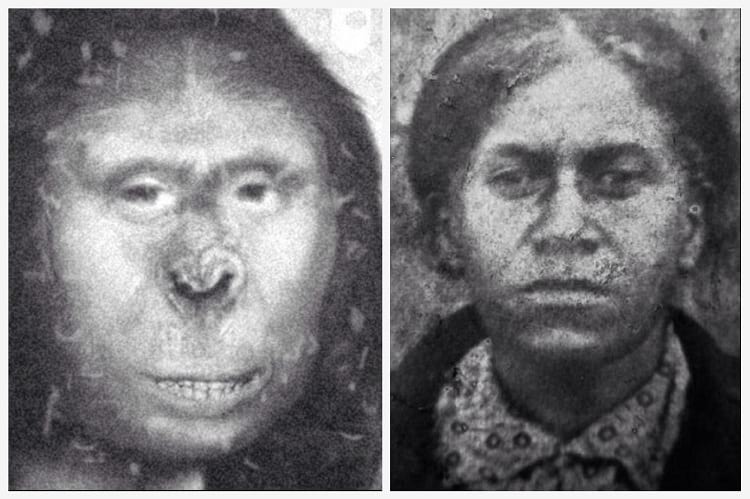
Artistic impressions of Zana (Left) and her daughter (Right).
In the latter half of the 19th century, the Ochamchiri region of Georgia in Russia, a group of local hunters found something beyond their expectations, which presented the world with an enigma for several years. They found a creature which looked like a human but didn’t appear to be one simultaneously. It gave the impression of a female human, but with ape-like features.
She had a terrifying face – a broad face with high cheekbones, a flat nose with turned out nostrils, muzzle-like jaws, broad mouth with large teeth, low forehead, and eyes with a reddish tinge. Her skin tone was dark greyish-black, and her whole body was covered with reddish-black hair. She had a very athletic body, with a tall, large build. She had muscular arms and legs, and fingers thicker than typical human fingers. Her expression was described to be purely animal. After the hunters captured her, she changed several hands and was finally bestowed upon a nobleman known as Edgi Genaba. She was taken to the village of Tkhina where his estate was located and sheltered her in a strong enclosure.
Taming the Zana Ape Woman
She was ferocious at first, as noticed by the villagers who were terrified of approaching her in her enclosure. Nobody ventured to give her food, it was thrown at her. Gradually, over a period of three years, they managed to tame her. She was then made free to wander about, but she never wandered too distant from the place where they regularly fed her.
The villagers started calling her Zana. She learned a few simple tasks from the villagers such as carrying wood or grinding corn. She obeyed her master, even when she was in a foul, angry mood. The villagers saw her incredible athletic capacity whenever she effortlessly lifted an 80 kg sack and carried to the village. It was said, that she could outrun a horse. She developed an affinity for grapes. She sometimes climbed trees to retrieve them.
She used to stray into the forest at night-time and rested in chilled pools of water on warmer days. Her aversion to heat meant that she preferred to walk naked, after tearing off any form of clothing meant to keep her warm, even during the harshest of winters. Perhaps the fascinating aspect of her life is the fact that she gave birth to descendants, which, as suggested by many, is a consequence of her wine addiction.
Giving birth
She would drink to unconsciousness and it appeared that few men took advantage of her situation. She would often give birth unassisted, and only after the death of a few babies did the villagers began taking care of the children as their own. Four of her children survived – two sons and two daughters. They grew up as humans and were completely normal except for a few physical features and mental traits. The youngest son, named Khwit, died in 1954.
Her offsprings were powerfully built and had quick temper. Zana herself is believed to have died in the 1890s. Several researchers have tried to find her remains in order to study them but unfortunately, they were never found. They have, however, succeeded to exhume the remains of her son, particularly his skull, from a well-indicated grave in the Tkhina village.
Scientific study and evidence
The results of a subsequent study were published in 1987 and said that the skull “exhibits an original combination of modern and ancient features,” and that it approaches closest to “the Neolithic Vovnigi II skulls of the fossil series.” In 2015, a professor at the Oxford University, Bryan Sykes, concluded the results of a DNA study on her living descendants and her son Khwit’s tooth that her DNA is “100 percent African” but did not resemble any known group.
He theorized that her predecessors migrated out of Africa 100,000 years ago and settled in the secluded Caucasus area for several generations. Conclusively, it can be said, that the story of Zana, the ape-woman who could outpace a horse, has greater substance than just a myth.
Enjoyed this article? Also, check out “‘Ape Woman’ Julia Pastrana: The Sad and Short Life of the Ugliest Woman in the World“.
Recommended Read:
The Nature of the Beast: The first genetic evidence on the survival of apemen, yeti, bigfoot and other mysterious creatures into modern times | By Bryan Sykes
Recommended Visit:
1. The Cryptozoology & Paranormal Museum | Mosby Ave, Littleton, USA
2. Bigfoot Discovery Museum | Felton, USA
3. Expedition Bigfoot (The Sasquatch Museum) | Cherry Log, USA
Fact Analysis:
STSTW Media strives to deliver accurate information through careful research. However, things can go wrong. If you find the above article inaccurate or biased, please let us know at [email protected].
RELATED
The post Is the Story of ‘Zana’ the Ape-Woman who could Outrun a Horse True? or a Myth? appeared first on .
]]>










